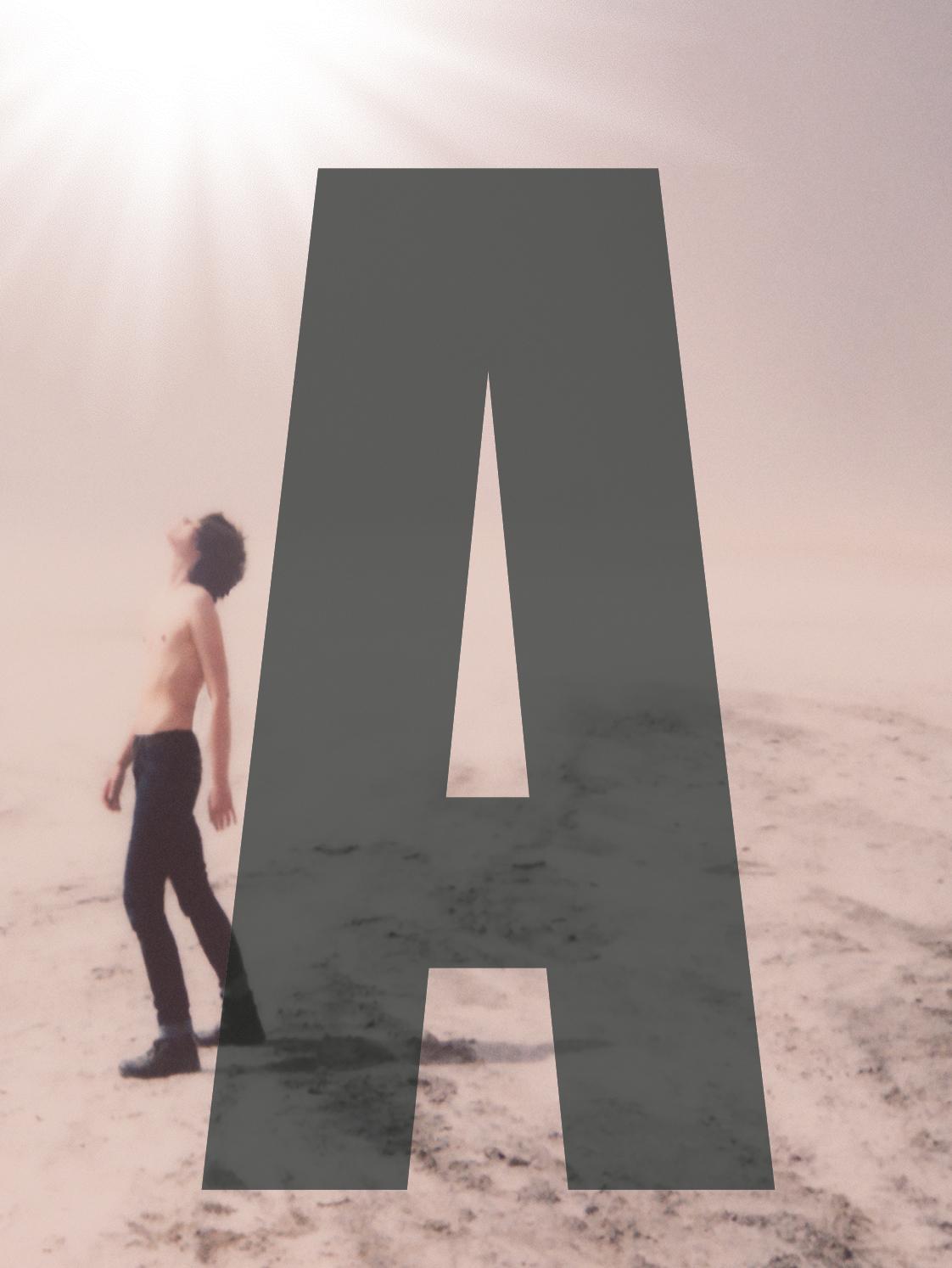

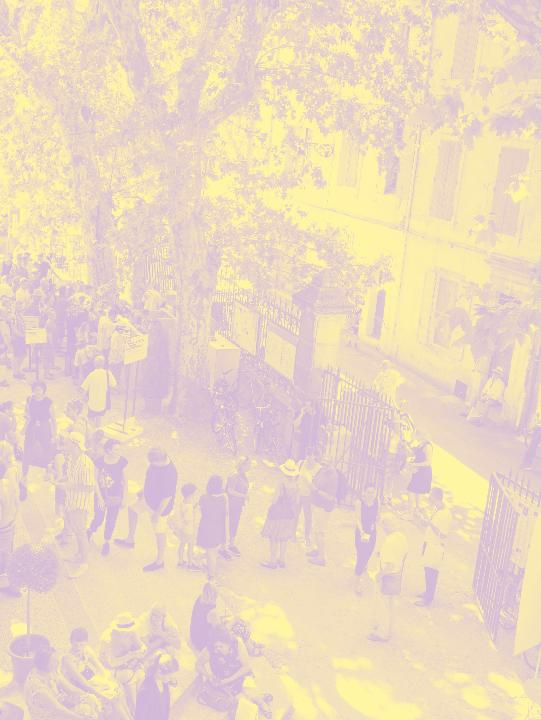
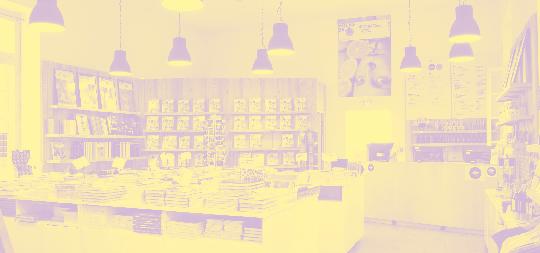
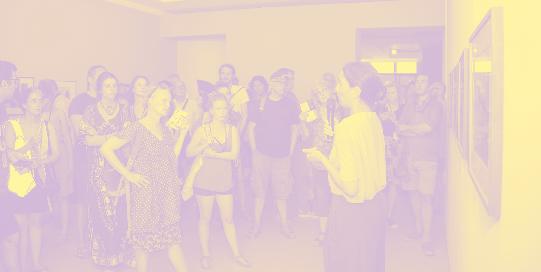

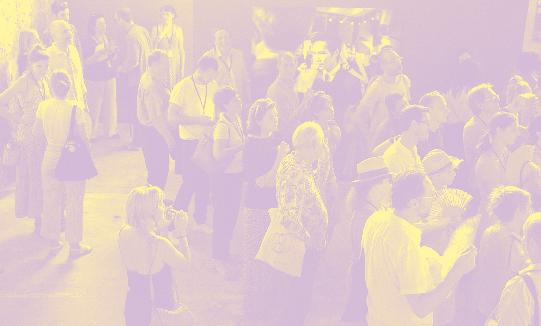

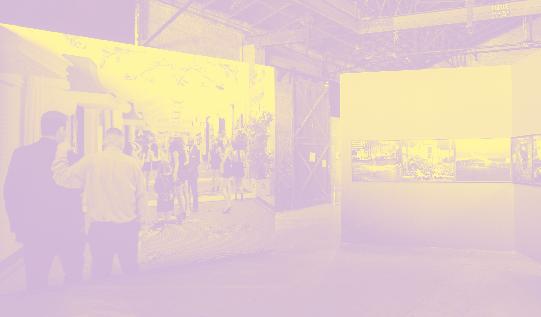












INSTITUTIONAL PARTNERS
MAIN PARTNERS
MEDIA PARTNERS
THE RENCONTRES D’ARLES IS ALSO ORGANIZED WITH SPECIAL SUPPORT FROM PRIX PICTET, FONDATION JAN MICHALSKI POUR L’ÉCRITURE ET LA LITTÉRATURE, LËT’Z ARLES (LUXEMBOURG), FONDATION LOUIS ROEDERER, TECTONA, ACTES SUD, DEVIALET, ADAGP, SAIF, FNAC, LUMA ARLES, COMMUNAUTÉ D’AGGLOMÉRATION ARLES CRAU CAMARGUE MONTAGNETTE.
SUPPORT FROM CONFÉDÉRATION SUISSE, ÉDITIONS LOUIS VUITTON, DUPON‑RC GROUP, PRO HELVETIA FONDATION SUISSE POUR LA CULTURE, FONDATION SWISS LIFE, MALONGO, CHAMMAS & MARCHETEAU, RIVEDROIT AVOCATS, HAHNEMÜHLE FINEART, VII ACADÉMIE, JEAN‑FRANÇOIS DUBOS, POLKA, FISHEYE, LIBÉRATION, VICE, AMA, BRITISH JOURNAL OF PHOTOGRAPHY, LOUIE MEDIA, FUJIFILM, MÉTROBUS, PICTO FOUNDATION, PROCESSUS, CIRCAD, DEUXIÈME ŒIL, ATELIER SHL & GAMBIER, ANITA SAXENA INTERPRÉTARIAT.
AND THE ACTIVE COLLABORATION OF BARBICAN CENTRE, APERTURE, INA, INSTITUT POUR LA PHOTOGRAPHIE, ÉCOLE NATIONALE SUPÉRIEURE DE LA PHOTOGRAPHIE, ASSOCIATION DU MÉJAN, MONOPRIX ARLES, MUSEON ARLATEN – MUSÉE DE PROVENCE, ABBAYE DE MONTMAJOUR, MUSÉE RÉATTU, MUSÉE DE LA CAMARGUE, FONDATION MANUEL RIVERA ORTIZ, CARRÉ D’ART – MUSÉE D’ART CONTEMPORAIN DE NÎMES, CARRÉ D’ART – BIBLIOTHÈQUE DE NÎMES, COLLECTION LAMBERT AVIGNON, FRAC PACA, MUCEM, CENTRE PHOTOGRAPHIQUE MARSEILLE, MUSÉE ESTRINE, CENTRE DE LA PHOTOGRAPHIE DE MOUGINS, ASSOCIATION JEAN VILAR.
P. 22
MASCULINITIES LIBERATION THROUGH PHOTOGRAPHY
P. 30
SÉBASTIEN LIFSHITZ SENSITIVE BOYS
P. 32
CLARISSE HAHN PRINCES OF THE STREETS
P. 38
DESIDERATION (ANAMANDA SÎN) FROM DISASTER TO DESIRE: TOWARDS ANOTHER SPACE MYTHOLOGY
P. 44
RETHINK EVERYTHING THE POWER OF ART IN TIMES OF ISOLATION
P. 52
THE NEW BLACK VANGUARD
PHOTOGRAPHY BETWEEN ART AND FASHION
P. 62
SIM CHI YIN ONE DAY WE’LL UNDERSTAND
P. 66
ALMUDENA ROMERO THE PIGMENT CHANGE
P. 70
LEBOGANG TLHAKO SIBADALA SIBANCANE
P. 74
ANYSSIA BIDOUT, EMMA RIVIERA & CÉDRINE SCHEIDIG SPECIAL ATTENTION
P. 78
LOUIS ROEDERER DISCOVERY AWARD 2021
THE THIRD LINE / HELENA ANRATHER FARAH AL QASIMI
GALERIE FRANK ELBAZ KETUTA ALEXIMESKHISHVILI
DISPLAY
MARIANA HAHN
MABA FONDATION DES ARTISTES ILANIT ILLOUZ
FOLKWANG UNIVERSITY OF THE ARTS JONAS KAMM
AS IS.LA GALLERY TARRAH KRAJNAK
FONDATION A STICHTING MASSAO MASCARO
WEBBER GALLERY ZORA J MURFF
THE PILL AYKAN SAFOĞLU
BERLINISCHE GALERIE – MUSEUM OF MODERN ART BERLIN ANDRZEJ STEINBACH
PRAGOVKA GALLERY MARIE TOMANOVA
P. 128
THAWRA! RÉVOLUTION! SUDAN: THE HISTORY OF AN UPRISING
P. 134
PIETER HUGO BEING PRESENT
P. 140
STÉPHAN GLADIEU
DEMOCRATIC PEOPLE’S REPUBLIC OF KOREA, PORTRAITS
P. 146
ANTON KUSTERS BLUE SKIES
P. 150
CHOW AND LIN THE POVERTY LINE
P. 154
AFRICA STATE OF MIND HYBRID CITIES
P. 160
ENRIQUE RAMÍREZ MIGRANT GARDENS
P. 166
CHARLOTTE PERRIAND HOW DO WE WANT TO LIVE? POLITICS OF PHOTOMONTAGE
P. 172
SABINE WEISS A PHOTOGRAPHER’S LIFE
P. 178
JAZZ POWER!
JAZZ MAGAZINE : TWENTY YEARS IN THE AVANT GARDE (1954–1974)
P. 182
ORIENT-EXPRESS & C ie BETWEEN HISTORY AND MYTHOLOGY
P. 186
P. 188
RAYMOND CAUCHETIER NEW WAVE
P. 194 NEUF FROM A TO Z DELPIRE BEFORE DELPIRE
P. 198 THE BOOK AWARDS
P. 199
LUMA RENCONTRES DUMMY BOOK AWARD 2021
P. 202
LËT’Z ARLES DANIEL REUTER LISA KOHL
P. 206
LES AILLEURS INCARNATIONS
P. 208
FONDATION
MANUEL RIVERA-ORTIZ SYSTEM ECHOES
P. 212
ASSOCIATION DU MÉJAN
JEAN LUC BERTINI
JEAN MICHEL ANDRÉ REEVE SCHUMACHER PAULINE FARGUE
MAGNUM AND STREET PHOTOGRAPHY
P. 222
MUSÉE DE LA CAMARGUE CECIL KA
P. 224
P. 226
AVIGNON, COLLECTION LAMBERT JÉRÔME TAUB
PURPLE AMERICA
ASSOCIATION
JEAN VILAR
STAGE LEFT
JEAN VILAR AND AVIGNON
MOUGINS LE CENTRE DE LA PHOTOGRAPHIE ISABEL MUÑOZ 1001
P. 227
MARSEILLE CENTRE PHOTOGRAPHIQUE CAMILLE FALLET FOR WHOM THE BELL TOLLS (GO)
MUCEM ILARIA TURBA YEARNING TO SEE FAR
FRAC PROVENCEALPES-CÔTE D’AZUR KATIA KAMELI SHE LIT THE FIRE OF THE PAST
CLARISSE HAHN LOS DESNUDOS
P. 228 NÎMES BIBLIOTHÈQUE CARRÉ D’ART MICHEL GLAIZE CONVERSATIONS WITH MUYBRIDGE
CARRÉ D’ART TARIK KISWANSON
MIRRORBODY
JEFF WEBER
P. 229
SAINT-RÉMY-DE-PROVENCE MUSÉE ESTRINE MICHEL SIMA
FRANÇOISE GILOT AND PABLO PICASSO THROUGH MICHEL SIMA’S LENS
P. 238
ARLES & C o .
ASSOCIATION DU MÉJAN
JEAN-PIERRE FORMICA
MUSÉE RÉATTU
GRAZIANO ARICI
DOROTHEA LANGE
P. 242
NIGHTS AND DAYS
WOMEN IN MOTION AWARD
P.250
PHOTOGRAPHY WORKSHOPS
IMAGE
EDUCATION
P. 256
TRAVELING EXHIBITIONS
JIMEI x ARLES
INTERNATIONAL PHOTO FESTIVAL SERENDIPITY ARLES GRANT
P. 262
PARTNERS
ACKNOWLEDGEMENTS
BOARD OF DIRECTORS TEAM
More than ever, we need to get together and celebrate culture. The 51st edition did not take place in 2020, a year without festivals. In 2021, we offer you the 52nd, a balance between key shows that could not be held last year and exciting new proposals. This is a transitional year between two directors: we welcomed Christoph Wiesner as the new head of the festival in September 2020.
It is important for us to be present in Arles’s increasingly rich cultural ecosystem. Much to our delight, culture is growing by leaps and bounds in the city. The opening of Luma, planned for this summer, which we welcome, is eagerly anticipated well beyond Arles.
The festival’s local and regional influence no longer needs demonstrating. The Grand Arles Express, in particular, is increasingly successful from year to year. In 2021, the Rencontres d’Arles will once again take place within a network of friendly institutions. Photography is once more highlighted and honored in the South of France. Even further afield, international cooperation remains on the agenda with the seventh Jimei x Arles International Photography Festival in November and a new collaboration with India’s Serendipity Arts Foundation that has led to the creation of a major grant for photography, video, and new media. The grant will enable a young Indian artist to develop their project and present it at the Rencontres d’Arles in 2022. Like every year, the Rencontres d’Arles is sharing the adventure with those who are out of work, thus playing a major social role in the Arles area.
I can assure you that the Rencontres team is delighted to welcome you this summer in Arles.
The Rencontres d’Arles wishes to thank the Ministry of Culture, the National Ministry of Education, Youth and Sports, the Provence‐Alpes‐Côte d’Azur Regional Council, the Bouches-du-Rhône Department, the City of Arles, and all our public partners who demonstrated their enduring support again this year.
For this year’s festival, the Rencontres d’Arles is pleased to be associated with large national and international institutions, such as the Barbican Centre in London, Aperture New York, the École Nationale Supérieure de la Photographie d’Arles, the Institut pour la Photographie de Lille, and to be included in the Africa2020 Season.
We would like to thank all our sponsors and private partners for their generosity and renewed trust, firstly the Luma Foundation, BMW Art & Culture, SNCF Gares & Connexions, Kering, Fondation Jan Michalski pour l’Ecriture et la Littérature, the Prix Pictet, Lët’z Arles (Luxembourg), the Louis Roederer Foundation, the Swiss Confederation, and many others, which space prevents us from listing.
We wish to underline the invaluable support delivered by our venue partners, in particular the City of Arles, the Arles Crau Camargue Montagnette metropolitan area, the Foundation Luma, but also the SNCF, Monoprix Arles, the Association du Méjan, and this year for the first time, the Museon Arlaten – Musée de Provence, which has opened its doors to us to inaugurate the Chapelle des Jésuites.
Finally, we are thrilled to confirm the support of our main media partners, who help promote the festival’s image to everyone: France Inter, ARTE, Konbini, LCI, Le Point, and Madame Figaro
Should we invent a new rite of passage for this very peculiar time? Retouch this blank year in technicolor? The urgency of the present calls for commitment above all—a commitment on the part of the Rencontres d’Arles to the photographers, artists, curators, partners, and institutions with which the festival has forged such strong ties for so many years. Far from imagining a tabula rasa tempting us to break away from the suspended time induced by the pandemic, it becomes about reflecting on how to update a heritage: that of last year’s festival, developed by Sam Stourdzé around the theme of resistance, and the photography that in his words, “stands up, opposes, denounces… re-enchants.” I wanted the program to be built around these premises, taking them further, with variations and echoes, new additions and derivations that allow us to grasp this force as well, the urgent need for the Rencontres d’Arles to gauge the pulse of the world. If the skies are not yet clear, if the light is still dim this summer, we must still make visible the multiplying bursts of light produced by the invited photographers and artists.
If Pier Paolo Pasolini understood how the tension produced by the fierce spotlights of power threaten the flashes of light from opposing powers, Georges Didi-Huberman offers hope in Survival of the Fireflies (2009). According to him, we must “recognize a resistance in the smallest firefly, a light for all thought.” Photography continues to emit light signals, opening up spaces for new methods of resistance. Arles in midsummer will be like a constellation of fireflies, made up of a thousand lights illuminating the diversity of visions, a polyphony of stories, and symbolizing the survival of hope and consciousness-raising by means of the image.
The sites chosen for this year’s festival offer a setting as varied as its atmosphere, in keeping with the program’s diversity. They take place at heritage, historical sites downtown, at Atelier de la Mécanique in Parc des Ateliers, at Monoprix and Croisière, and even in several city gardens.
In the Église des Frères Prêcheurs in the center of Arles, Emergences takes up residence this year with the Louis Roederer Discovery Award in a new format. From now on, each year, a curator will express their vision of trends in young contemporary art. The year 2021 was entrusted to Sonia Voss, whose innovative design concept puts the projects into dialogue with one other.
A walk through the modernist building housing the supermarket Monoprix leads to a universe where identity and fluidity come together. SMITH’s Desideration is a multisensory exploration at the crossroads of different practices, in which photography, narration, fiction, and form become one; it is a voyage to a poetic cosmos, asking each of us the essential question of our existence beyond gender and beyond bounds. Also, as the pandemic leads us to question the limits of humanity, Rethink Everything introduces us to a Latin American scene with a feminist practice probing the body as well as society in all its aspects. The question of representation is also addressed with the exhibition The New Black Vanguard, which celebrates the black body in all its diversity, striding the disciplines of art, fashion and culture. These multiple viewpoints on the world find an echo in Pieter Hugo’s introspective Being Present. A focus on the portrait brings us to many places on earth, but asks us to take the perspective of the other. And turning toward the other, to distant horizons, is also what the Atlas section
offers. Here again, we’re invited to travel, and to look at a map covering geography, history, sociology, and psychology. So, we’ll find perspectives from South Africa, but also from Sudan and Chile, to move us across the globe.
The Rencontres is also about revisiting the history of the medium of photography and its players. Thus, through the opening of Charlotte Perriand’s archives we discover how photography and photomontage played a decisive role in her creative process, both in her aesthetic development and political involvement in the 1930s. Then we must mention Sabine Weiss, who turns ninety-seven this year. Her work will be shown at the Chapelle des Jésuites of the Museon Arlaten, a brand-new venue for the Rencontres.
These are just the first flashes offered by the festival this summer. Along with the Rencontres’s executive director, Aurélie de Lanlay, and the entire team, we invite you to discover the rest of the program opening July, 4 in Arles.
Born 1973 in Paris, France. Lives and works in Paris.
Juliette Agnel is unrivaled on the French photography scene. Using an overarching philosophical approach, she tasks herself with understanding the world. This investigation takes her from the skies, stirred by the connection between the universe and terrestrial forces, to the earth, through geobiology and the mystical experiences that the doors of nature open onto; today, her work takes her to the subterranean, exploring prehistoric caves. Agnel photographs the invisible, and through her work, tries to convey the register of feeling and interiority of her subject. There is no photographic truth in her images, the most concrete example of this is the calm that they emanate: they are time machines that carry a manifestly ecological footprint. The artist is represented by Galerie Françoise Paviot.
EXHIBITION: THAWRA! REVOLUTION !
SUDAN: THE HISTORY OF AN UPRISING – P. 128
Born 1955 in Michigan, United States
Lives and works in Paris, France.
Stuart Alexander is editor-in-chief at delpire & co. In his early career, he worked for numerous museums, among them the Center for Creative Photography, which published his book Robert Frank: A Bibliography, Filmography and Exhibition Chronology 1946–1985 (1986). He worked as archivist at Estate Brassaï, and participated in many exhibition and publishing projects, several with Robert Delpire at the Centre National de la Photographie. He has organized many exhibitions in collaboration with editors, collectors, and museums around the world. From 2005 to 2015, he served as vice-president and photography specialist at Christie’s, New York, and is on the board of directors at Fondation Josef Koudelka.

EXHIBITION: NEUF FROM A TO Z: DELPIRE BEFORE DELPIRE – P. 194
Born 1968 in Bilbao, Spain. Lives and works in London, United Kingdom.
Monica Allende is an independent curator, artistic director, consultant, and educator. She is the curator of the multidisciplinary Blues Skies Project, with artists Anton Kusters and Ruben Samama, recently shortlisted for the Deutsche Börse Photography Foundation Prize. She was Getxophoto International Image Festival artistic director from 2017 to 2019, and is now the artistic director of Landskrona Foto Festival. She has also collaborated with WeTransfer as a consultant and creative producer, as well as the director of FORMAT 17 International Photography Festival.

EXHIBITION: ANTON KUSTERS, BLUE SKIES – P. 146
Born 1984 in Montpellier, France. Lives and works in Paris, France.
A photography historian with a PhD in art history, Damarice Amao co-curated the exhibitions

Eli Lotar (Jeu de Paume, 2017), Photography, as a Weapon of Class (Centre Pompidou, 2018), and Dora Maar (2019). Today, she is a curator in the photography department of the Musée Nationale d’Art Moderne – Centre Pompidou.
EXHIBITION: CHARLOTTE PERRIAND, HOW DO WE WANT TO LIVE? POLITICS OF PHOTOMONTAGE – P. 166

Born in Italy. Lives and works in Cape Town, South Africa.
After graduating in Political Sciences, Federica Angelucci worked for Peliti Associati, Milan, and Magnum Photos, Paris. She is currently a senior partner at Stevenson, a gallery with spaces in Cape Town, Johannesburg, and Amsterdam. Since joining Stevenson in 2007, her focus has been on the gallery’s photographic program, and the production of monographs and solo exhibitions for the photographic artists represented: Edson Chagas, Pieter Hugo, Zanele Muholi, Mame-Diarra Niang, Jo Ractliffe, Viviane Sassen, and Guy Tillim. Recent projects include Photographs: 1980s to Now by Jo Ractliffe, La Cucaracha by Pieter Hugo, Venus and Mercury by Viviane Sassen, and Somnyama Ngonyama by Zanele Muholi.
EXHIBITION: PIETER HUGO, BEING PRESENT – P. 134
Born 1989 in Marseille, France. Lives and works in Paris, France.
After earning degrees in political science and visual studies, Clara Bastid founded Profession Photographie and hosted regular discussions about the photography market at INHA. She worked at the Fondation Cartier and Luma Arles before helping to diversify activities within the Le Monde group. Today she is head of development at the Gaîté Lyrique, and has created [AFK], a think tank dedicated to the new generation.
EXHIBITION: JAZZ POWER! JAZZ MAGAZINE : TWENTY YEARS IN THE AVANT-GARDE (1954–1974) – P. 178


Born in Paris, France. Lives and works in Paris, France.
Virginie Chardin is a freelance curator focusing on the history of photography. She has curated the exhibitions Willy Ronis in Paris and Paris in Color, from the Lumière Brothers to Martin Parr at the Hôtel de Ville de Paris; Images of a Capital at the Museum Folkwang in Essen; Denis Darzacq at the Pavillon Carré de Baudoin; Pierre de Fenoÿl, an Imaginary Geography and Sabine Weiss at the Jeu de Paume-Château de Tours; and Antonin Personnaz at the Musée des Beaux Arts de Rouen. She has been a project leader at the Musée Nicéphore-Niépce, head of the Rencontres d’Arles awards, and delegate for Paris Photography Month. She wrote the photo-pocketbooks Séeberger Frères, Ernst Haas, and Sabine Weiss
EXHIBITION: SABINE WEISS, A PHOTOGRAPHER’S LIFE– P. 172

Born 1954 in Belfort, France. Lives and works in Chalon-sur-Saône, France.

Trained in history and ethnology, François Cheval has been a museum curator since 1982. From 1996 to 2016, he was head of the Musée Nicéphore Niépce in Chalon-surSaône, where he dusted off old assumptions about photography and presented its originality through the design of exhibitions and fresh discourse. Today, he is an artistic director and exhibition curator aiming to challenge the certitudes of photography and its milieu by creating challenging moments of discovery and, perhaps, pleasure. He has been artistic director of the BMW artist-in-residence program since its creation in 2011.
EXHIBITION: ALMUDENA ROMERO, THE PIGMENT CHANGE – P. 66
Born 1968 in London, United Kingdom. Lives and works in London.
Ekow Eshun is a writer, critic, and curator. He is Chairman of the Fourth Plinth Commissioning Group and the former Director of the ICA, London. He is the author of Africa State of Mind (Thames & Hudson), Black Gold of the Sun (Penguin), nominated for the Orwell prize, and editor of Africa Modern (KT Wong). He has contributed to several books including Masculinities (Barbican), Between Worlds (National Portrait Gallery), Linda McCartney: The Polaroid Diaries (Taschen), as well as to catalogues on the work of Duro Olowu, Chris Ofili, Kehinde Wiley, Wangechi Mutu, and John Akomfrah.
EXHIBITION: AFRICA STATE OF MIND: HYBRID CITIES – P. 154


Born in Paris, France. Lives and works in Paris.
Julien Frydman is a publisher. He has been directing the bookstore and publishing house delpire & co in Saint-Germain-des-Prés since 2020. He directed six editions of Paris Photo, from 2011 to 2014, at the Grand-Palais in Paris and at Paramount Studios in Los Angeles, launching numerous exhibitions and publications for the events. He also worked at the Magnum agency for around ten years, serving as director from 2006 to 2010.
EXHIBITION: NEUF FROM A TO Z, DELPIRE BEFORE DELPIRE – P. 194
Born 1960 in Buenos Aires, Argentina. Lives and works in Buenos Aires.
Andrea Giunta is a writer, curator, and professor at the University of Buenos Aires, where she obtained her doctorate. She is a principal researcher at CONICET (Argentina) and visiting researcher at the University of Texas (USA). She was awarded the Guggenheim, Rockefeller, Getty, Harrington, and Tinker scholarships, and the Konex Prize, among others. She is the author of several books on Latin American art. She was co-curator of Extranjerías, MUAC (2012); Verboamérica, MALBA (2016); Radical Women: Latin American Art, 1960–1985, Hammer Museum, Brooklyn Museum and Pinacoteca de São Paulo (2017–2018); and chief curator of the 12th Mercosur Biennial, Porto Alegre (2020), among other exhibitions.
EXHIBITION: RETHINK EVERYTHING: THE POWER OF ART IN TIMES OF ISOLATION – P. 44
Born 1985 in Paris, France. Lives and works in Berlin, Germany.
Éva Gravayat graduated from the Université Paris 1 PanthéonSorbonne with a master’s degree in exhibition science and technology. She was production manager at the Rencontres d’Arles (2007–2011) before moving to Berlin in 2012. In Germany, she was the correspondent for L’Œil de la Photographie, deputy director of the Fotobookfestival Kassel (2014–2018), and responsible for developing the Regard Collection and the Hein Gorny Estate in Berlin. In 2017, she co-founded thephotoexhibitionarchive. com, a collection of exhibition views for students, artists, and curators

EXHIBITION: ORIENT-EXPRESS & C ie : BETWEEN HISTORY AND MYTHOLOGY – P. 182

Born 1977 in Singapore. Lives and works in Cambodia and Singapore.
Sam I-Shan is a curator with an interest in time-based media, photography, and the intersection of art and politics. With fifteen years’ experience in art institutional settings, she was previously curator at the National Gallery Singapore, Singapore Art Museum, and Esplanade Visual Arts. Her monographic, research-focused exhibitions include the Ng Teng Fong Roof Garden Commission: Cao Fei; Georgette Chen: At Home in the World, and Afterimage: Contemporary Photography in Southeast Asia. She also headed film and moving image initiatives there, specializing in artist films, and co-programming the annual Southeast Asian Film Festival.

EXHIBITION: SIM CHI YIN, ONE DAY, WE’LL UNDERSTAND – P. 62
Born 1985 in Besançon, France. Lives and works in Ivry-sur-Seine, France

For several years, Arthur Mettetal, a historian focusing on economic history and industrial heritage, has been interested in the material and intangible traces of industry and has used photography in all his projects. After exploring memory within the Metaleurop plant in 2011, he worked on a project involving the role of factory smokestacks in northern France’s urban and rural landscapes in 2015. He has co-curated several documentary exhibitions, including Usine des mémoires and Signal industriel, and is currently the administrator-director of the Orient Express Heritage Endowment Fund while at the same time working on a thesis at the Centre de Recherches Historiques of the EHESS.
EXHIBITION: ORIENT-EXPRESS & C ie : BETWEEN HISTORY AND MYTHOLOGY – P. 182
Born 1988 in Johannesburg, South Africa. Lives and works in Johannesburg.
In 2012, Fulufhelo Mobadi graduated from the Photojournalism and Documentary Photography Programme at the Market Photo Workshop in Johannesburg. Her photographic practice focuses on the day-to-day struggles of women within contemporary South Africa and more broadly, the African continent. As a socially engaged photographer, she is motivated by making the unspoken and the hidden visible. Mobadi currently works as the Coordinator for Courses and Training at the Market Photo Workshop.

EXHIBITION: LEBOGANG TLHAKO, SIBADALA SIBANCANE – P. 70
Born 1993 in Omdurman, Sudan. Lives and works in Bahri, Sudan.

Being quite quiet, Duha Mohammed first discovered her love for photography when she realized that she’d rather show you than tell you. Duha is an industrial designer who finds solace in visual arts and thinks practicing it is a journey of life and self-exploration. She was first introduced to narrative and storytelling photography in 2014, when she participated in Mugran Foto Academy—a workshop organized by Goethe Institute Sudan—and she has been hooked ever since.
EXHIBITION: THAWRA! REVOLUTION! SUDAN: THE HISTORY OF AN UPRISING, – P. 128
Born 1974 in London, United Kingdom. Lives and works in London.

Alona Pardo has been a curator at Barbican Art Gallery in London for nearly fifteen years. With a focus on photography and film, she has curated and edited numerous exhibitions and publications, including most recently Masculinities: Liberation through Photography (2020); Trevor Paglen: From Apple to Anomaly (2019); Dorothea Lange: Politics of Seeing (2018); Vanessa Winship: And Time Folds (2018); Another Kind of Life: Photography on the Margins (2018); Richard Mosse: Incoming (2017), and Strange and Familiar: Britain as seen by International Photographers (with Martin Parr, 2016). She has contributed widely to art magazines and books, including Modern Forms: A Subjective Atlas of 20th-Century Architecture by the contemporary photographer Nicolas Grospierre (Prestel, 2016) and Vitamin P3: New Perspectives in Painting (Phaidon, 2016). She has a particular interest in work that exists in the intersection between activism, aesthetics, and identity.
EXHIBITION: MASCULINITIES: LIBERATION THROUGH PHOTOGRAPHY – P. 22

Born 1974 in Lyon, France. Lives and works in Paris, France.
Marie Robert is head curator of photography at the Musée d’Orsay. She has organized some ten exhibitions of the collection focused on the social sciences and co-curated the shows Misia, Reine de Paris, Splendeurs et Misères. Images de la prostitution, and Qui a peur des femmes photographes ? With Luce Lebart, in 2020 she co-edited Une histoire mondiale des femmes photographes at Éditions Textuel. Her current research is on the intersecting relationships between photography and other media. After reintroducing early cinema into the museum’s permanent collection in 2019, she is preparing, with Dominique Païni and Paul Perrin, Vivement le cinéma !, an exhibition that will open in September 2021.

EXHIBITION: JAZZ POWER! JAZZ MAGAZINE
TWENTY YEARS IN THE AVANT-GARDE (1954–1974) – P. 178
Born 1988, Chicago, United States Lives and works in New York, United States.
Antwaun Sargent is a writer, editor, and curator. His writing has appeared in the New York Times, The New Yorker, and various art and museum publications. Sargent is author of The New Black Vanguard: Photography between Art and Fashion (Aperture, 2019) and editor of Young, Gifted and Black: A New Generation of Artists (2020). He is also a director at Gagosian Gallery.

EXHIBITION: THE NEW BLACK VANGUARD: PHOTOGRAPHY BETWEEN ART AND FASHION – P. 52
Born 1973 in Paris, France. Lives and works in Rome, Italy.
Sam Stourdzé focuses on contemporary photography and the relationships between art, photography and film. He has curated many exhibitions and written several reference works. In 2007, he was a resident in the cinema section at the French Academy in Rome-Villa Medici. Sam Stourdzé was director of the Musée de l’Élysée in Lausanne, Switzerland from 2010 to 2014, and editor-in-chief at the photography magazine ELSE before heading the Rencontres d’Arles from 2014 to 2020, when he was appointed director of the French Academy in Rome-Villa Medici. His project focuses on the idea of artistic, social and European mobility.
EXHIBITION: RAYMOND CAUCHETIER, NEW WAVE – P. 188
Born 1978, Paris, France. Lives and works in Paris and Berlin, Germany.
Sonia Voss is an author and curator. Her exhibitions include: Isabelle

Le Minh : Cristal réel (Goethe Institut Paris and Alfred Ehrhardt Foundation Berlin, 2020); Restless Bodies: East-German Photography 1980–1989 (Rencontres d’Arles, 2019); Alfred Ehrhardt: The Forms of Nature (Kyotographie, 2019); and two exhibitions at the Musée de la Chasse et de la Nature in Paris: Sophie Calle, Serena Carone : Beau doublé, Monsieur le marquis! (2018), and George Shiras: The Interior of the Night (2017). She also presented New Discovery Award nominee Anton Roland Laub (Mobile Churches) in 2018. She is the editor of publications at Éditions Xavier Barral, Koenig Books, Filigranes, and Kehrer.
EXHIBITION: LOUIS ROEDERER DISCOVERY AWARD 2021 – P. 78

Bas Jan Ader (1945–1975), Laurie Anderson (1947), Kenneth Anger (1927), Knut Åsdam (1968), Richard Avedon (1923–2004), Aneta Bartos, Richard Billingham (1970), Cassils (1975), Sam Contis (1982), John Coplans (1920–2003), Rineke Dijkstra (1959), George Dureau (1930–2014), Thomas Dworzak (1972 Hans Eijkelboom (1949), Fouad Elkoury (1952), Rotimi Fani-Kayode (1955–1989), Hal Fischer (1950), Samuel Fosso (1962), Anna Fox (1961), Masahisa Fukase (1934–2012), Sunil Gupta (1953), Peter Hujar (1934–1987), Liz Johnson Artur (1964), Isaac Julien (1960), Kiluanji Kia Henda (1979), Karen Knorr (1954), Deana Lawson (1979), Hilary Lloyd (1964), Robert Mapplethorpe (1946–1989), Peter Marlow (1952–2016), Ana Mendieta (1948–1985), Annette Messager (1943), Duane Michals (1932), Tracey Moffatt (1960), Andrew Moisey (1979), Richard Mosse (1980), Adi Nes (1966), Catherine Opie (1961), Elle Pérez (1989), Herb Ritts (1952–2002), Kalen Na’il Roach (1992), Collier Schorr (1963), Paul Mpagi Sepuya (1982), Clare Strand (1973), Mikhael Subotzky (1981), Larry Sultan (1946–2009), Hank Willis Thomas (1976), Wolfgang Tillmans (1968), Piotr Ukla ński (1968), Karlheinz Weinberger (1921–2006), Marianne Wex (1937–2020), David Wojnarowicz (1954–1992), Akram Zaatari (1966)
Masculinities: Liberation through Photography explores the many ways masculinity has been experienced, performed, coded, and socially constructed, as expressed and documented in photography and film from the 1960s to the present day.
Simone de Beauvoir’s famous declaration that “one is not born, but rather becomes, a woman” provides a helpful springboard for considering what it means to be a male in today’s world, as well as the place of photography and film in shaping masculinity. What we have thought of as “masculine” has changed considerably throughout history and within different cultures. The traditional social dominance of the male has determined a gender hierarchy that continues to underpin societies around the world.
In Europe and North America, the characteristics and power dynamics of the dominant masculine figure—historically defined by physical size and strength, assertiveness and aggression— though still pervasive today, began to be challenged and transformed in the 1960s. Amid a climate of sexual revolution, the struggle for civil rights and raised class consciousness, the growth of the gay rights movement, the period’s counterculture and opposition to the Vietnam War, large sections of society argued for a loosening of the straitjacket of narrow gender definitions.
Set against the backdrop of the #MeToo movement, when manhood is under increasing scrutiny and terms such as “toxic” and “fragile” masculinity fill endless column inches, an investigation of this expansive subject is particularly timely, especially given current global politics characterized by male world leaders shaping their image as “strong” men.
Touching on queer identity, racial politics, power, and patriarchy, the perception of men by women, heteronormative stereotypes, hegemonic masculinity, and the family, the works in the exhibition present masculinity as an unfixed performative identity shaped by cultural and social forces. Embracing the idea of multiple “masculinities” and rejecting the notion of a singular “ideal man,” the exhibition argues for an understanding of masculinity liberated from societal expectations and gender norms.
Following pages
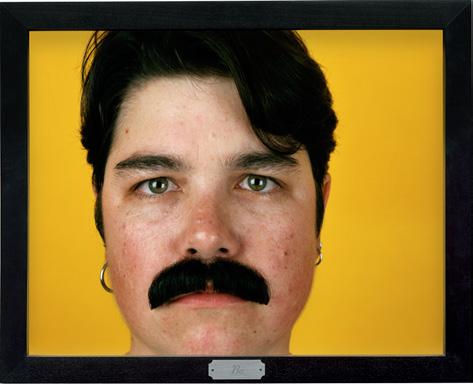

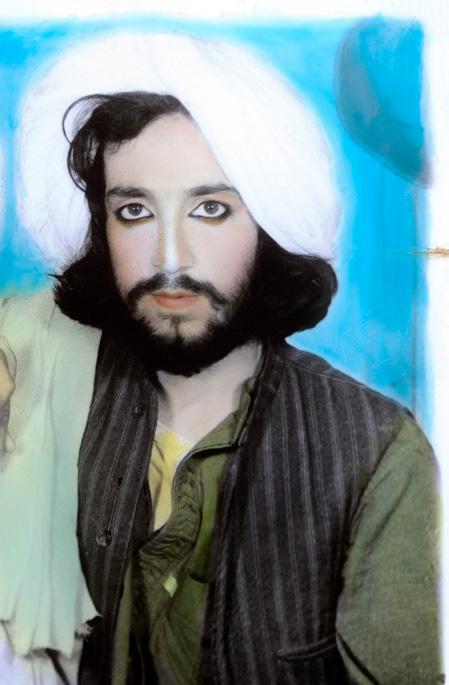
Masahisa Fukase, Upper row, from left to right: A, a model; Toshiteru, Suzeko, Masahisa. Middle row, from left to right: Akiko, Mitsue, Hisashi Daikoji. Bottom row, from left to right: Gaku, Kyoko, Kanako, and a memorial portrait of Miyako, 1985, from the Family series, 1971–1990. Masahisa Fukase Archives.


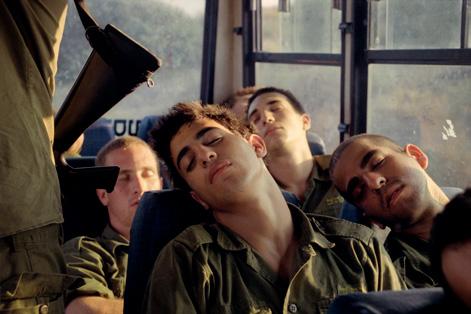

Born 1968 in Paris, France. Lives and works in Paris.

After studying art history at the École du Louvre, Sébastien Lifshitz became interested in cinema, directing his first feature film, Presque Rien, in 2000. Next came the documentary La Traversée (2001), selected for The Directors’ Fortnight, then Wild Side (2004) and Bambi (2016), which won prizes at the Berlin Film Festival. Following Les Invisibles (2012), an official selection for the Cannes Film Festival and Les Vies de Thérèse (2017) selected for The Directors’ Fortnight, he directed two documentaries: Adolescentes, which won a prize at the Locarno International Film Festival, the Louis-Delluc Prize for Best Film, and proud winner of three César Awards in 2021, then Petite Fille, shown at the 2020 Berlin Film Festival. Lifshitz also served as curator for the exhibitions Sincerely Queer (2016) at the Rencontres d’Arles and L’Inventaire Infini (2019) at the Centre Pompidou.
Until the end of the 1960s, French television was entirely devoid of any representation, or even mention, of homosexuality. It was not until the early 1970s that a broadcast on homosexuality was aired for the first time and the word was finally pronounced.
Of course, invisibility is not the whole story. Despite television censorship, homosexuality slipped through. Though these rare moments were codified and full of innuendo, expressed through the words of a famous figure (writer, painter, actor), or via popular musicians or burlesque sketches, and often homophobic, they nevertheless revealed a certain perspective on homosexuality. While, some topics, like antiquity or reports on the army, could clearly depict homoeroticism.
Gathered together here, Sensitive Boys puts these records into conversation to tell the story of resistance from a not-so-distant time when homosexuality had no place.
Top
Perm for men, Actualités françaises, 1953.
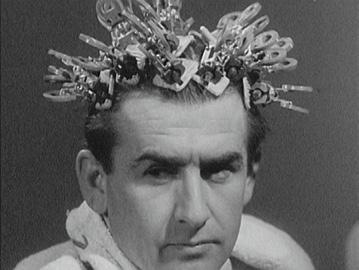
Center left
Underwear, Dim Dam Dom, 1968.
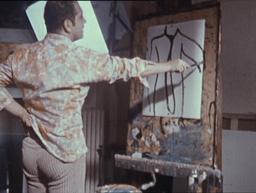

Center right
Medical program about homosexuality, 1973.
Bottom
Most beautiful athlete contest, Actualités françaises, 1946.

Born 1973 in Paris, France
Lives and works in Paris
Clarisse Hahn is a director and artist. Through film, photography, and video installation, she carries out research on communities such as the bourgeois Protestant community, the Kurdish community, actors in pornographic films, the S&M community, and hospital workers. She teaches at the École Nationale Supérieure des Arts Décoratifs de Paris. She has published as an art critic in the reviews art press, Omnibus, and Bloc-Notes, and has shown her work at the Musée d’Art Moderne de Paris; Mamco, Geneva; Reina Sophia, Madrid; Palais de Tokyo and Centre Georges Pompidou, Paris; and Museo de Arte Raùl Anguiano, Guadalajara, among others.
A working-class neighborhood in Paris, its market, trafficking, and kebabs, bodies intersecting, sometimes presenting. Money flows at the rate of glances. Cigarette vendors reign beneath the metro overpass at Barbès. They are champions of observation; nothing escapes their notice. The series Princes of the Streets is part of Hahn’s work-in-progress Boyzone, a project analyzing moments in which men’s bodies choreograph their relationship to public and private space.
Bodies and looks: Hahn’s film and photography on communities and rituals goes beyond the subject’s consenting to be viewed, showing how social beings make use of the gaze we turn toward them in order to express themselves: let yourself be seen without being had.
Hahn is not an ethnographer, she’s an artist; she’s a documentary filmmaker as it’s the best-suited term, but her attitude bears no egotism: keeping close to each body, she disappears, leaving the body space to express its force, fragility, pain, and history.

By including archival photos, Hahn creates a desynchronization that allows invisible genealogies to come forward. These young men are descendants of French heroes recruited during the colonial period. Whether irony or historical strategy, here, hero and antihero are one. Barbès, the Cour des Miracles, takes in both elderly and outsider, but the wounds of the marginalized are difficult to heal—memory scars just like flesh.
Many cultures of the world harbor Boyzones. Expressing joy, incarcerated, devoted, in protest, surviving, or toiling, these men speak the language of their anatomy. A litany of versatile and blunt attitudes parade the streets as Hahn analyzes “men among themselves.” Her experience with documentary helps her deploy this invisible presence. Men looking are being looked at, the male body eroticized. The male gaze dissipates in the cold of the morning. Snow fell on Barbès last winter. It also fell on Algiers.
Michel Poivert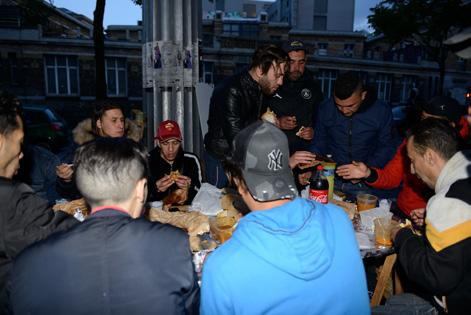
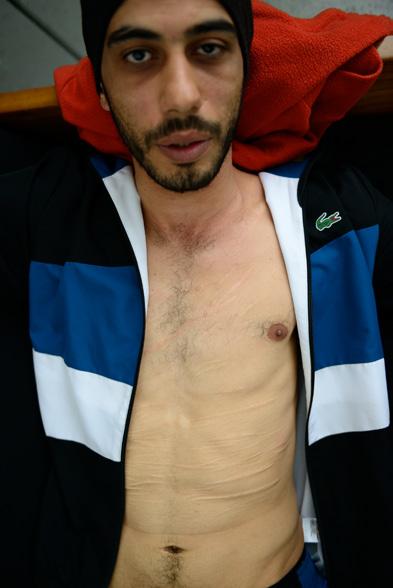

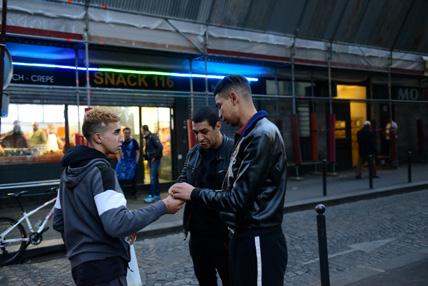
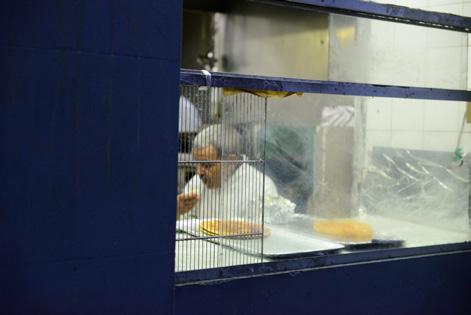
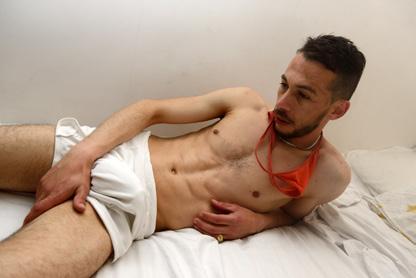

Desideration: Polycephaly
SMITH, photographer, visual artist, director, and researcher, explores metamorphosis in thought and in practice: transitions of gender, epoch and state, plasticity, hybridity, mutation, and dream work mark their proposals starting with Löyly, their first exhibition at the Rencontres d’Arles in 2012. SMITH perceives the cosmic porosity of human identity in Desideration, imagined in 2017 with astrophysicist Jean-Philippe Uzan, writer Lucien Raphmaj, and spatial installation by designer Diplomates. At present, the work hybridizes interventions by composer Gaspar Claus, performers Nadège Piton, François Chaignaud and Adrian Gebhart, textile artist Zélia Smith and curator Anna Milone—in the form a blob extending in every direction of the imagination
Testing the permeability of artistic, scientific, philosophical, and speculative narrative practices, this exhibition offers another mythology of space, imagining an interstellar human race searching for new alliances with its native cosmos.
“Desideration” plays on its cloudy etymology, fluctuating between regret for the lost stars (de-sideris) and a desire (désir) for their return. In the face of contemporary disaster, desideration proposes a diagnosis and a remedy. The simple fact of having lost a daily relationship to the starry sky reveals the material and spiritual destruction of our societies and invites us to express a new configuration of the imagination, a dream zone where new mythologies peopled by hybrid figures come together to make a new pact with the cosmos.
Among the figures of desire and desideration in this new mythology is Anamanda Sîn. The character embodies and expresses the terrestrial call to the celestial world of Levania. The exhibition is conceived as an immersion in Anamanda Sîn’s psyche and sensibility, where meteorites link past and future, earth and sky, art and science, nonhuman and human, melancholy and desire. The visitor thus wanders through a space structured by futurist ruins, mysterious reliefs from the interior of Anamanda’s ship, under the magnetic poles of their personal experience. Received radio signals broadcast snippets of a sinuous story, a collision with portions of meteorites, a motionless voyage of impact craters, the feeling of a shamanic migraine, contemplating anamorphosis, sharing collective slumber, records of an endocosmological laboratory.
The interstitial spaces of Monoprix harbor this permeable, fragmented mythology, like sketches of a transitional passage toward what is beyond us.
A project led by SMITH, Diplomats, and Lucien Raphmaj. With François Chaignaud, Gaspar Claus, Nadège Piton, Zélia Smith, Anna Milone, Adrian Gebhart, etc.

Publication
Désidération (Anamanda Sîn), SMITH and Lucien Raphmaj, Éditions Textuel, 2021.
Prints Picto, Paris.
With support from Picto Foundation and Galerie Les Filles du Calvaire, Paris.
See the extension of the Desideration (Anamanda Sîn) exhibition at Avignon TGV station, with support from SNCF Gares & Connexions.
Exhibition venue Monoprix.

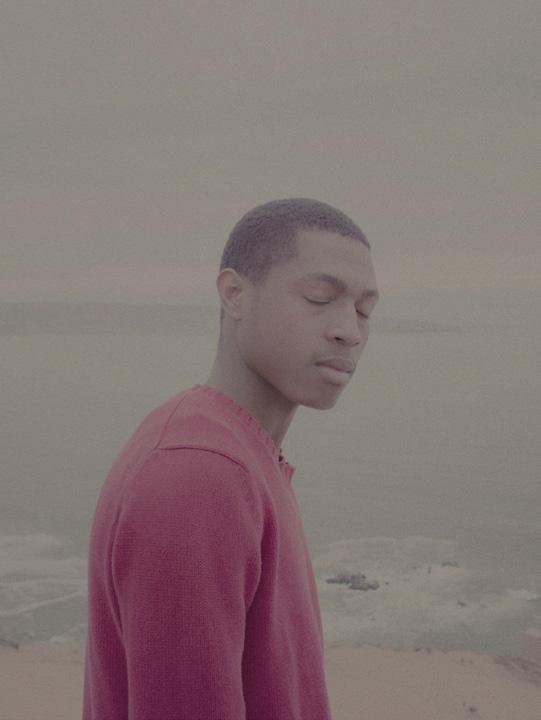

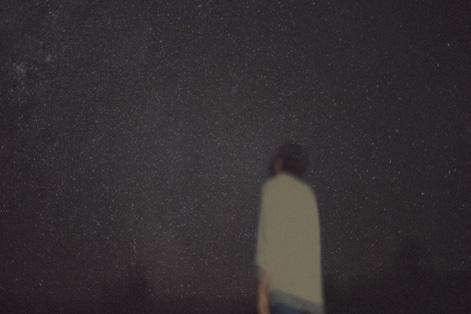
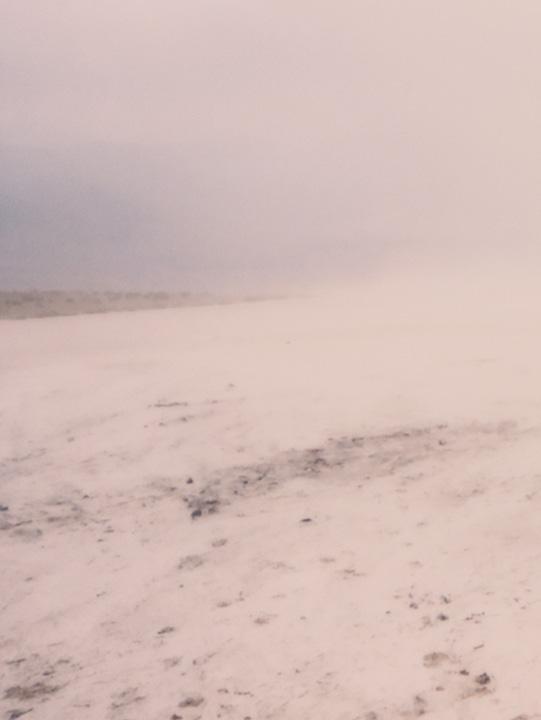
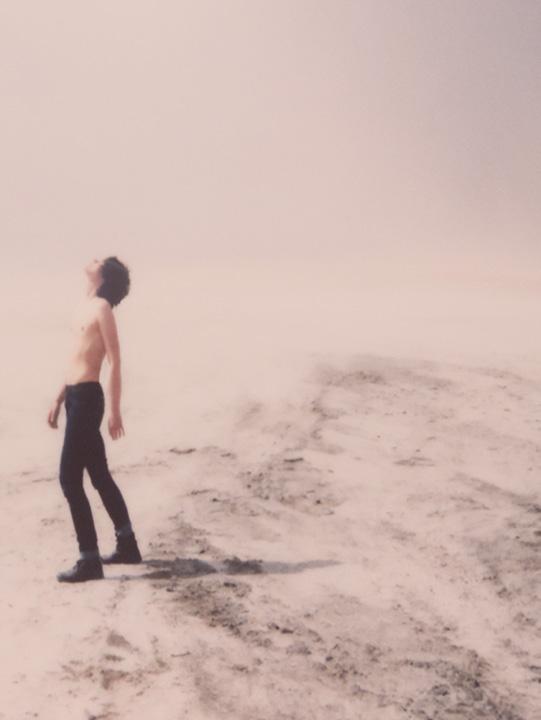
María José Arjona (1973), Ananké Asseff (1971), Colectivo Nosotras Proponemos (2017), Nicola Costantino (1964), Milagros de La Torre (1965), Vivian Galban (1969), María Teresa Hincapié (1956–2008), Adriana Lestido (1955), Florencia Levy (1979), Marcos López (1958), Liliana Maresca (1951–1994), Joiri Minaya (1990), Marta Minujín (1943), Aline Motta (1974), Rodrigo Orrantia (1975), Jackie Parisier (1968), Cristina Piffer (1953), Santiago Porter (1971), Dalila Puzzovio (1942), José Alejandro Restrepo (1959), Silvia Rivas (1957), Celeste Rojas Mugica (1987), Graciela Sacco (1956–2017), Juan Travnik (1950)
Here and now, we are traversing an unrepresentable pandemic time. An exceptional state that has ignited imageries related to life and death. Strange times, testing the very concept of humanity. Solidarity, empathy, respect for our own emotional echoes, and those of others. These are days in which reason and the administration of time and resources foster sensitive and flexible strategies.
We can rethink everything. Starting from an experience that intervenes with affection and the desire for a new distribution of human relationships, of symbolic relationships, of relationships with the animal and with nature. When species meet, in the words of Donna Haraway. Feminism is a rhizomatic theory and practice that also addresses questions of the posthuman and production of the common. A theory of affection and the body, of the public affair, the transformation of social relationships, and of the home as an observatory for the analysis of a new economic policy of life. A feminism that merges with the profound questioning of the contemporary consequences of global capitalism and that emerges to observe notions of community, the breakdown of anthropocentric models and human exceptionalism. Feminism understood as an articulator of new hermeneutical tools.
To which bodily experiences do we want to return? Are we seeking to reestablish the world in which we lived before isolation?
We want to rethink, with an attentive eye, latent meanings in artworks made in other contexts. To return to an archive, to focus on the reverberations images produce as we approach them. Each object, each photograph, each film in this exhibition generates a magnetic field that creates friction with everything that approaches it. Each one provides material from which to rethink possible forms of the world.
Buenos Aires, April 1, 2020—present day.
Exhibition
Publications
Puisqu’il fallait tout repenser, delpire & co, 2021 (French edition); Rethink
Everything, delpire & co, 2021 (English edition); Pensar todo de nuevo, Ediciones Larivière, 2021 (Spanish edition).
Framing Circad, Paris.
With the support of the Institut français of Argentina, the Argentine Embassy in France, the Argentine Ministry of Foreign Affairs, and International Trade and Worships.
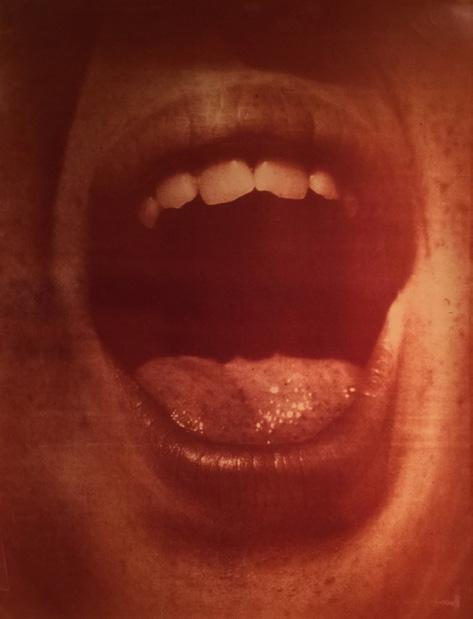
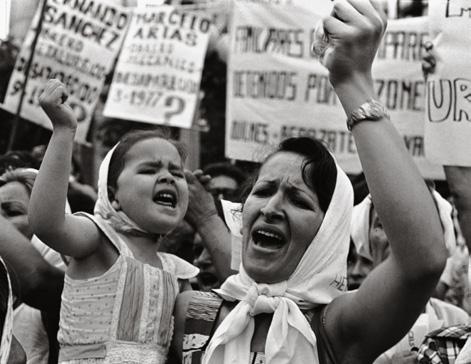
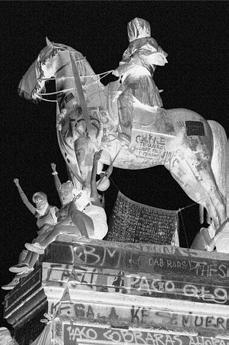
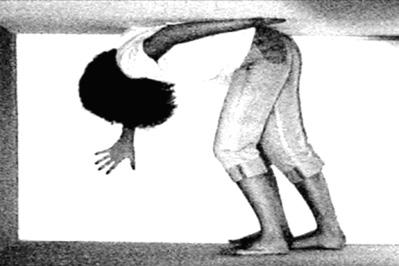
 Aline Motta, (Other) Foundations, #3, 2017–2019.
Aline Motta, (Other) Foundations, #3, 2017–2019.
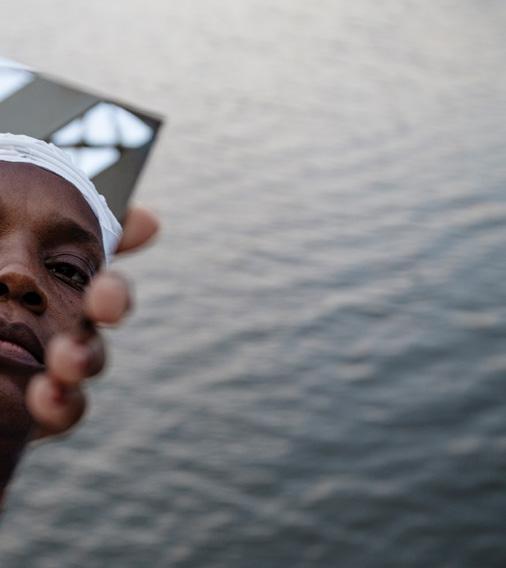
 50 Santiago Porter, Evita, from the Bruma II series, 2008.
50 Santiago Porter, Evita, from the Bruma II series, 2008.
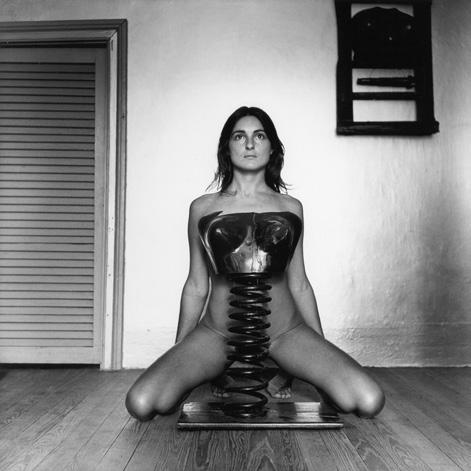
Campbell Addy (1993), Arielle Bobb-Willis (1994), Micaiah Carter (1995), Awol Erizku (1988), Nadine Ijewere (1992), Liz Johnson Artur (1964), Quil Lemons (1997), Namsa Leuba (1982), Renell Medrano (1992), Tyler Mitchell (1995), Jamal Nxedlana (1985), Daniel Obasi (1994), Ruth Ossai (1991), Adrienne Raquel (1990), Dana Scruggs, Stephen Tayo (1994)
Additional works by AB+DM (Ahmad Barber and Donté Maurice), Djeneba Aduayom, Lawrence Agyei, Rasharn Agyemang, Araba Ankuma, Bafic, Daveed Baptiste, Malick Bodian, Kennedi Carter, Jorian Charlton, Christian Cody, Faith Couch, Delphine Diallo, Rhea Dillon, Philip-Daniel Ducasse, Christina Ebenezer, Yagazie Emezi, Cary Fagan, Justin French, Alexandre Gaudin, Erica Génécé, Kenny Germé, Denzel Golatt, Yannis Davy Guibinga, Travis Gumbs, Tyrell Hampton, Seye Isikalu, Adama Jalloh, Manny Jefferson, Kreshonna Keane, Ekua King, Joshua Kissi, Casper Kofi, Olivia Lifungula, Myles Loftin, Mahaneela, Ronan Mckenzie, Tyra Mitchell, Fabien Montique, Sierra Nallo, Manuel Obadia-Wills, Travys Owen, Amber Pinkerton, Marc Posso, Caio Rosa, Silvia Rosi, Lucie Rox, Makeda Sandford, Cécile Smetana Baudier, Justin Solomon, Texas Isaiah, David Uzochukwu, Juan Veloz, Isaac West, and Joshua Woods.
The New Black Vanguard: Photography between Art and Fashion presents artists whose vibrant portraits and conceptual images fuse the genres of art and fashion photography in ways that break down long-established boundaries. Their work has been widely consumed in traditional lifestyle magazines, ad campaigns, and museums, as well as on their individual social-media channels, reinfusing the contemporary visual vocabulary around beauty and the body with new vitality and substance. The images open up conversations around the representation of the Black body and Black lives as subject matter; collectively, they celebrate Black creativity and the cross-pollination between art, fashion, and culture in constructing an image. Seeking to challenge the idea that Blackness is homogenous, the works serve as a form of visual activism. It’s a perspective often seen from this loose movement of emerging talents, who are creating photography in vastly different contexts—New York and Johannesburg, Lagos and London. The results—often made in collaboration with Black stylists and fashion designers—present new perspectives on the medium of photography and the notions of race and beauty, gender, and power.
The exhibition includes select works from these groundbreaking contemporary photographers, as well as a salon wall featuring images created by other young Black photographers contributing to this movement. Vitrines of publications, past and present, contextualize these images and chart the history of inclusion, and exclusion, in the creation of the Black commercial image, while simultaneously proposing a brilliantly re-envisioned future.
Exhibition curator
Antwaun Sargent.
Exposition produced by Aperture, New York, in collaboration with Les Rencontres d’Arles.
Publication The New Black Vanguard: Photography Between Art and Fashion, Aperture, 2019.
Thanks to Airbnb Magazine and Tasweer Photo Festival, Qatar.
With support from Dupon-RC Group.
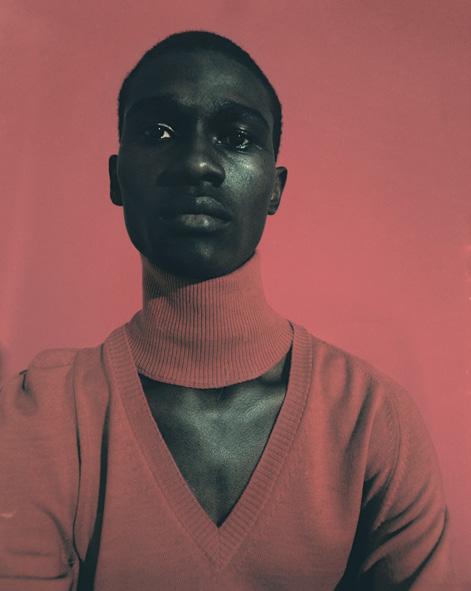

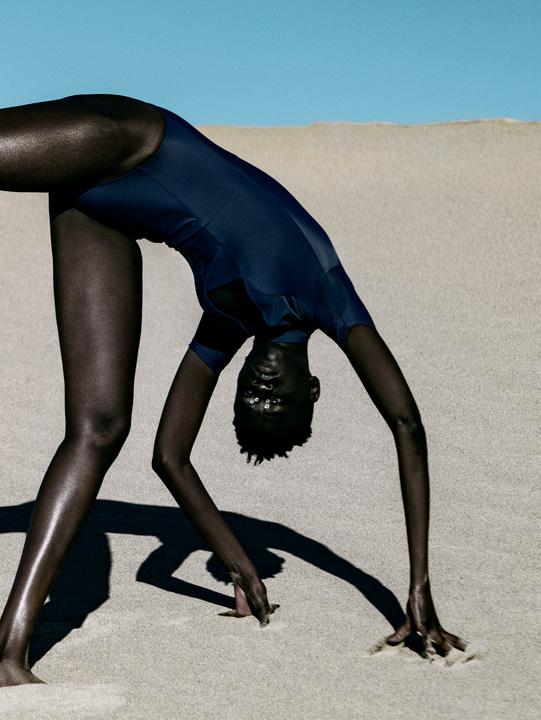


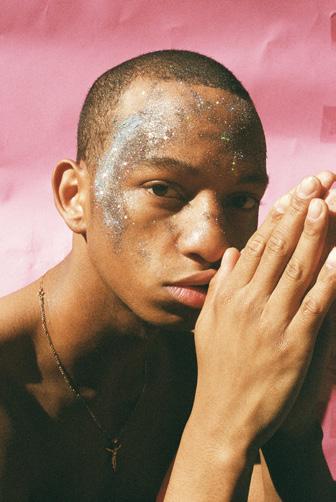
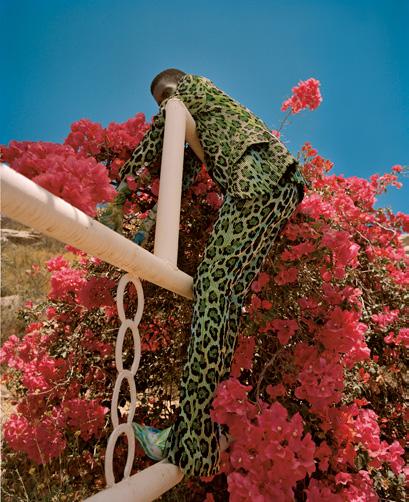
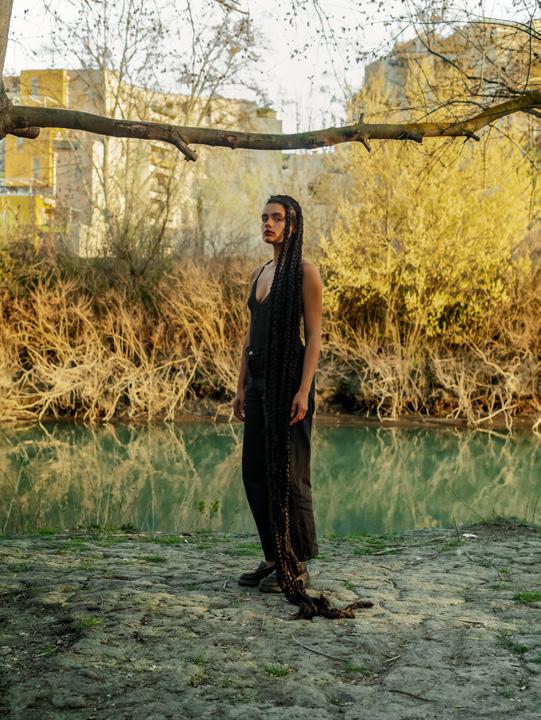
Born 1980 in Singapore. Lives and works in Singapore and Berlin, Germany.

Sim Chi Yin is an artist whose research-based practice includes photography, archives, and text-based performance, and focuses on history, conflict, and memory. Recent solo exhibitions include Most People Were Silent, Institute of Contemporary Arts, LASALLE College of the Arts, Singapore (2018), Fallout, Nobel Peace Museum, Oslo (2017), and Rat Tribe, 15th Istanbul Biennial, Turkey (2017). Sim was commissioned as the Nobel Peace Prize photographer in 2017. She is represented by Zilberman Gallery, Berlin and Hanart TZ Gallery, Hong Kong, and joined Magnum Photos as a nominee member in 2018. She is currently completing a visual practicebased PhD with King’s College London.
Sim Chi Yin’s project contests historiographies of the Malayan Emergency (1948–1960), where jungles, plantations, and villages became battlegrounds for anti-colonial fighters, and British and Commonwealth troops. A key global source of rubber and tin, Malaya was strategically important for the British. One of the early hot conflicts in the global Cold War, and cast as an exemplary counterinsurgency, Malaya was also where population-control strategies and the use of Agent Orange were pioneered and later used in the Vietnam War.
For Interventions, shown for the first time, Sim combed the British Imperial War Museum’s archive, photographing prints and negatives to merge verso and recto into one plane. This in-camera process caused usually hidden labels and marks to appear with images on the front, forming new mise-en-scènes that reveal mechanisms of meaning in the colonial archive. Used by the authorities for media campaigns and psychological warfare, the original images juxtaposed the dual euphemisms of the “Emergency” and “banditry” to support state military operations against anti-colonial struggles. Sim’s transformations question the indexicality of material evidence used to understand the past and present. Sim introduces further perspectives of the anti-colonial left with two other series: Remnants features landscapes from the conflict in present-day Malaysia and Thailand that still retain traces of war. Requiem is a video installation where former deportees and exiles living across China, Hong Kong, and Southeast Asia reclaim memories of their political participation in their own voice, performing revolutionary songs “Goodbye Malaya” and “The Internationale.”
Sim’s assemblage of suppressed histories, personal narratives, private collections, and altered sites form a counter-archive to colonial and postcolonial states’ accounts of the war. Her multi-part project is as much memory work as an act of resistance.
Remnants #4, Perak, Malaysia, 2017.
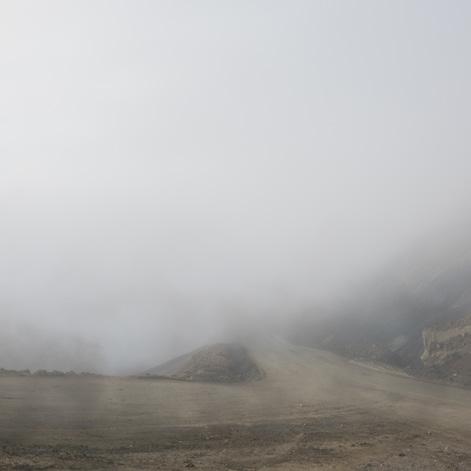
Top From Interventions, photographic installation, 2018.
Bottom Requiem, 2016–2018.
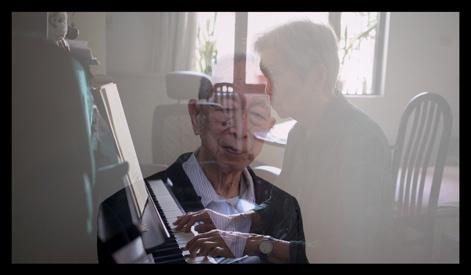
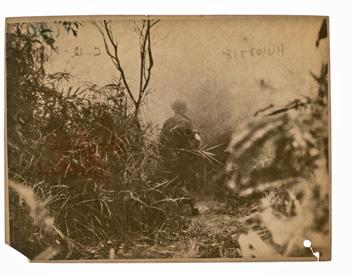
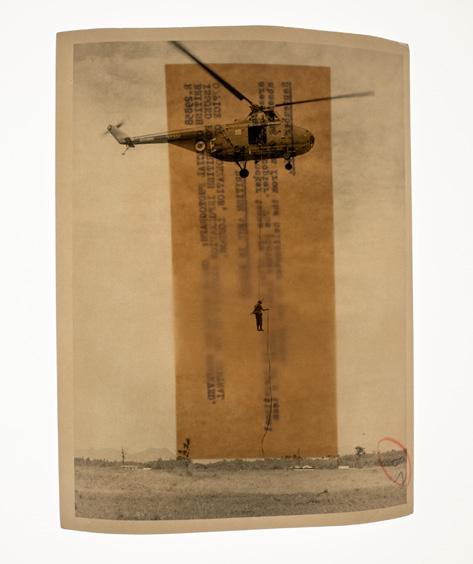
Born 1986 in Madrid, Spain.
Lives and works in London, United Kingdom.
Almudena Romero is a visual artist. In 2020, she worked as a professor of photography on Stanford University’s Bing Overseas Study Program in Florence. A Fellow of the Higher Education Academy, she holds an MA in Photography and a Postgraduate Certificate in Academic Practice in Art, Design and Communication from the University of the Arts London. Romero’s practice has been exhibited at international public institutions including Tate Exchange, Tate Modern, London; London Art Fair; Tsinghua University Art Museum; Le Centquatre, Paris; Unseen Amsterdam, and Fundación MAPFRE, Madrid. In 2021, she is nominated for the Prix Pictet.

Over the last few years, we’ve observed a growing interest in the materiality of photography. With her project The Pigment Change, Almudena Romero, the 10th laureate of the BMW Residency, uses ecological consciousness and organic matter to reflect an aesthetics of fragility, if not disappearance. In four parts: Faire une photographie, Family Album, Offspring, and The Act of Producing, the project ascribes a new “artistic” use to the present, advocating for sustainability.
In Automne and Printemps, from the series Faire une photographie, plants undergo specific light treatments that result in pigment changes in the leaves, while in Family Album, the artist exposes negatives from her family archives directly on panels of watercress seeds to “grow” photographic prints. In The Act of Producing and the series Offspring, Romero uses whole plants as photographic canvases to record images.
The Pigment Change uses intrinsic qualities to plants, especially those related to their exposure to light and particular wavelengths. The experiments result in image-objects with great visual force, photographic moments exploring an expansive sense of the medium. In this way, the use of plants as material challenges the notion of progress: the product of knowledge accumulated by the flow of images. Photography is also a cause of the depredation of the real. Its critique through the use of plant matter is, to say the least, a necessary step in reconstructing the medium.

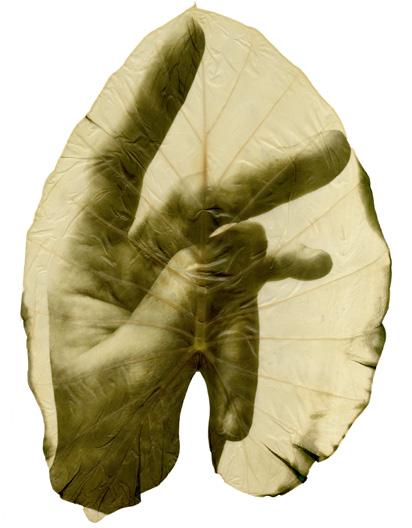

Born 1988 in Katlehong, South Africa. Lives and works in Johannesburg, South Africa.
Lebogang Tlhako trained as a photographer at the Market Photo Workshop in Johannesburg and completed the Advanced Programme in Photography in 2012. She works primarily with film photography and is fascinated by South African street style, different cultures, and social landscapes. Tlhako is currently part of the editorial team for The NICE Magazine and exhibited in the exhibition Unseen Amsterdam in 2018. She has recently been selected for the Lampost Luminaries, a ten-month fellowship program starting in 2020 for emerging women photographers and videographers.
For the Rencontres d’Arles and Institut français Curatorial Research Grant – Africa Projects, I planned to investigate Southern and Eastern African ideas around contemporary African photography in relation to documentary photography and what that meant for African female photographers.
Lebogang Tlhako’s series Sibadala Sibancane is an intimate portrayal of these themes but what is even more striking about her work is her process of making.
Sibadala Sibancane, all shot on 35 mm film, is a collection of photographs that speak about her relationship with her mother and how it has influenced and shaped her growth into a young woman. Her work is a reminder of a culture of keeping photo albums, which was made popular at the end of the nineteenth century as part of middle-class femininity. In those days, album making was for high-ranking women with the time and money to design a photo book of their memories that contained family history and personal narratives. Tlhako brings back the nostalgia in album making by creating collages that layer images from her mother’s photo albums with cut-outs of portraits of young children and landscapes from her community and environment.
Sibadala Sibancane, which means, “we are old, we are young,” encompasses the shift of documentary photography to contemporary image making in a world where the art of album making is rapidly vanishing.
Much like other African women artists, such as Lebohang Kganye and Joana Choumali, Thlako has found new ways of working with the photographic medium. Her idea to reshape a physical photograph into a completely new image makes her work important to the new trend in contemporary photography in Africa.
Fulufhelo Mobadi

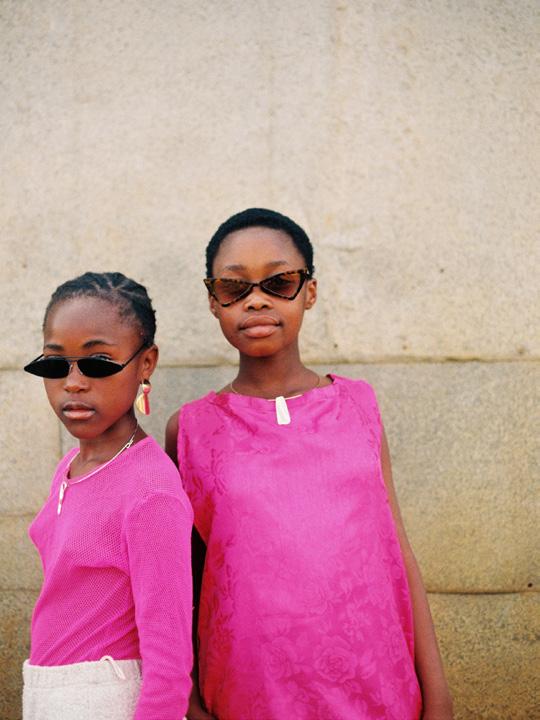
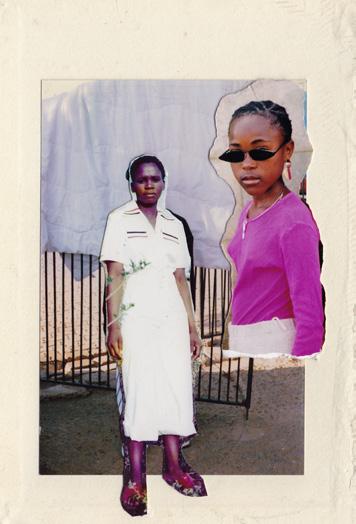
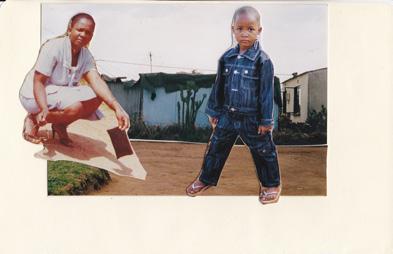
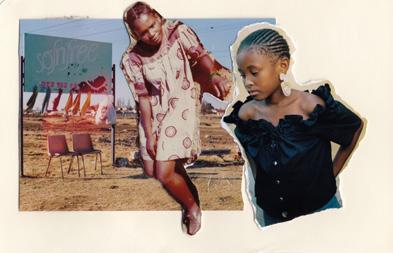

Each of the three works by École Nationale Supérieure de la Photographie d’Arles (ENSP) graduates meriting Special Attention at the Rencontres d’Arles this year, according to the jury, evokes “the communal,” as it is shared in time, space or through an activity.


Anyssia Bidout’s work revolves around the motor vehicle: its construction, repair, and aesthetics. Using the car as its medium, an original visual culture is shaped on streets, in garages, junkyards, and shop floors. Most of the production happens in a particular space—the auto body and paint shop, viewed here as a repair space, but above all as a site of aesthetic experimentation, a temple of symbols that can make a car seem more attractive or more absurd. The series Filmogenic seeks to empty the car of its social, political, and cultural meanings, and transform it into simple line, surface, and volume, presenting car bodywork as an artisan domain.
Begun in 2018, Emma Riviera’s series Fos Ideas, analyzes the complexities of the city Fos-sur-Mer, whose Mediterranean landscape has been sculpted by the petroleum industry, the port, and the major highways that cut through it. A similar ambiguity lies in the wealth of the municipality, rich from taxing companies that use the land, and the land’s low-income residents, who live under the medical, ecological, and social fall-out of this economy. Wanting to push past the city’s image, Riviera goes out to meet the people of Fos in their everyday lives, punctuated by public festivals, leisure time at the beach, and at roundabouts, the symbol of the Gilets Jaunes movement.
Cédrine Scheidig’s A Life In-Between is a photographic project exploring the “third island,” or the Caribbean populations that live on the outskirts of Paris. Some 200,000 people born in the Antilles live in mainland France—about one Antillean in four. Navigating another type of island, urban and concrete, and its places of escape, the artist explores the notions of identity, history, and memory, as well as the emerging imaginaries associated with uprootedness, striding the urban and the natural, here and someplace else.
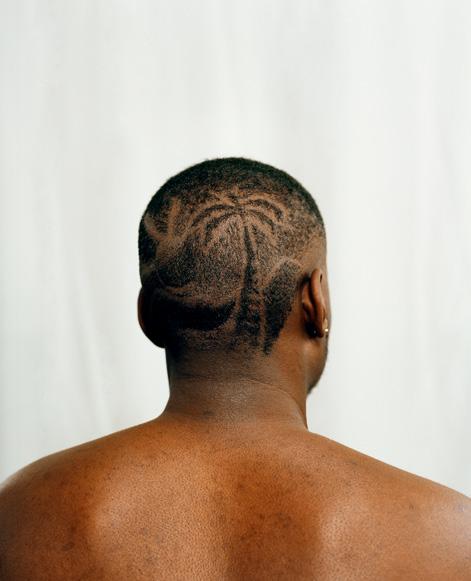

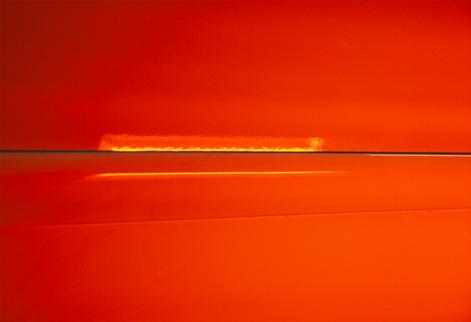
Since its creation, the Rencontres d’Arles has promoted photography and all its stakeholders, from photographers to artists, curators, and publishers. With this in mind, the Rencontres d’Arles associates the Louis Roederer Discovery Award with all exhibition spaces: galleries, art centers, nonprofits, independent venues, and institutions are often the first to support emerging artists. During opening week, a jury will bestow the Louis Roederer Discovery Award, which comes with an acquisition worth €15,000, upon an artist and the project’s supporting organization. The public will vote for the Public Award, which carries an acquisition worth €5,000.
This year, eleven shortlisted projects will be featured in a single show curated by Sonia Voss. She and scenographer Amanda Antunes will innovatively showcase, in an environmentally friendly way, the emerging scene at one of the festival’s signature sites, the Église des Frères-Prêcheurs.
This year, the artists shortlisted for the Louis Roederer Discovery Award will be exhibited in a group show where a wide range of works resonate with each other.
The eleven projects were selected from numerous submissions. Reflecting a desire to question and rethink techniques and genres, they attest to a keen interest in the body and its place in the world, as well as in the materiality and history of photography.
These artists take photographs, make videos, create installations, explore archives, and experiment with digital tools. They tell stories—personal, collective, or intergenerational, real or fictionalized; they turn the medium’s processes, canons, and gestures upside-down, and develop them in physical or virtual space. Some express their commitment and perspectives on their environment in abstraction or unprecedented forms, others through narratives that comment on a humanity both tense and mobile.
Sonia Voss
Founded in 2005, by Sunny Rahbar, Claudia Cellini, and Omar Ghobash, The Third Line is a Dubai-based art gallery that represents contemporary artists locally, regionally, and internationally. The Third Line also hosts nonprofit, alternative programs to foster interest in art and dialogue in the region. Among the artists represented are Hassan Hajjaj, Youssef Nabil, and Zineb Sedira.
Helena Anrather opened in New York’s Chinatown in 2017. The gallery works with a community of artists from emerging to established, and is committed to adding new voices and perspectives to contemporary art practice, giving the first New York solo exhibitions to many of the artists it works with.
FEATURED ARTIST: FARAH AL QASIMI
galerie frank elbaz opened its doors in 2002, in Paris. It presents exhibitions dedicated to French and international living artists, as well as historical artists and artists’ estates. In 2016, the gallery inaugurated a new space in Dallas, Texas, strengthening its ties to the American scene. By supporting emerging artists, the gallery demonstrates its constant interest in young creation.
FEATURED ARTIST: KETUTA ALEXI-MESKHISHVILI
Display is a space for experimental artistic and curatorial practices created in 2015, in Berlin. Through multiple collaborations, Display is committed to revising image systems and devices, exploring the relationships between different bodies in space within the idea of “contact zone.” Display was awarded the City of Berlin’s Art Space Prize in 2018 and 2020. It is directed by Marie DuPasquier.
FEATURED ARTIST: MARIANA HAHN
MABA is a contemporary art center created in 2006, on the initiative of the Fondation des Artistes. Intended to promote and diffuse contemporary creation, to encourage the emergence of experimental projects, it organizes three exhibitions per year. Its program focuses on two media, photography, and graphic design, while paying attention to other disciplines that question the relationship to the world and contemporary society, to history and memory, as well as to the territory… to build an “enlightened” citizen’s view.
FEATURED ARTIST: ILANIT ILLOUZ
For almost a century, Folkwang University of the Arts in Essen has been one of the leading academic institutions for teaching both the practice and theory of photography in the German-speaking countries. Its work leans on two different exhibition venues: Gallery 52, an art space which offers three different types of exhibition rooms (white cube, foyer, and black box), and the SANAA building that offers space for major installations and is used twice a year.
FEATURED ARTIST: JONAS KAMM
LOS ANGELES, UNITED STATES
as-is.la attends to a cohort of lesser-known and underappreciated artists working in Los Angeles from the 1960s to the present; the intention is to subtly disrupt the familiar art-historical narratives built around established judgments of quality, influence, and significance that have come to us as received wisdom. as-is.la is a project of Mok Wai Wan in collaboration with Tom Jimmerson.
FEATURED ARTIST: TARRAH KRAJNAK
Created at the initiative of Astrid Ullens de Schooten, Fondation A Stichting opened its doors in Brussels in 2012. Its vocation is to support the creation, knowledge, and conservation of the photographic image. Its objective is to explore the issues and contradictions of the image-document in order to question this world of the visual whole that we inhabit. Since 2015, Fondation A Stichting has dedicated one exhibition per season to a young artist.
FEATURED ARTIST: MASSAO MASCARO
Webber Gallery is a contemporary photographic space in the heart of London’s Fitzrovia, dedicated to celebrating the diversity of the medium. Since 2014, the gallery’s innovative program of exhibitions, artist talks, and book launches have explored contemporary photographic themes, from solo presentations of narrative works to experimental group presentations.
FEATURED ARTIST: ZORA J MURFF
Located in a former factory, The Pill is an international contemporary art gallery. Founded in 2016, the gallery operates as a global platform, bringing together local and international artists within an distinctive program. It aims to create a fertile environment for multidisciplinary contemporary art and to increase the Turkish scene’s international visibility. Since its opening, the gallery has established itself as one of the most influential players in the region by anchoring its artists within the landscape of public and private collections worldwide.
FEATURED ARTIST: AYKAN SAFOĞLU
The Berlinische Galerie is one of a kind: it collects, preserves, and displays modern and contemporary art made in Berlin. Its collection is interdisciplinary and includes painting, sculpture, drawings, photography, and architecture. With some 73,000 works, the Berlinische Galerie boasts one of Germany’s leading photography collections, which reflects the evolution of the medium as an art form.
FEATURED ARTIST: ANDRZEJ STEINBACH
In Spring 2016, Pragovka Gallery, a new collaborative, nonprofit, artist-run concept was founded in a former factory in industrial Prague. Its mission is to create a platform for contemporary art, to serve as a creative incubator to enable a fruitful exchange of ideas among communities, and to provide cultural activities for the general public—exhibitions, performances, lectures, and workshops.
FEATURED ARTIST: MARIE TOMANOVA
Born 1991 in Abu Dhabi, United Arab Emirates. Lives and works in Dubai, United Arab Emirates, and Brooklyn, United States.
Farah Al Qasimi studied photography and music at Yale University, and received her MFA from the Yale School of Art in 2017. Working primarily with photography, video, and performance, she examines postcolonial structures of power, gender, and taste in the Gulf Arab states. Her practice seeks to incorporate social critique embedded in close observation of the multiple environments in which she works. Her recent exhibitions include several solo and group shows, notably at Helena Anrather in New York and The Third Line, Dubai, as well as the MIT List Visual Arts Center, Cambridge, Massachusetts, and the Sharjah Art Foundation, Dubai.

To make silky hummus, you must first remove the chickpea skins. In a ritualistic and time-consuming act of preparing the chickpeas for their delicious destiny, this paring reveals the legume in its full flesh-toned, nude glory. With this metaphor, Al Qasimi invites us to examine the questions of intimacy and the separation between public and private spaces at the heart of her work. Humorously and with a bold but subtle use of color, she conducts us into interior spaces—her own, among others—typical of the urban upper-middle class in her country of origin, the United Arab Emirates. We see elements of traditional decoration lying alongside utilitarian modern objects, everyday familiar practices melting seamlessly into the performance of social functions, and the aesthetics unique to the Persian Gulf mingling with those of its colonial heritage.
To bring this heterogeneous amalgam of tastes and values into focus, the artist plays skillfully with stereotypes. The results—hybrid, rich, at once joyous and troubling, reflect the rapid evolutions undergone by a very young nation. The cultural, political, and religious topos involving the visibility of women— and more generally, representation of the body—forms the central concern of these photographs. Through their suggestive character and sophisticated framing, they work around the taboo of figurative representation by drawing our attention to eroticized objects—feminine lingerie, perfume sprayers, a sofa carrying the fresh imprint of a body. At the same time, the images move into the foreground the life and social interactions of women viewed within the spaces they inhabit.
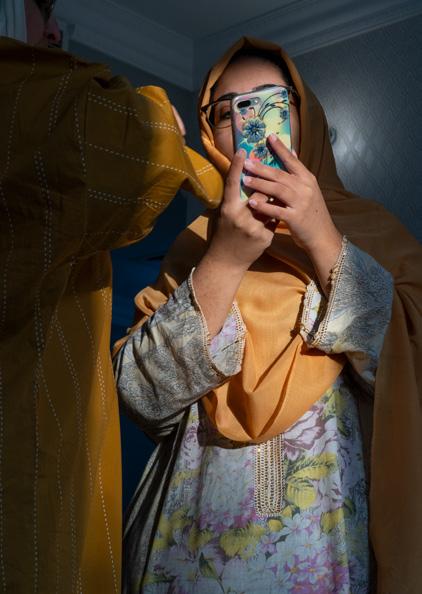
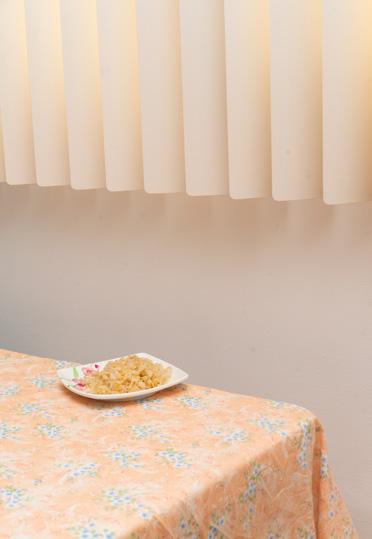
Fragrance Spray, from the Imitation of Life series, 2020–2021.


Ketuta Alexi-Meskhishvili
Born 1979 in Tbilisi, Georgia.
Lives and works in Berlin, Germany.
Georgian-American Ketuta Alexi-Meskhishvili received her BFA in Photography from Bard College in New York, where she studied under Stephen Shore, An My Lê, and Barbara Ess. Her photographs, meticulously composed, are made on analog film, often subsequently subjected to a manual- or digital-altering process. Her experimental approach involves a mise en abyme of the photographic medium and of the concomitant questions of representation. Her most recent exhibitions include solo shows at the LC Queisser Gallery in Tbilisi (2020) and the galerie frank elbaz in Paris (2019).
Familiar and impersonal at the same time, the plastic bag is at the center of Ketuta Alexi-Meskhishvili’s most recent work. The artist, fascinated by an object that is both fragile and enduringly pollutive, has for several years collected specimens of what she calls a “future fossil.” In Georgia, where she was born, a number of these bags, intended for tourist consumption, display traditional ornamental motifs, similar to those found in Byzantine churches. Alexi-Meskhishvili sees an analogy here to her country and the conflictual relationship it maintains with its own history, oscillating between nationalist and religious identity building on the one hand, and between progressive and neoliberal values on the other; between conservative imperatives and a youthful insouciance.
The curtain presented here is characteristic of the artist’s method: derived from a 4 × 5-inch negative, to which she has apposed a plastic bag illuminated by a finger light—a clubbing accessory—the curtain has been adapted to the nature and dimensions of the exhibition site. The translucent textile material and its falling drape recall the artist’s interest in the play of transparency and light, as well as in the motif of the window that appears in many of her works, while the black edges recall the analogy between the rectangle of the photograph and the window that opens onto the world.



Born 1985 in Schwäbisch Hall, Germany. Lives and works in Paris, France.

After theater studies at ETI, Berlin, Mariana Hahn obtained a degree in Visual Arts at Central Saint Martins, London, in 2012. Her practice, mixing photography, video, writing, and installation, explores the relationship between the body and the transmission of memory and knowledge. Hair, salt, and copper constitute the basic elements of her research into the materials and processes of image- and archivemaking, as well as the various media of conservation. Her work has mainly been presented in Germany (notably at Display in 2019) and in China.
Eros and Thanatos Made a Child is a mixed installation reflecting the diversity of techniques employed by the artist: photography, film, sculpture, and various materials and objects subjected to processes of transformation, as through fossilization, decay, or corrosion. Taking a casting made at the archaeological site of Pompeii as her point of departure, the work is like a homage to photography—an art whose origins might be said to be in the first tracings of the human figure. It is like seeing a snapshot of the body that was buried here, beneath lava, 2,000 years ago.
The salt and copper visible in the installation likewise refer to a material history of the photographic medium, while the animated images—obtained with the aid of a Super 8 camera with its lens removed—have the grainy appearance of the earliest heliographic experiments, where the human figure appears as little more than a phantom. Here, the figure is that of a fisherman, weaving a net with which he intends to catch stories lost at sea, to be returned to the living. The sound of two pieces of wood knocking together at regular intervals measures time, which regulates life and death: the sea swallows up and nourishes people, as well as stories; salt both preserves and corrodes; copper acts as the repository of an image while also reflecting that of anyone who looks at it. All these are media for the transmission of images, which tie humankind to its history and resonate with the art of memory and traces that we call photography.
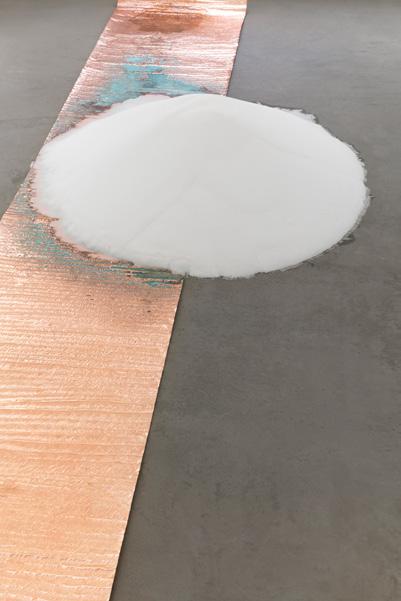
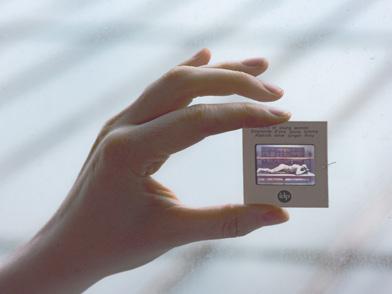
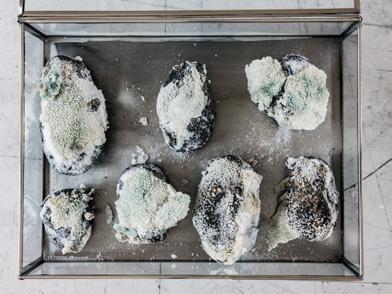
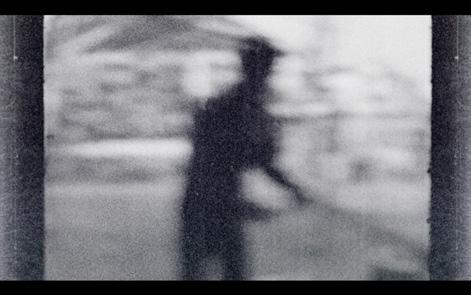
Born 1977 in Paris, France.
Lives and works in Paris.
Since graduating from the Paris-Cergy National Graduate School of Arts in 2005, Ilanit Illouz has developed a practice based on existing and innovative photographic- and mechanicalreproduction processes. Her work frequently addresses the question of narratives, which she approaches elliptically, or from the perspective of what is outside the frame. She often relies on techniques of surveying, enquiry, and observation, in which memory is provoked by physical acts. She had recent exhibitions at the Lille Institute for Photography and the CRP/ Centre Régional de la Photographie Hauts-de-France, and is currently preparing her first monograph, to be published by Eyd Paris.

Wadi Qelt, in the Stony Light is based on extensive research into the natural elements and proposes an experimental photographic study of Wadi Qelt, a valley situated in the Judaean Desert between Jerusalem and Jericho, near the Dead Sea. This territory, imbued with stories from times immemorial, marked by political tensions, menaced by exploitation of its resources, is also linked, for the artist, with the history of photography; it harbors the renowned bitumen of Judea, which, at the beginning of the nineteenth century, served as the photosensitive coating in Nicéphore Niépce’s production of his first contact prints.
The dramatic desiccation of the lake has transformed the region into a lunar zone, corroded by salt. The artist collects this salt from the desert floor and then, in her studio, uses it to fossilize her prints, lending them a sculptural quality. Both image and structural component at once, the salt solidifies the work and makes it scintillate, revealing the organic properties of the mineral, but also its hieratic beauty, evoking a landscape for contemplation but also a threatened ecosystem. Walking and gathering also form an intrinsic part of the artist’s photographic practice. They raise the question of the gaze that frames the landscape, of the hand that grasps the fragment, of the foot that treads upon the desert floor: of all these gestures, this “human scaling” determines the relationship of humanity, and the artist, to their terrain and its representation.
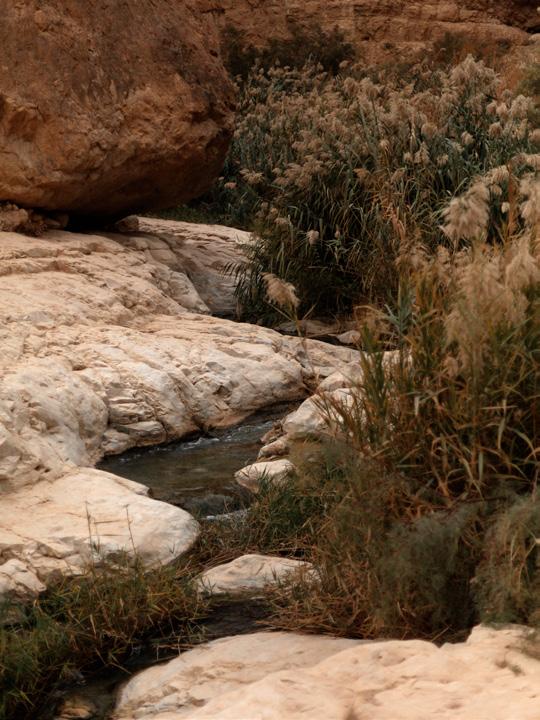
Previous page
Wadi,
Top To Place, Judean Desert, Wood and Palm, from The Sinkholes series, 2016–2021.

Bottom To Place, Judean Desert, Crystallized Twig and Asphalt, from The Sinkholes series, 2016–2021.
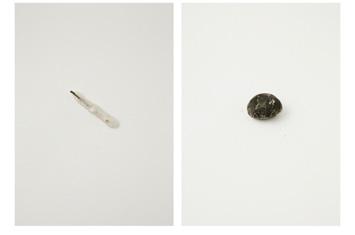
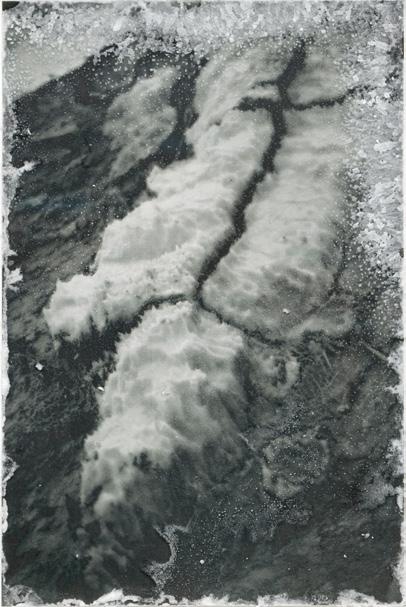
Born 1990 in Bad Reichenhall, Germany. Lives and works in Berlin, Germany.

Jonas Kamm studied photography at the Folkwang University of the Arts in Essen, graduating in 2020. His work revolves around the intersection of sculpture and painting, of computer science and photography, and of various traditional and contemporary pictorial strategies, while questioning cultural viewing patterns. With the help of computer-generated imagery, he creates a universe of images and situations in which objects and spaces meet, creating enigmatic micro-dramas whose meaning often remains ambiguous.
The series The Inhabitants is the result of a hybrid production process, at the crossroads of architecture, sculpture, and photography. These images—two-dimensional renderings drawn from 3D virtual spaces—initially take shape in a space modeled by the artist with the aid of computer software. Then, using virtual tools, Kamm sculpts figures based on a texture that he has previously “harvested” from his physical environment with the camera. Once the figures have been shaped, the software—simulating the tools of photography—permits the artist to choose an angle and to adjust, from a practically unlimited spectrum of possibilities, his light sources, his focus, his aperture, etc. Nevertheless, in contrast to photography, which always requires the existence of a physical reference object, here we witness the emergence of a form from thin air—a form generated by the hand of the artist and by computer, but also by chance.
Kamm’s figures, vaguely anthropomorphic, appear as intermediaries between the real and immaterial worlds. The graininess of their mineral surface, which suggests stone and rough stucco but in certain details betrays the computerized manipulation to which they were subjected, evokes an archaic era, as with the objects taken from his Parametric Archaeology—but at the same time points to the age of high technology that has made them possible. The reductive character, the unclassifiable nature of these images, turns them into vectors of inchoate narratives, carriers of a potential meaning that has yet to be defined, and which remains mysterious, opening a void that we are invited to fill.



Tarrah Krajnak
Born 1979 in Lima, Peru. Lives and works in Los Angeles, United States.
Tarrah Krajnak received her MFA in Photography from the University of Notre Dame, Indiana. She was awarded the Harpo Foundation Grant in 2018 and the 2020 Dorothea Lange–Paul Taylor Prize (Center for Documentary Studies, Duke University). Her work engages with intellectual and material histories, ranging from the sociopolitical conditions of Lima in the late 1970s, to the legacy of modernist canons within the history of photography. She is currently preparing a solo exhibition with as-is.la gallery, scheduled for the fall of 2021, as well as a monograph, forthcoming from Dais Books. Krajnak is also an Associate Professor of Art at Pitzer College in Claremont, California.

Tarrah Krajnak’s work makes clear reference to the history of photography, on the one hand, and to the artist’s identity as a Latin-American woman, on the other. A sequel to her first critical homage to Ansel Adams, this series is consecrated to another North American “master,” Edward Weston. Krajnak here reenacts the famous Nudes (shot starting in 1927 and published as a unified work in 1977). She takes the place of models Bertha Wardell and Charis Wilson, reproducing their poses—but also depicts herself as author of the photographs, a remote shutter release in hand.
Restoring to the picture what Weston left outside the frame— portions of the model’s body and in particular, her face, whose obliteration tends to make us forget the identity of the two women and their participation in the creative process—or emphasizing Weston’s framing choices—what he excluded—using simple wooden panels, Krajnak replays a significant chapter in the history of photography while refocusing on the role of the female model. Further, she challenges the feminine stereotypes created and propagated by photography: a white ideal, shaped by male tutelary figures. Through this performative and photographic act, Krajnak affirms her Latin-American identity and her body of color. She creates, through her presence and the gesture of image reconstruction, a dialogue with her predecessor, Weston, as well as with her contemporary viewers.
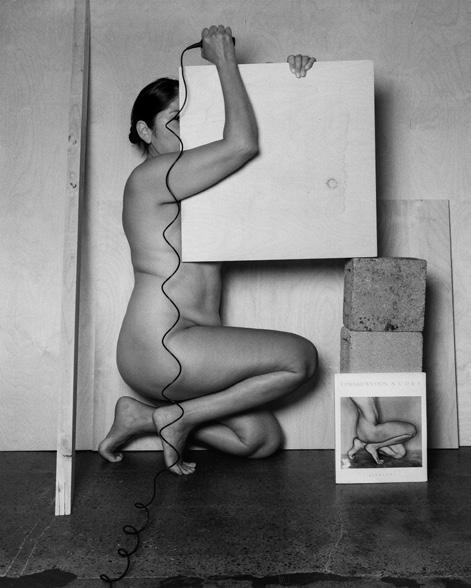

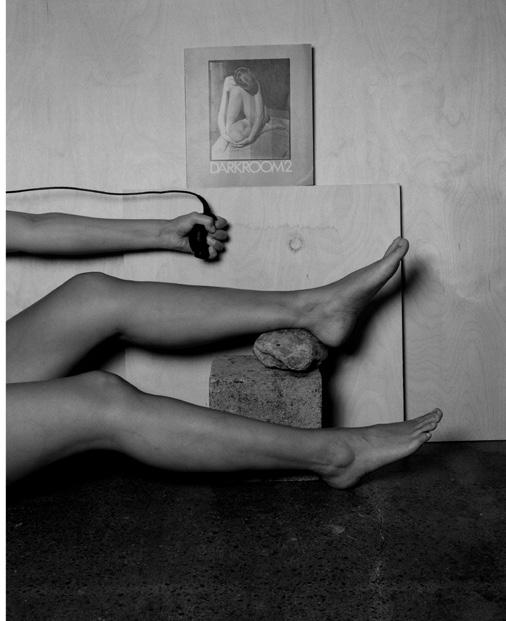
Massao Mascaro
Born 1990 in Lille, France. Lives and works in Brussels, Belgium.

Following initial studies at the ESA Le Septante Cinq in Brussels, Massao Mascaro studied photography at the Blank Paper School (now Dinamo Visual Lab) in Madrid, graduating in 2016. At the crossroads of autobiography, topography, and politics, his work revolves around place and the notion of territory: the Calabria of his ancestors (Ramo), the streets and parks of Madrid ( Jardin), and the coast of the Mediterranean (Sub Sole). He is currently preparing the publication of Sub Sole with Chose Commune.
Sub Sole (in Latin, beneath the sun), an ensemble of photographs made between 2017 and 2020, in the region of the Mediterranean Sea, follows the mythological itinerary of the voyage of Ulysses: Ceuta, Naples, Athens, Palermo, Istanbul, Tunis, and Lampedusa. Crossroads of cultures, cradle of foundation myths, the Mediterranean is, today more than ever, marked by migrations, exile, and displacement. Over the course of seven voyages and numerous chance meetings, Mascaro goes in search of the young people who inhabit and traverse this region. The literary narratives that the artist drew upon for his work are like the invisible companions of these photographs. They imbue the contemporary images with an ancient substance.
Fragments of gesture, faint traces, and brief encounters resonate with the immensity of the never far-off sea, which with the ebb and flow of its tides ties past to present, and with its power amplifies the echoes of every movement, of every presence, only to let them all go again, returning them to their fragile solitude. Political, economic, existential, and poetic implications intersect beneath the sun; beneath the harsh and hot Mediterranean light that shapes human life with its rhythm.


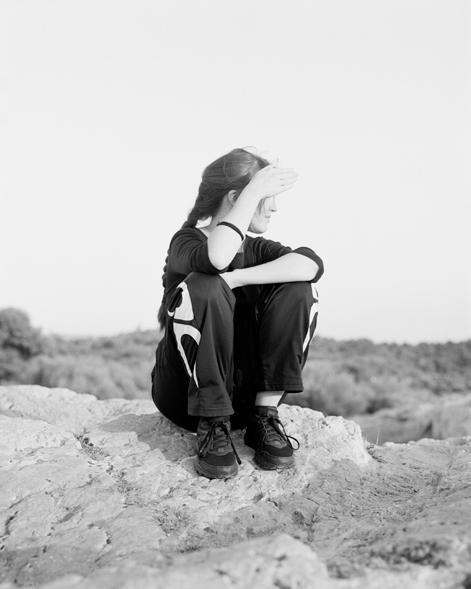
Born 1987 in Des Moines, United States. Lives and works in Fayetteville, United States.
Zora J Murff received his MFA from the University of Nebraska-Lincoln and holds a BS in psychology from Iowa State University. His photographic practice highlights intersections between various social systems and art. Murff is also a co-curator of Strange Fire Collective, a group of interdisciplinary artists, writers, and curators, and an Assistant Professor of Art at the University of Arkansas. At No Point In Between was recently published in a limited edition at Dais Books and selected as the winner of the Independently Published category of the Lucie Foundation Photo Book Awards.
At No Point in Between takes as its subject the African-American neighborhood of North Omaha, Nebraska. Showing portraits of the neighborhood’s inhabitants alongside urban landscapes, the series evokes a social environment profoundly determined by a succession of racist policies and by the injustice that has reigned there since its inception. Zora J Murff, himself a collector of photographs and artefacts, places his own photographs in dialogue with found images and thus brings to light the continuities that tie the social framework in which his ancestors lived to the structures governing the lives of his contemporaries. Combining humanist and topographical research on the one hand, and archival analysis on the other, Murff focusses on the complex tangle of violence impacting the city’s Black community: that of odious crimes, such as the lynching of Will Brown (1919), the assassination of Vivian Strong (1969), and the recent police violence documented on videos that have circulated widely through the social media; but also the systemic violence of governmental decisions that have affected the community slyly and no less calamitously, resulting in social and economic exclusion, such as the redlining of the neighborhood by urban planners. The bodies and the places we see here all bear the stigmata of racism, which remains today a dominant aspect of the Black experience in the United States.

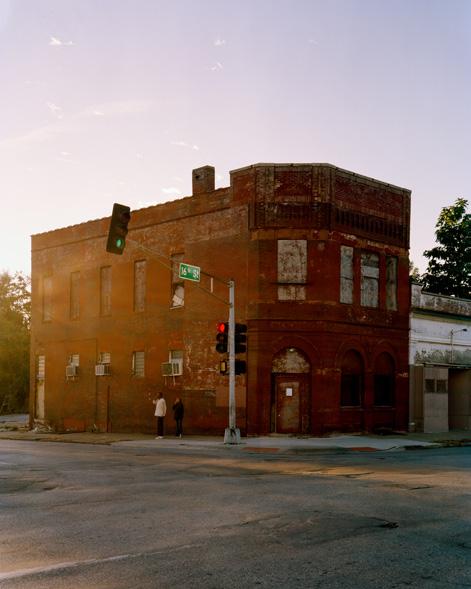

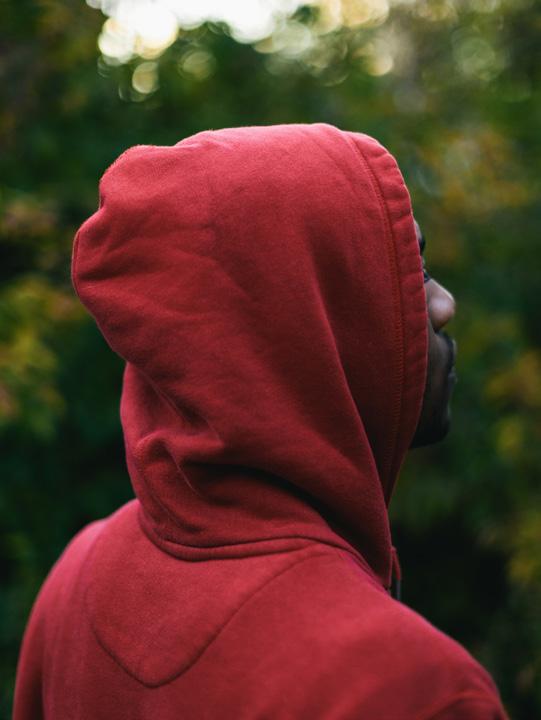
Born 1984 in Istanbul, Turkey.
Lives and works in Berlin, Germany and Vienna, Austria.
Aykan Safoğlu graduated from the “Art in Context” MA program at the University of the Arts, Berlin, and received his MFA in Photography from the Milton Avery Graduate School of the Arts at Bard College, New York. He is currently pursuing a PhD at the Academy of Fine Arts Vienna. Through his work in multiple media including film, photography, and performance, Safoğlu conducts open-ended investigations into cultural identity, creativity, and kinship. In addition to his solo exhibition at The Pill, Istanbul in 2020, he has recently participated in the Berlin Biennale for Contemporary Art (2020) and the Contemporary Art Biennial Sesc_Videobrasil, São Paulo (2019).

It all starts with a tree that falls beneath the artist’s window one night. This event, and a vivid memory of summer vacations spent with his parents on the island of Imbros, lead the artist to tell us the story of his own experience of uprooting. Turkish, educated at the German High School of Istanbul, as a young student Safoğlu goes into exile in Berlin, following in the footsteps of his aunts and uncle. For his family, the absence of this uncle, who died in Germany, is associated with a painful memory. Safoğlu’s education at the German High School, which his parents hoped would prepare him for a better life, only makes him feel torn between two cultures—two countries whose complex relationship today cannot be separated from the relationship between Europe and the Ottoman Empire prior to the First World War. At that time, Prussia financed the army of the Ottomans, creating the conditions for a political and economic dependency that has continued through to the present day, as witnessed by the conscription of young Turkish soldiers under the Prussian flag and the successive generations of immigrant workers in Germany. The feelings of culpability and humiliation, inseparable from Safoğlu’s experience as a high-school student, constitute the legacy of that relationship.
This intimate tale of reconciliation with his family and with himself is based on Safoğlu’s personal archive of photographs—a favorite material of the artist, whose work frequently involves the manipulation of existing images, the palimpsest, a process of association with storytelling, and the voice. Here, the photographs seem to have been fed through a shredder and then loosely pieced together again. They roll by the viewer as if on a conveyor belt, evoking a road to be traveled in rhythm to the steps of the artist, which thus accompany the unfurling of the narrative.

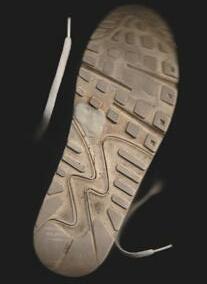
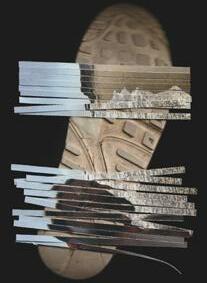
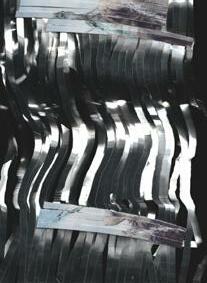
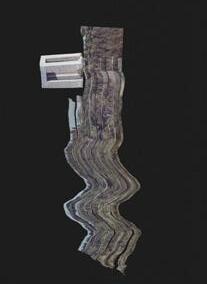

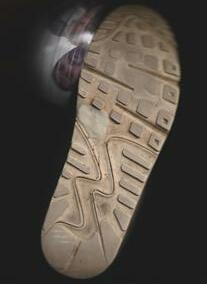

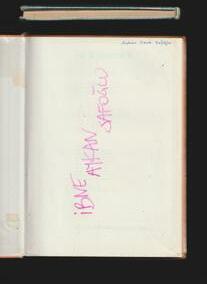

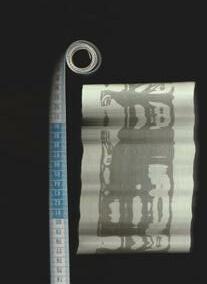
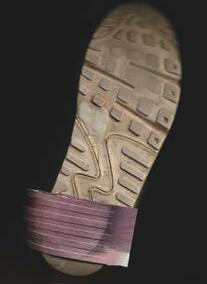

Andrzej Steinbach
Born 1983 in Czarnkow, Poland. Lives and works in Berlin, Germany.
Andrzej Steinbach graduated in 2013 from the Academy of Fine Arts Leipzig, where he later also studied with German photographer Heidi Specker. He was awarded the Federal Prize for Art Students in 2017–2018. His work questions the conventions of the photographic portrait, as well as our reading patterns, the changeability of appearances, and the way in which signs and gestures are decoded. Besides his participation in several international group shows, he recently had a solo exhibition at the Fructa Space in Munich. Each series in his suite of portraits has been published in book form by Spector Books.
The third series in a suite of portraits addressing the representation, and our perception, of the photographic model, The Apparatus foregrounds the figure of a photographer in action. The model’s neutral sexuality assimilates them to the camera, of which they act as an extension. The title refers not only to the mechanical apparatus but also to the human body that operates it and sets it in motion. The gaze and the body are entwined. Reproducing a situation of casting or scientific observation, Steinbach has the model simulate various photographic strategies, gestures, and attitudes. He creates variations using a limited array of accessories, while leaving the action or object at which the camera is pointed systematically outside the frame. Is it a war, a demonstration? The model’s apparel indicates a certain tension—bulletproof vest, helmet with protective goggles, etc. While the pictures refer to well-codified usages in photography and, by implication, to precise genres, they also remind us of the process of image production, which is generally effaced by the image itself. If each photograph plays with a panoply of codes and practices inherited and reproduced—in sum, the whole apparatus of photography—it demands an engagement, too. As a consequence of the continuous and overwhelming circulation of images in today’s world, we risk ignoring, or even disregarding, the bodies involved in their production. Here, Steinbach gives them the principal role.

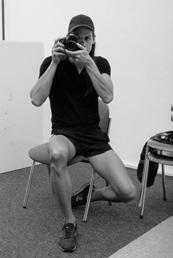

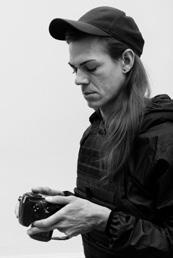

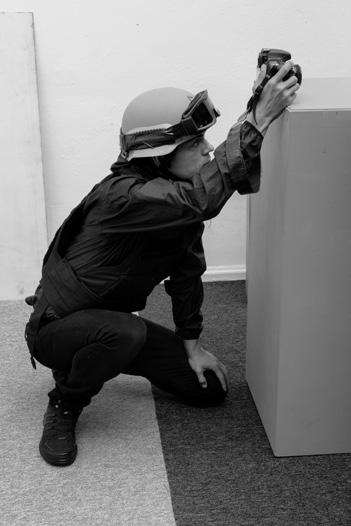
Born 1984 in Valtice, Czech Republic. Lives and works in New York, United States.

Originally from South Moravia at the border between the Czech Republic and Austria, Marie Tomanova moved to the United States in 2011, after graduating with a master’s degree in painting from the Faculty of Fine Arts in Brno University of Technology. There, she turned to photography and began to explore the themes of displacement, identity, and memory. Her series Young American, which gathers together portraits made in the milieu of young New York artists, was the subject of an exhibition at the Pragovka Gallery in 2019, and of a publication with Paradigm Publishing. Her second book, New York New York, will be published by Hatje Cantz.
It Was Once My Universe is the autobiographical story of a homecoming. Returning from New York to her native Mikulov, a Czech village in South Moravia, and to her family’s farm after a decade of absence, Tomanova documents her reunion with loved ones. And yet a disquieting strangeness dominates the atmosphere. The house she missed so much—reminisced about, fantasized, took imaginary refuge in during the most difficult moments of exile—has become an unfamiliar frame, disjointed, in which she no longer has a place. She experiences all the more forcefully the feelings of disorientation and loss of identity, closely tied to her uprooting, because they now inform the “homecoming” she has so long looked forward to.
This series extends the artist’s exploration of the genre of the self-portrait. But more than that, it retraces the paths she took as a child, bathed in a magical light. In her closets, she rediscovers items of clothing, forgotten like so many remnants of sloughed skin, and she stops to examine domestic objects and animals that have become foreign or even fantastic. The camera’s date stamp reminds us of time, the moment when the photograph was taken, which, given so precisely here, contrasts sharply with the murky time of memory. Like the hero of Brigadoon, the artist finds herself caught in an anachronism, experiencing a subtle and powerful “disconnect” between nostalgia and lived experience. For life goes on, with its new thresholds to cross and its fragile expectations of happiness. And then the farm gate closes again on the snow-covered secrets of her childhood. Was it only a dream?
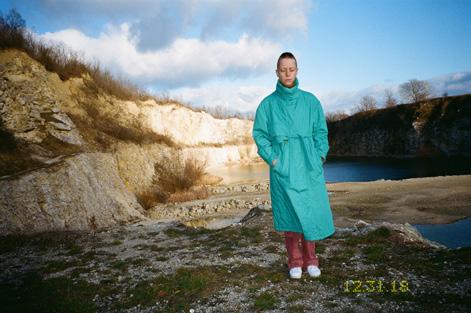
Top My Hair, My Sister’s Hair, from the It Was Once My Universe

Bottom
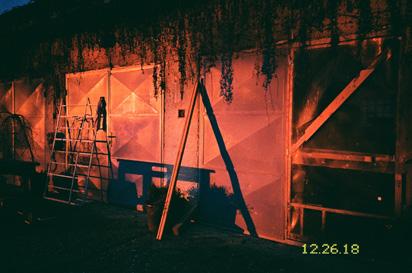


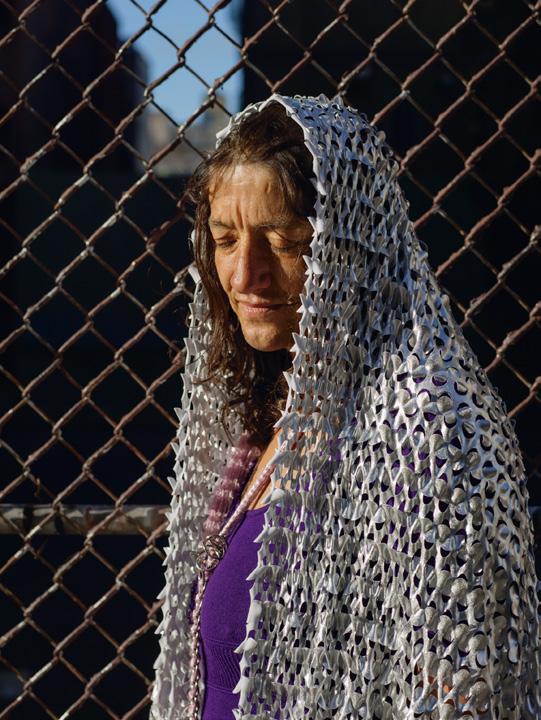
Ahmed Ano (1993), Suha Barakat (1986), Saad Eltinay (1995), Eythar Gubara (1988), Metche Jaafar (1998), Hind Meddeb (1978), Duha Mohammed (1993), Ula Osman (1998), Muhammad Salah (1993)
After thirty years of military dictatorship, theocracy, and years of civil war, on April 11, 2019, the people of Sudan brought down Omar al-Bashir, the man who imposed an unchallenged reign upon them, starting with his coup d’état in 1989.
Sudan’s popular uprising began in December 2018. For five months, risking arrest and torture by the regime’s police, the Sudanese people took to the streets by the thousands.
Driven by the will to document resistance and repression, a new generation of photographers emerged. These artists, between the ages of nineteen and thirty, broadcast their photos through social networks. They are both actors and observers of this historical moment.
The exhibition includes the work of eight photographers from this rising scene. Braving all kinds of odds, the artists bear witness to the first protests against the regime up until the emergence of an immense democratic sit-in that encompassed several square kilometers of Khartoum. For the first time in thirty years, Sudanese people from every region of the country and different political affiliations came together to debate, united by the dream of liberty. Following these discussions, an art scene erupted. The Sudanese dubbed the city within the city “Al Qiyadah” (Headquarters), as it was established along military general headquarters. It was also called “midan al-itissam” (the waiting place), because participants decided not to budge before obtaining a transfer of power to civilians. Their slogan: “taskut bas” (fall, that’s all).
On June 3, 2019, the military junta violently demolished the sit-in. Following weeks of terror, hundreds of thousands of people went to the streets demanding justice. Due to their perseverance, the people of Sudan wrested the seeds of citizen government from the hands of the military. Filmmaker Hind Meddeb documents the steps of this fragile transitional period alongside a youth prepared to challenge military and religious forces.
Metche Jaafar. A little girl checks to see if the police and secret security services have cleared the road so that demonstrators can safely leave her house. Al-Abasiya, Omdurman, February 2019.
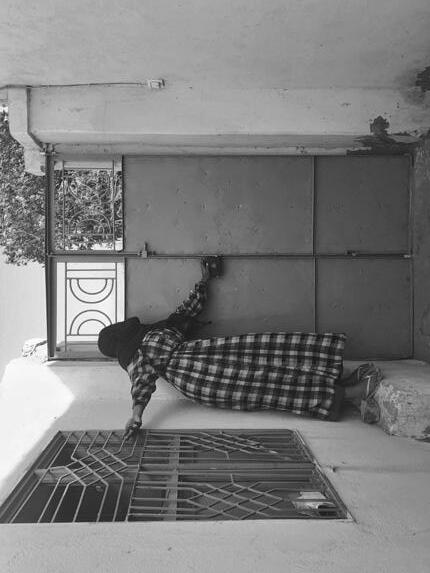
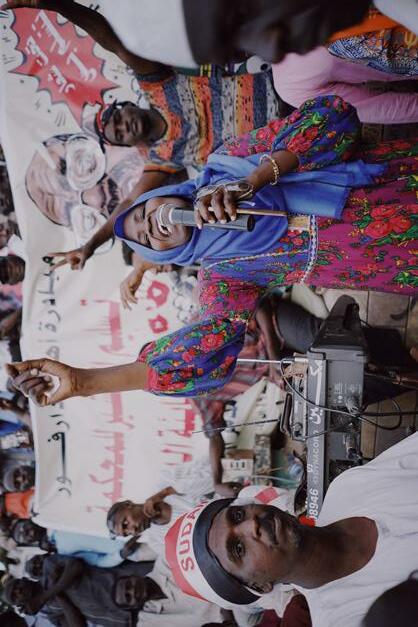
“I’m going out into the streets! Revolution!”

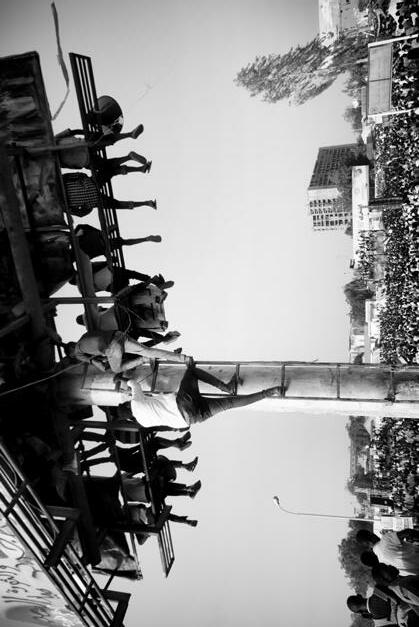
Eltinay.
Saad
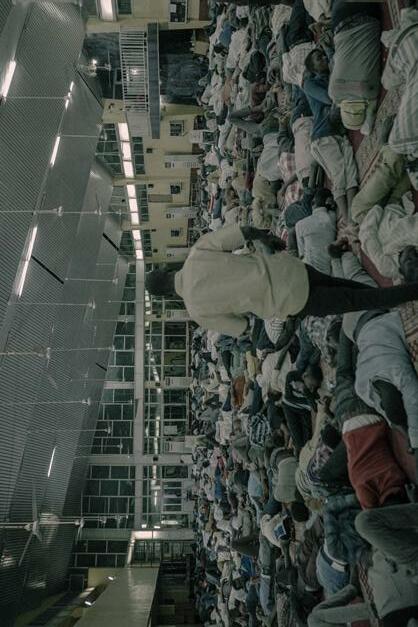

Born 1976 in Johannesburg, South Africa. Lives and works in Cape Town, South Africa.
Pieter Hugo has had major institutional solo shows at the Museu Coleção Berardo, Lisbon; Kunstmuseum Wolfsburg; The Hague Museum of Photography; Musée de l’Elysée, Lausanne; Ludwig Museum, Cologne; Fotografiska, Stockholm; MAXXI, Rome; and the Institute of Modern Art, Brisbane, among others. Hugo has participated in numerous group exhibitions, including at Huis Marseille; the National Museum of Modern and Contemporary Art, Seoul; the Barbican Art Gallery and Tate Modern, London; the Rijksmuseum, Amsterdam; the Folkwang Museum, Essen; and the São Paulo Biennale. His work is represented in prominent public and private collections.
Being Present brings together more than one hundred head and shoulders portraits realized by Pieter Hugo since the early 2000s, offering an expansive overview of the artist’s engagement with this particular tradition of portraiture.
The selected photographs dabble with the lexicons of forensics, surveillance, and typologies, while maintaining a strong humanism at their core.
In Hugo’s words, “My work is about the notion of being an outsider: I feel I inhabit this space myself and I embrace this awareness as a way to engage with the people I photograph. I almost always work by announcing myself at the outset; I look, and I am equally looked at. When making a portrait there is a brief moment in which cynicism disappears. There is beauty in being held in the gaze of another.”
An intimacy emerges from being openly present, and what features prominently in these images is a moment of stillness and connection separate from everything that happened before or after. It is a silent collision between the expectations of the photographer and the sitter; a moment in which Hugo’s gaze is requited. The outcome is often something unexpected that goes on to have its own journey when the viewer replaces the photographer in this dynamic.
The effect of this moment reverberates from the image; one is still looked at, and the culmination becomes a new point of departure. For Hugo, “The encounter between the photographer and the sitter becomes the image; however, the photograph then has many lives in the eyes of its viewers.”
Federica Angelucci.
Prints
Magnum Opus, Cape Town. Mounting and framing Anton, Cape Town.


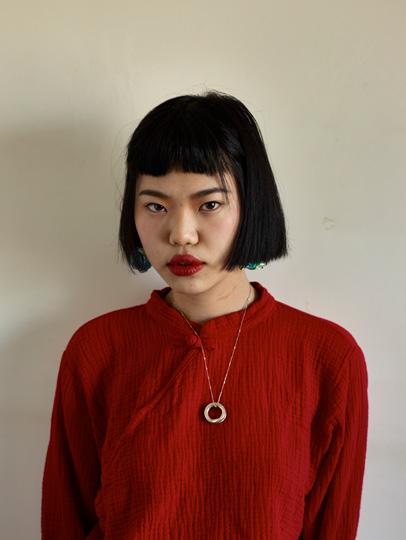
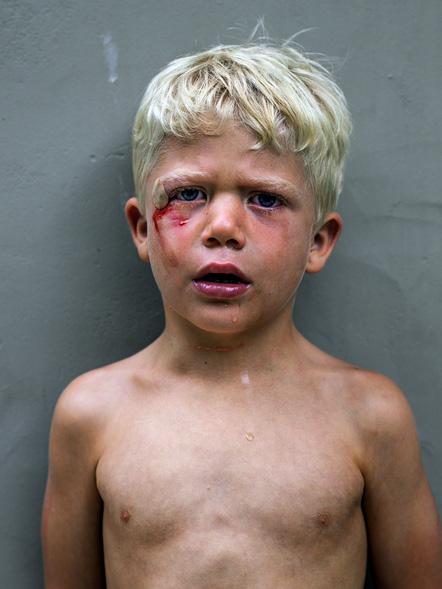

Stéphan Gladieu
Born 1969 in Bagneux, France.

Lives and works in Boulogne-Billancourt, France.
Stéphan Gladieu began his career in 1989, covering conflicts and social issues in Europe, Central Asia, and the Near East, but soon turned to portraiture to explore the human condition across the world. He still works with international magazines but focuses mainly on personal and artistic projects stressing the iconic character of the frontal image and the border between the real and the unreal. His latest series were shot in Asia and Africa. Publication North Korea, Actes
North Korea has always been an enigma to me. Why has it never wobbled while other authoritarian regimes collapsed in the upheavals brought about by the fall of the Berlin Wall, modernity, and social media? It has outlasted the Communist bloc that guaranteed its political and economic stability; withstood international embargoes aiming to strangle it; overcome successive economic, climate, and food crises; and never experienced a massive uprising, despite constant surveillance and repression. All these questions only increased my desire to figure out what makes this people tick.
Portraiture was the obvious choice for this projet. My model was the work of German photographer August Sander, whose People of the 20th Century project documented German society through portraits of individuals. Sander seized them face-to-face, in all their unvarnished reality, like an anthropological frame of reference. They gaze directly at the camera, in an unvarying light and framing that changes little. The model is settled into his space, careful about his appearance. Sander never tried to surprise him. These “mirror-portraits” I like so much are a cross between documentary photography and pure art.
North Korean officials were baffled by my proposal to do individual portraits. My “revolutionary” approach ran against the grain of their collectivist culture. Why did they agree?
A desire for openness, no doubt, but also, I think, because the idea of frontal poses, and rigorous framing, was familiar and understandable to them. Deliberately flirting with the conventions of the propaganda image, this device made me static, predictable and controllable.
My other challenge was to uphold my freedom of artistic expression in the controlled framework that would be imposed on me, which I overcame by making the most of my street studio equipment.
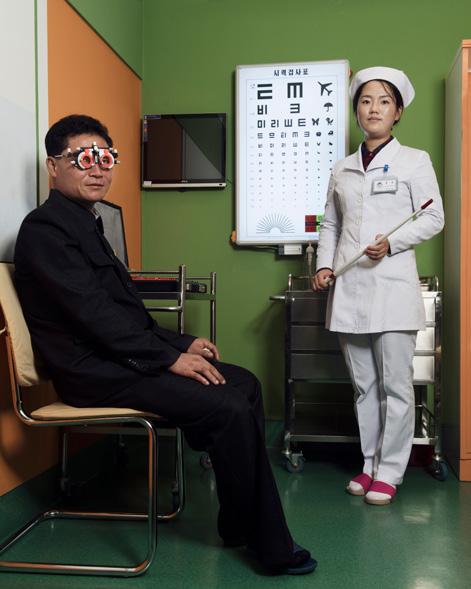
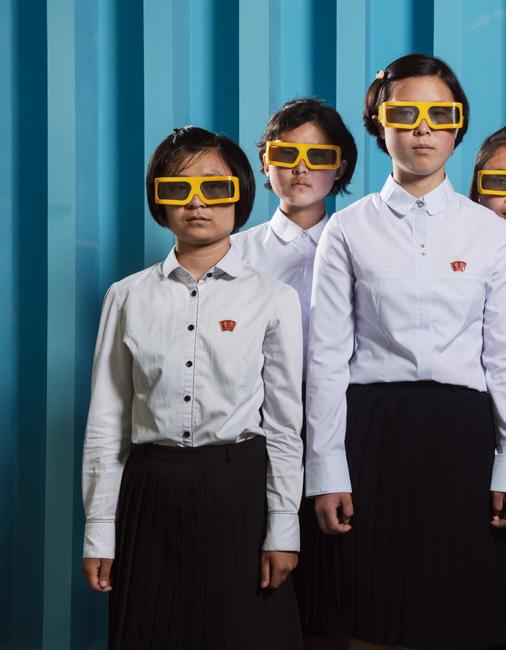
North Koreans Portraits, Pyongyang, North Korea, June 2018.
Kim Yun Gyong, Han Sol Gyong, Kim Won Gyong, Kang Sun Hwa, and Kong Su Hyang at the SCI Tech Complex 3D movie theater.

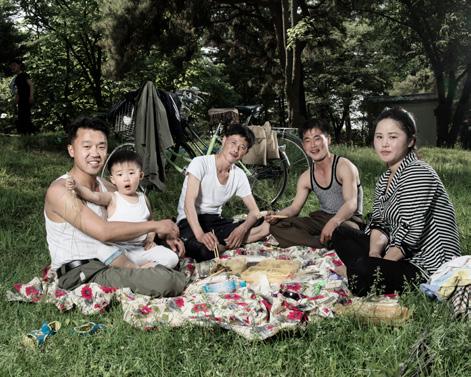
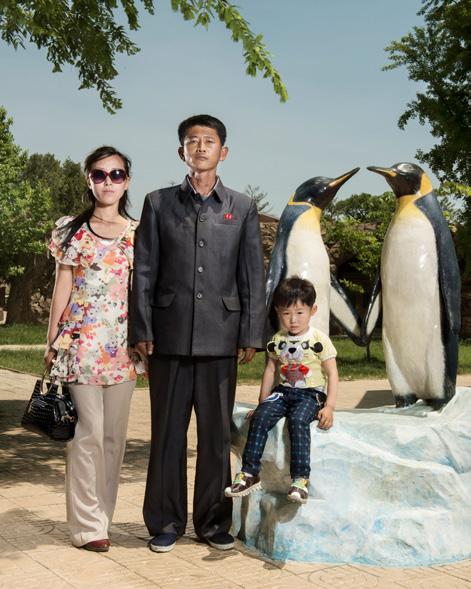
Born 1974 in Hasselt, Belgium. Lives and works in Belgium and Tokyo, Japan.

Anton Kusters is a multidisciplinary visual artist whose work explores the difficulties of representing trauma, loss of the experience of place, and acts of commemoration. He obtained a master’s degree in political science at KU Leuven. In 2019, The Blue Skies Project, a long-term mixed media installation across several platforms, was installed in the United States Holocaust Memorial Museum. His work is part of the public collections at V&A Museum London, ICP Museum New York and FOMU Antwerp. He was a finalist of the Deutsche Börse Foundation Photography Prize in 2020. His continued focus lies on the significance of viewer and subject position.
The Blue Skies Project sets out to explore the visualization of trauma and how its fading memory can be recorded. As first-hand memories and direct experiences of trauma wither, their testimonies intertwine with factual recorded data, historical photography, dramatization, false documentation, and fake news in a post-truth digital age, and turn into an archival collective memory. Showing memory’s frailty in this complexity transforms the quest of post-event witnessing and seeking understanding into an act of reflection.
Kusters traveled 177,828 kilometers to every corner of the former Third Reich over a period of six years to capture the blue sky above every known location of the 1,078 official Nazi Germany’s SS concentration camps. Most of these sites remain unmarked to this day. To locate every site and make sure that the sky above would be blue, he relied on a combination of GPS and live satellite infrared cloud cover footage, manually blind-stamping the coordinates and estimated number of victims into every image made.
His detailed research relies on the seven-volume publication Encyclopedia of Camps and Ghettos 1933–1945 by the United States Holocaust Memorial Museum. In a project loaded with such vast numeric data, the installation touches upon the memory of each victim through a computer-generated audio/visual work by Ruben Samama. Lasting almost thirteen years, the period from the opening of the first camp to the closing of the last one, the piece enters into a dialogue with the displayed polaroids. Samama’s piece generates an individual tone for each victim, the pitch varying according to the camp at which the victim was located.
The blue skies will eventually fade into emptiness. Their numbers will always remain. Attempting to exhaustively witness a memory leads to impossible expectations of understanding. The work deals with this failure by opening a space for reflection between the fractures of evidential specificity and the abstracted trace of the blue skies above.

Top Taucha | 0001261 | 51.377620, 12.477593 (EX) from The Blue Skies Project
Bottom Auschwitz II-Birkenau | 1471595 (est.) | 50.034568, 19.181185 (EX) from The Blue Skies Project
Alderney (Kanalinsel) (SS-BB I) | 0000700 (est.) | 49.704799, -2.218568 (EX) from The Blue Skies Project
Danzig (Schulemann) | 0000025 | 54.349522, 18.641100 (AP) from The Blue Skies Project
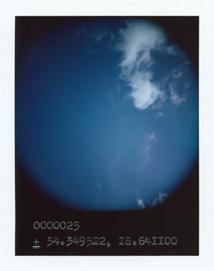
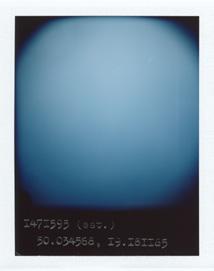
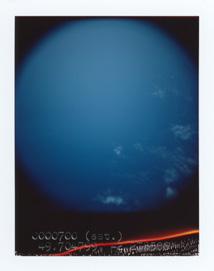
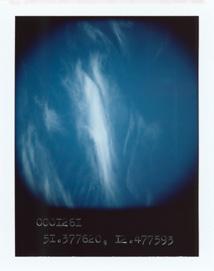
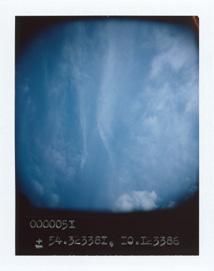



Stefen Chow, born 1980 in Kuala Lumpur, Malaysia.
Huiyi Lin, born 1980 in Singapore. Live and work in Beijing, China.
Stefen Chow is a visual artist, while Huiyi Lin has a background in economic policy and graduated from the Tsinghua University – MIT Sloan School International MBA Program. Since 2009, the crux of Chow and Lin’s practice has rested in their methodology of statistical, mathematical and computational techniques to address global issues. Through a typological, photographic approach, Chow and Lin’s projects are driven by their discursive backgrounds in economics, public policy, and media. Their works have been referenced by the World Bank and showcased at Lianzhou Foto, Les Nuits Photographiques, the CAFA Museum, Gexto Photo, the Hermitage Museum, the NUS Museum (Singapore), and United Nations (Bangkok).
The Poverty Line uses the universal lens of food to examine the daily choices we would face living at the poverty line. Over the last 10 years, artists traveled 200,000 kilometers to create case studies of 36 countries and territories spanning 6 continents. Each country’s figure is based on the official poverty definition to generate a per-person, per-day rate. For middle- and high-income economies, the average low-income household food expenditure is taken into account, while for low income economies, the entire daily income of a poor individual is used. Food items are procured from local markets using these monetary amounts. Each case study comprises different food groups including vegetables, fruits, grains, protein, and snacks. Each photograph beckons scrutiny while inviting the observer to try to make sense of the whole. Individual portraits of food items bathed in dramatic light imbue a few bananas, scattered rice grains, or a leg of chicken with existential meaning.
Newspapers filled with international headlines screaming for attention are used as monotonous backdrops. They reflect our incessant obsession with information in a format that questions its relevance. From 2004 to 2018, 1,800 US local newspapers disappeared or merged. This seismic shift in the dissemination of information has impacted accessibility in an increasingly connected and distracted civilization.
The Poverty Line is a growing conversation that investigates our understanding of poverty and inequality. Covering various cultures and economic systems, it confronts the viewer with objective, non-emotional observations of our own circumstances framed against the fragile balance of social structures, growth, and divide in an entangled globalized world.

Publication Le Seuil de pauvreté, Actes Sud, 2020.
Winners of the 2019 Luma Rencontres Dummy Book Award.
With the support of the National Arts Council, Singapore.
The publication of this book was made possible by the Luma Foundation, the Rencontres d’Arles with the collaboration of Éditions Actes Sud. And the support of Lars Müller Publishers and the Ayam brand.
United Arab Emirates, Dubai, September 2014. AED 11.08 (USD 3.02, EUR 2.30) for food.


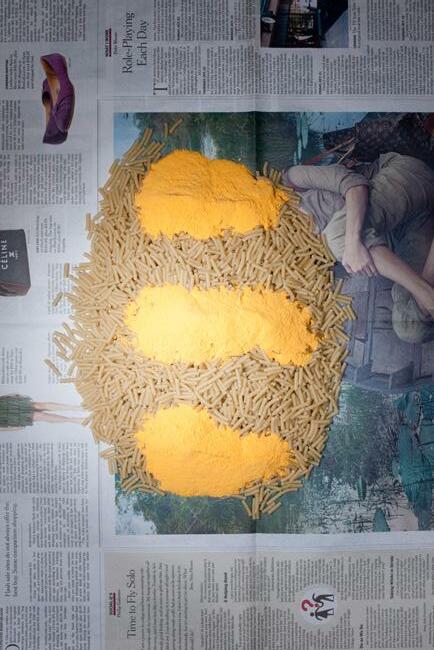
Africa State of Mind: Hybrid Cities explores the African metropolis as a site of rapid social transformation. The exhibition brings together imagery by a new wave of photographers from across Africa. Their work looks both outward and inward, conjuring thrilling visions of the urban environment that reflect on the continent’s colonial past and globalized present. In the process, their work reveals Africa as a territory of the imagination —a state of mind as much as a physical location.
Hybrid Cities depicts the African city in the midst of accelerated development. By 2030, more than half of Africa’s population will be living in urban areas for the first time in history. The continent’s three largest cities— Kinshasa, Lagos, and Cairo—can already be classed as “megacities”, conurbations with populations of over 10 million. That number is set to double in the next decade.
Amid rapid urbanization, characterized by ceaseless flows of people, goods, and capital, a state of permanent change reigns. Within the apparent chaos of crowded streets, the photographers in the exhibition discover unexpected forms of pattern and color. In the sprawl of the metropolis, they capture the African city as an endlessly regenerative site of paradox, possibility, and everyday beauty. The exhibition sits within a larger curatorial project, Africa State of Mind (Africa 21e Siècle in French) by writer and curator Ekow Eshun.

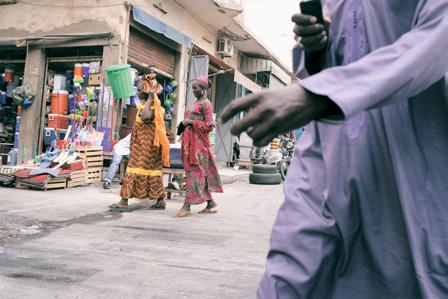

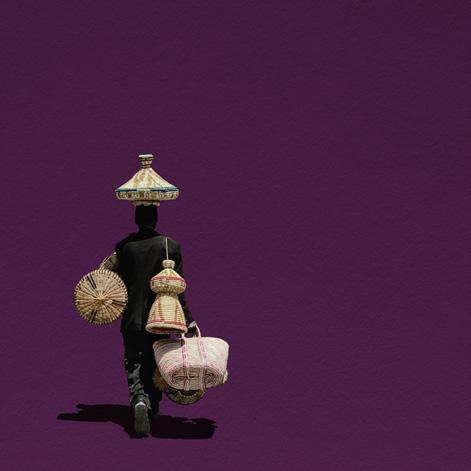

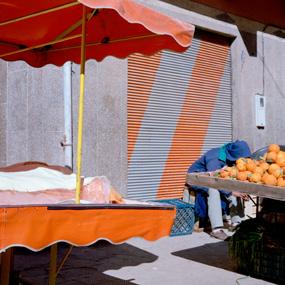

Enrique Ramírez
Born 1979 in Santiago, Chile. Lives and works in Paris, France, and Santiago.
Enrique Ramírez studied popular music and film in Chile before joining the Studio National des Arts Contemporains-Le Fresnoy in Tourcoing, France, in 2007. He won the Prix des Amis du Palais de Tokyo, Paris, France in 2013, and was nominated for the Prix Marcel Duchamp in 2020. He has exhibited at the Palais de Tokyo and Centre Pompidou, Paris; Museo Amparo, Puebla, Mexico; Museum of Memory and Human Rights, Santiago, Chile; MATTA Cultural Centre, Buenos Aires, Argentina; and Grand Café in Saint-Nazaire, France. In 2017, Christine Macel invited him to participate in the Viva Arte Viva exhibition at the 57th Venice Biennale.

Throughout Enrique Ramírez’s work, the sea is the place of instability par excellence: a memorial territory in perpetual motion, a space of narrative projections where Chile’s destiny and the great stories of history linked to voyages, conquests, and migratory flows intertwine. Ramírez incessantly recalls the personal and collective experience of growing up under Augusto Pinochet’s dictatorship, including in his films Brisas (2009) and Los Durmientes (2014).
A new eponymous piece, coproduced and directed by Ramírez and seven students, has joined the works in Migrant Gardens It is a poetic rewriting of an epistolary exchange between the students and some hundred Arles residents during the second lockdown in November 2020. These questions were asked: What is your most distant memory? What would you ask of memory? What is the first place you see when you close your eyes? What images would you like to wish into existence? What image makes you feel joyful?
Migrant Gardens borrows written words and images from several replies to form a visual and narrative, poetic and political reconstruction of the imaginary spaces that inhabit memory, desire, and experience.
Exhibition curators
Charlotte Arthaud, Estelle Blenet, Mariano Bocanegra, Léonard Contramestre, Jingyu Cao, Elena Corradi, Marta Gili, Franck Hirsch, Thomas Pendeliau, Juliette Vignon.
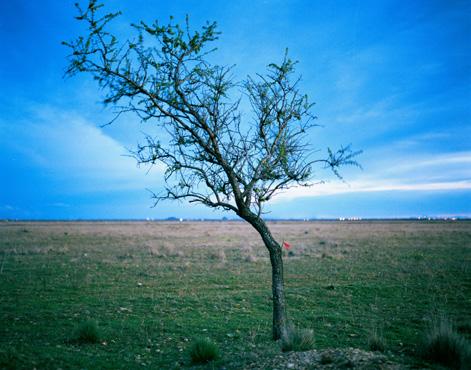
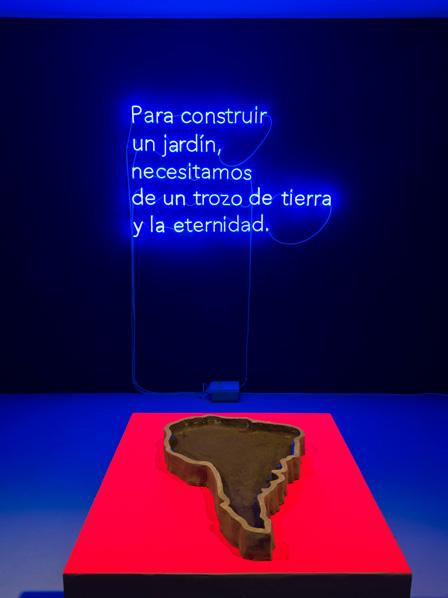
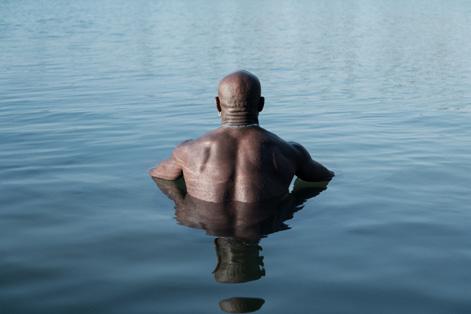


Born 1903 in Paris, France.
Died 1999 in Paris.
Designer, architect, and photographer
Charlotte Perriand was a furnishing and interior designer for Le Corbusier’s studio from 1927 to 1937. She collected and used photography in all its forms to study architecture and nature, and promote her vision of a better life. From 1940 to 1946, she lived in Japan and Indochina. Back in France, she took part in the reconstruction effort and in the 1960s, worked on Les Arcs ski resort. She designed furniture and interiors for museums and private clients until the end of her life.
Charlotte Perriand devoted her life to improving the living conditions of as many people as possible, creating an “art of living” in connection with nature. She used photography not only as a tool for observing reality, but also to promote her conception of a new world. Echoing our current concerns, in the 1930s, she used sweeping photomontages to denounce unhealthy urban conditions and present her vision of how life could be made better.
She stressed the role of campaigns and worked for the advent of better times in the spirit of the Popular Front and progressive movements such as the Association of Revolutionary Writers and Artists, to which she belonged. Her striking photographic frescoes, including Le Grande Misère de Paris (Poverty-stricken Paris, 1936) and the Minister of Agriculture’s waiting room and the Ministry of Agriculture’s pavilion at the Exposition Internationale des Arts et Techniques dans la Vie Moderne (1937), created with Fernand Léger, attest to her modernity. They combine anonymous press agency shots and work by photographers such as François Kollar and Nora Dumas with statistics and poetry.
How Do We Want to Live? The Politics of Photomontage offers insights into her idea of the world through her working methods and incredible collection of photographs—original prints, negatives, magazine clippings, and personal photographs— on display for the first time, set against recreations of her monumental photomontages.
Damarice Amao, with the complicity of Sébastien Gokalp and Charlotte Perriand Archives.
Publication
Charlotte Perriand, Politique du photomontage, Comment voulonsnous vivre ?, under the supervision of Damarice Amao and Emmanuelle Kouchner, Actes Sud, 2021.
Wallpapers Processus, Paris.
Framing Circad, Paris.
Unless specified otherwise, all the original documents and prints presented in this exhibition are from the Charlotte Perriand Archives.

Charlotte Perriand and Fernand Léger, photomontage for the Ministry of Agriculture Pavilion, Exposition Internationale des Arts et Techniques dans la Vie Moderne, Paris, 1937. Panel to the right of the entrance, Industrial France. Contemporary recreation of colors.
Charlotte Perriand Archives (AChP)/Adagp, Paris, 2021.
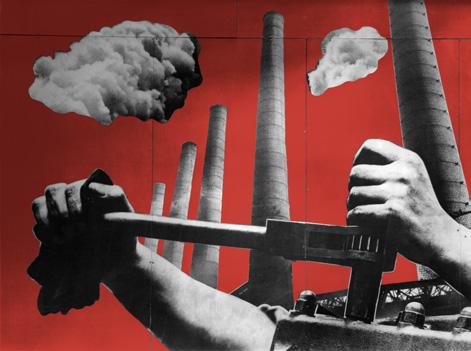
Details of La Grande Misère de Paris (1936) from a contemporary recreation by Jacques Barsac (2010) based on period documents and photographs, restoring the colors according to the guidelines of the International Congress of Modern Architecture. Adagp, Paris, 2021.

Following pages
The Ministry of Agriculture waiting room, Paris, 1936. Photo murals by Charlotte Perriand. Furniture by André Arbus. Photograph by François Kollar. Charlotte Perriand Archives Collection (AChP)/ Adagp, Paris, 2021.

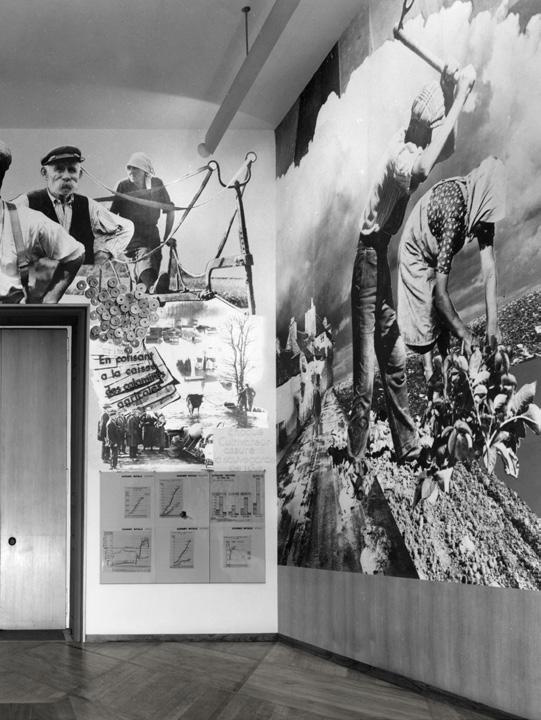
Born 1924 in Saint-Gingolph, Switzerland. Lives and works in Paris, France.
Sabine Weiss is a humanist photographer known for her keen observation of life and feelings as well as her street photography. Her work has been featured in many solo shows, notably at the Art Institute of Chicago, Fondation Nationale de la Photographie, Rencontres d’Arles, Maison Européenne de la Photographie, Jeu de Paume-Château de Tours, and Centre Georges Pompidou, as well as in group exhibitions at the Museum of Modern Art in New York, the Bibliothèque Nationale de France, and the Musée d’Art Moderne de Paris. She is represented by Les Douches la Galerie in Paris. Her archives will go to the Musée de l’Elysée in Lausanne.
For several years, Sabine Weiss has been recognized and honored as the last representative of the French humanist school. Her exhibitions, books, media appearances, optimism, and joyful longevity have endeared her to the general public. Yet few people are aware of the richness her archives, carefully preserved in the small house-studio where she has lived for over seventy years. Describing herself as a photographer-artisan and a witness rather than an artist, the ninety-six-year-old has built a true photographic monument in a free and independent spirit. Born Sabine Weber in Saint-Gingolph, Switzerland in 1924, she began her career at the age of eighteen as an apprentice at the Boissonnas studio in Geneva before becoming photographer Willy Maywald’s assistant in 1946, in Paris. She settled there permanently and started freelancing in 1949, when she met American painter Hugh Weiss. In the following decade, when the illustrated press and consumer society were booming, she worked intensively and uninterruptedly in France as well as internationally. In the 1960s and 1970s, she refocused on advertising and color commissions. from the 1980s to the 2000s, she resumed her personal work in black and white and traveled the world.
This unprecedented retrospective in the Museon Arlaten’s recently restored Jesuit chapel highlights the main features of her oeuvre, constantly in sympathy with human beings, as well as various facets of the photographer’s profession, from reportage to illustration, fashion, advertising, portraits, and personal work. Sabine Weiss has approached every area of photography as a challenge, a pretext for encounters and travels, a way of life and a means of self-expression. the exhibition reflects this life-long passion with a new selection of images, films, and personal documents.
Exhibition curator
Virginie Chardin.
Publication Sabine Weiss, Actes Sud, 2021. Introduction by Virginie Chardin
Silver prints
Atelier Publimod and La Chambre Noire, Paris.
Documents and facsimiles Processus, Paris.
Framing Circad, Paris.
Sabine Weiss received the Women In Motion Award for photography

2020, awarded by Kering and the Rencontres d’Arles for her entire career.
With support from the Swiss Confederation and the Swiss Arts Council Pro Helvetia.
Unless otherwise specified, all modern silver prints presented in this exhibition are produced under the control of Sabine Weiss.
Exhibition venue Chapelle du Museon Arlaten – Musée de Provence.
Portrait Joel Saget/AFP.
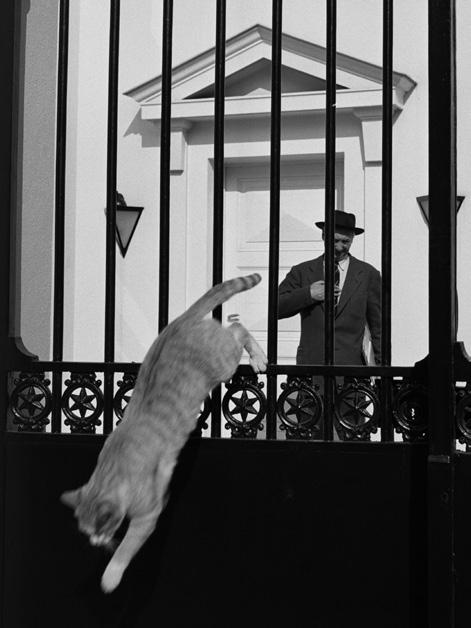
Top Transvestites, Pigalle, Paris, 1959.
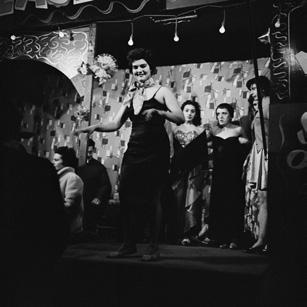
Bottom Colony for the mentally ill, Dun-sur-Auron, Winter 1951–1952.
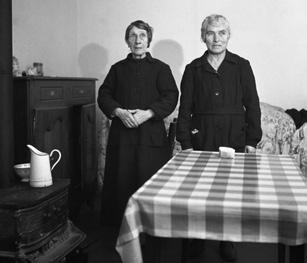
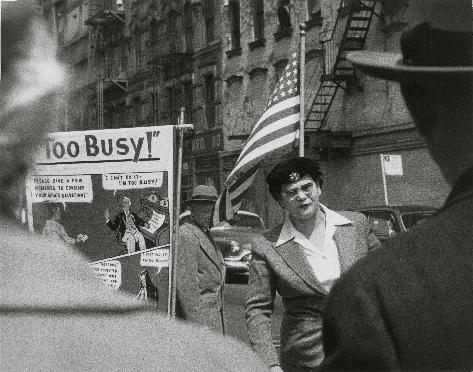
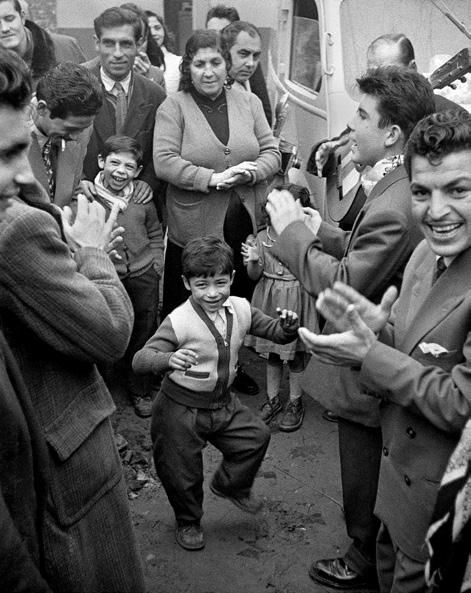
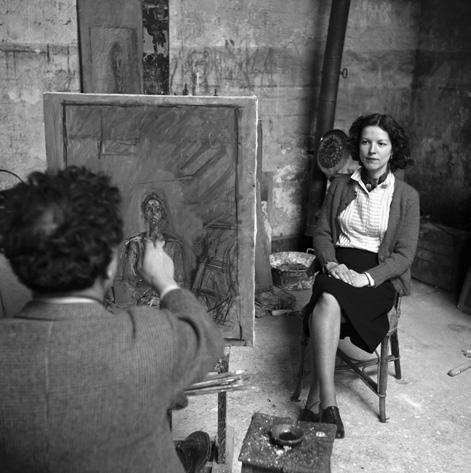 177 Giacometti drawing his wife, Annette, Paris, 1954.
177 Giacometti drawing his wife, Annette, Paris, 1954.
“We’ll put jazz musicians in the same spotlight that other magazines, like Match, put movie stars,” Daniel Filipacchi said when he became head of Jazz Magazine in 1956.
At the time of racial segregation in the United States, which officially lasted until 1964, and the difficult decolonization process undertaken by France, French periodicals seldom put African-Americans on their covers. But in December 1954, Jazz Magazine set a new tone by featuring Lionel Hampton on the front of its first issue, without, however, mentioning his name. Was that because he was already famous? Was it an invitation to discover the jazz giant, whose unequivocal words affirmed that his music was the music of anger?
From the outset, the young team at the monthly magazine founded by Nicole and Eddie Barclay advocated musical borrowing and cultural exchange. It bore ardent witness to the US civil rights movement as well as discrimination against African-Americans on both sides of the Atlantic. The magazine quickly became a laboratory of experimentation, taking opinionated stands under its editors, Frank Ténot and Daniel Filipacchi—fiery, ambitious friends, fascinated by jazz and Afro-American counterculture, which they introduced to pleasure-seeking French youth hungry for American modernity. Surrounded by enthusiasts, they played an active part in building “legends” in France, consecrating and humanizing musicians and singers, distancing stars and carefully revealing what goes on backstage at exclusive clubs. Jazz Magazine’s writers and photographers conveyed impressions, reported knowledge, published unprecedented images of a fantasized America, invented new forms of journalism, and defined the ideal jazz fan. For two decades, they legitimized jazz as a form of culture, consecrating the music and revealing its eminently political dimension.
Top Thelonious
Bottom “On the Side of Black America” by Jean-Marie Périer, Jazz Magazine 190, July 1971.
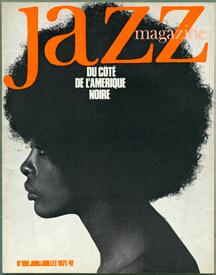
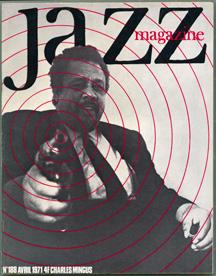

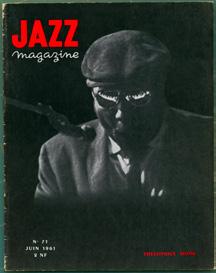
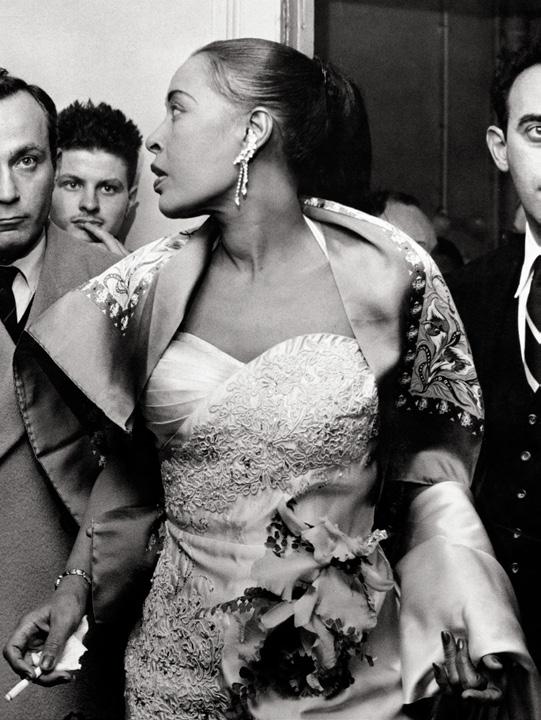
Top
Bottom “Crazy Babs,” Jazz Magazine 99, October 1963. Photograph by Jean-Marie
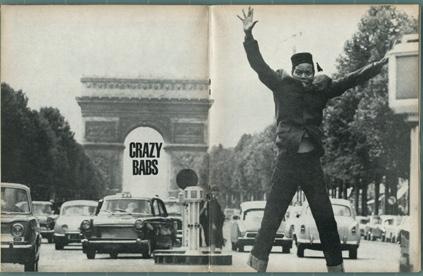

Many tales, fabricated or based on facts, have been told about the Orient Express, a technological achievement turned into a cultural icon. Some have become legends, drowning historical reality in imaginative stories. It all started with the International Sleeping-Car Company, which ran the Orient Express, the world’s first international luxury train, between Paris and Constantinople, later Istanbul, from 1883 to 1977. Its creation was a true diplomatic and economic feat at a time when empires and states used railways as an instrument of political power. Constantinople was not chosen by chance: the city was the gateway to an Orient that captured the imaginations of late 19th-century artists and writers. The train’s destination was a potent publicity tool for the company.
The photographs in the Orient-Express & Cie exhibition come from the archives of the former International Sleeping-Car Company. Pictures, plans, maps, technical drawings, and advertising brochures saved by former employees during the company’s various reorganizations put the Orient Express into its historical context. The iconographic archives—photo albums, industrial, and commercial photographs—are fragmentary but very valuable. Most are anonymous, others the work of famous studios, such as Paul Nadar, Albert Chevojon, and Sebah & Joaillier. Some advertising images have already been widely disseminated; others are being shown for the first time. This show traces the history of the Orient Express.
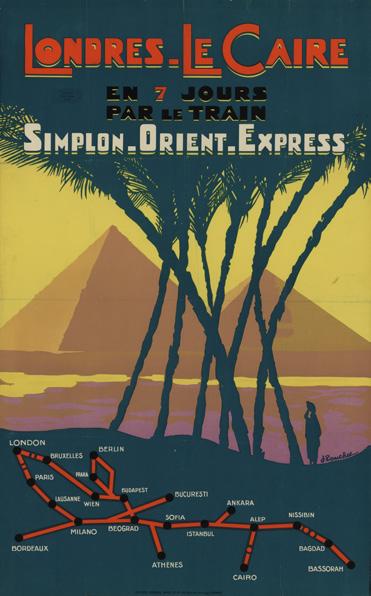
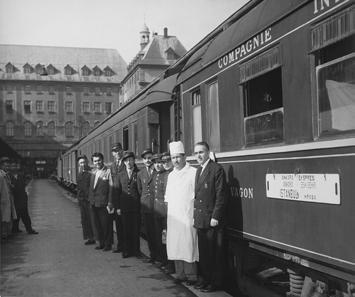
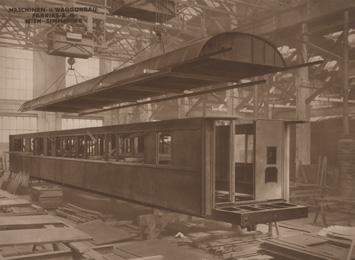

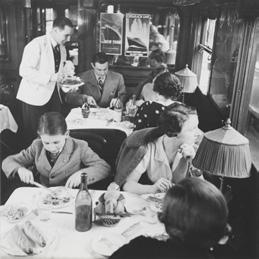
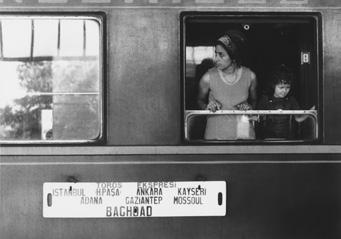
A Woman is a Woman , Jean-Luc Godard, 1961. Paris, 1960. Anna Karina (Angela Récamier). The cameraman takes a light measurement.
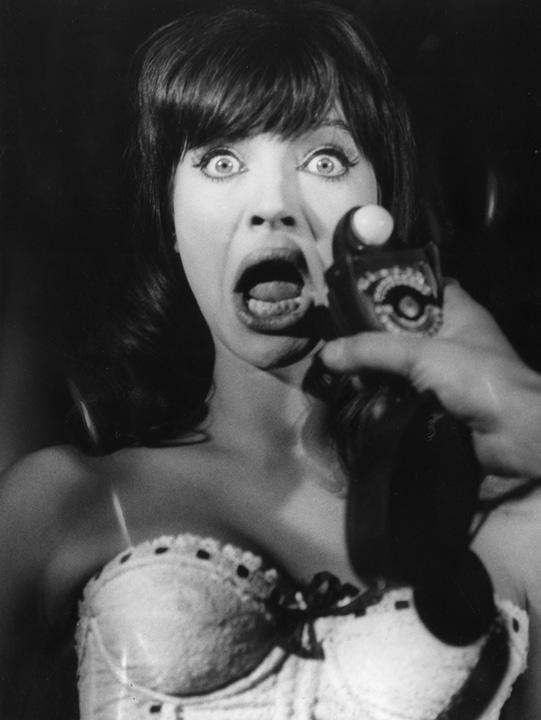

Raymond Cauchetier
Born 1920 in Paris, France. Died 2021, Paris.
Raymond Cauchetier discovered photography at the age of twenty-five, when he created the French Air Force’s press service in Indochina. His first album, Ciel de guerre en Indochine, published in 1953, was highly successful. His work has been presented in Japan, where he is considered a major photographer, and the United States. The 1961 Smithsonian Institution show Faces of VietNam toured America for two years. In the late 1950s, he began shooting film sets and within a few years became the unofficial photographer of the New Wave. Today, his cinema photographs are exhibited worldwide.
Raymond Cauchetier’s most familiar works are his photographs of French New Wave icons: Jean Seberg and Jean-Paul Belmondo wandering down the Champs-Élysées in Breathless, Jeanne Moreau’s ascending smile (later the film’s poster), and the race across the Passerelle de Valmy in Jules and Jim, as well as portraits of Anouk Aimée dressed as Lola. More than just set photographer for Godard, Truffaut, Demy, Rozier, and Chabrol, Cauchetier embodied New Wave insolence by rethinking the frame of set photography. He walked into the frame, had scenes replayed, and documented all that preceded or surrounded a take. We’re on the set with him alongside Godard, pushing a cart bearing a hunched-up cameraman for a tricky tracking shot. We’re with the tech crew on Adieu Philippine, piled into the Citroën 2CV: “Ideal for replacing the conventional dolly on tracking shots, as long as it was heavily charged and its tires deflated,” said Cauchetier.
In the late 1950s and early 1960s, a young generation of filmmakers made their directorial debuts, shooting their first feature films and breaking with the customs of film production. It was a revolution in the way film is made, extolling working on-the-spot, the trademark of the French New Wave—and Cauchetier was the set photographer-reporter who captured the birth of this cinema-in-the-making. His photos, most of which sat in boxes at production companies for over half a century, are today’s testimony to a cinema that established and asserted a new imaginary, a modern mythology.
With legendary shots and new discoveries, this show is a journey through the images of cinema taken by Cauchetier, who died earlier this year, taken on the sets of New Wave films.
Jules and Jim, François Truffaut, 1962.

Wednesday, April 26, 1961, 9:00 a.m., Passerelle de Valmy, Charenton-le-Pont.
In the old days, I still worked with the Rolleiflex, my faithful servant during the Indochina campaign. Since it had no motor, I had to turn the crank of the camera after each shot in order to photograph this scene that became so famous—so I was only able to take one shot from the end of each of the four races that Truffaut filmed successively. I had to determine the 500th of a second that seemed the best, like a sports photographer. The last shot was the best.
Adieu Philippine, Jacques Rozier, 1960.
For those who don’t know, a tracking shot happens on a kind of track where a rolling platform carrying the camera and its operator moves, pushed by a stagehand. This system allows the actors to be filmed fluidly while in motion. But the equipment is heavy, cumbersome, and renting it is expensive. The French New Wave had to come up with cheaper solutions to achieve the same result. Roger Mathelin, director of photography on Adieu Philippine, discovered that the Citroën 2 CV’s suspension was ideal for replacing the conventional dolly on tracking shots, as long as it was heavily charged and its tires deflated . That’s why he put the whole tech team into the car to turn down a bumpy road in the small town of Calvi in Corsica. When you don’t have money, you need ideas.

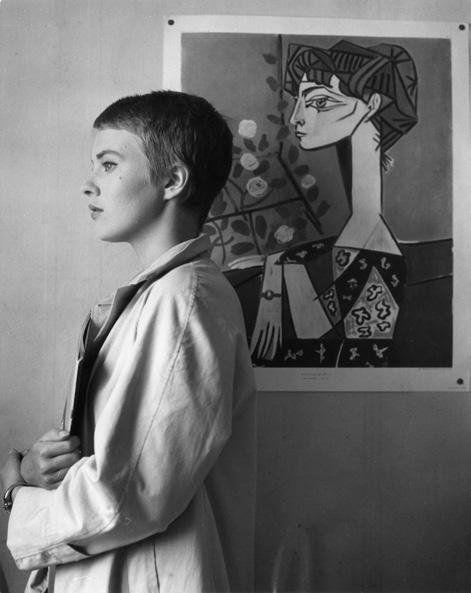
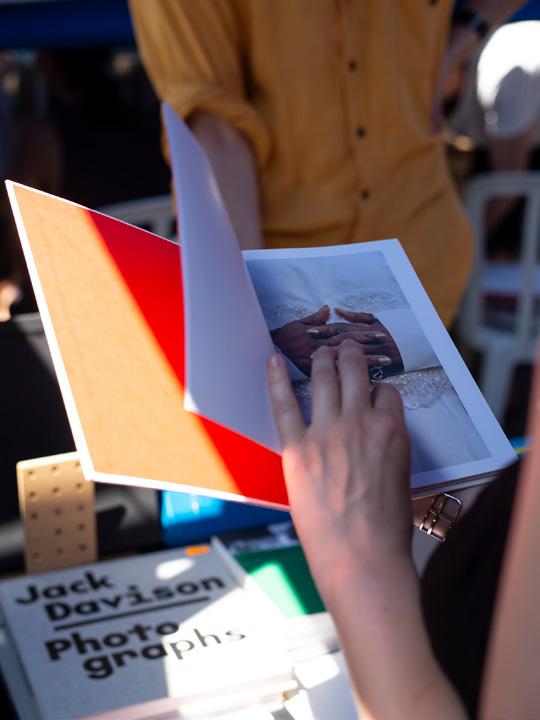
1950: Robert Delpire was twenty-four years old. As a medical student, alongside Pierre Faucheux and Michel Ragon, he started the review NEUF, distributed by the Maison de la Médecine. It was the beginning of a singular venture in publishing that lasted three years and nine issues. Articles penned by Guillaume Apollinaire, André Breton, Blaise Cendrars, Jean Cocteau, Henry Miller, and Jean-Paul Sartre mixed with illustrations by Savignac, André François, and Raoul Dufy, and photography by Brassaï, Doisneau, Cartier-Bresson, Robert Frank, Izis, and more. In less than two years, the illustrated review, targeting doctors interested in art and the “image,” started publishing books by photographers and artists, and gave birth to Delpire publishing.
The exhibition NEUF from A to Z selects twenty-six words (Brassaï, Circus, Mask, Advertisement, Games, Sports, etc.) and as many stories to recount the foundations of photographic publishing and the unprecedented creative momentum that stimulated the postwar period.
Using a visual and typographical approach, with around one hundred emblematic double-page spreads from the review, original copies, and other material from the times, the exhibition recreates NEUF in letter and spirit, and tells the story of the early days of Robert Delpire in the field of publishing. This exhilarating exploration unveils Delpire’s foundational practice from different perspectives, through collaborations, friendships, and the subjects and passions that followed him throughout his career.
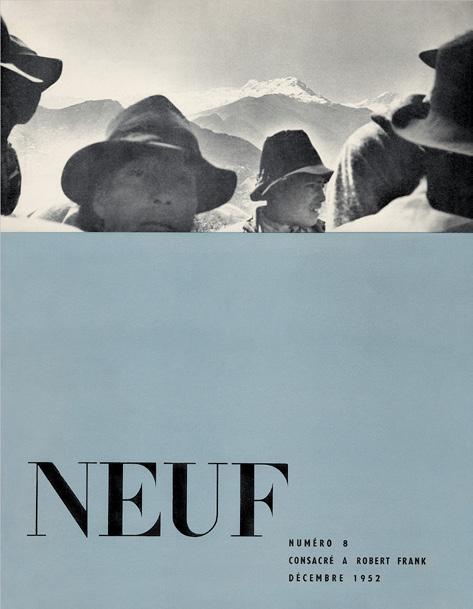
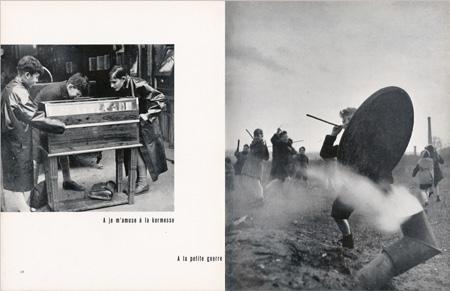
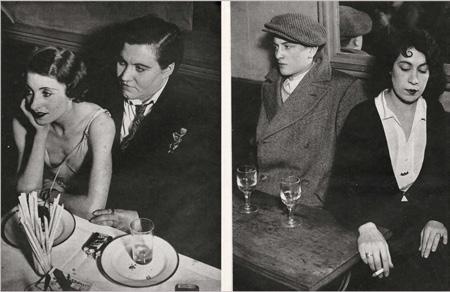
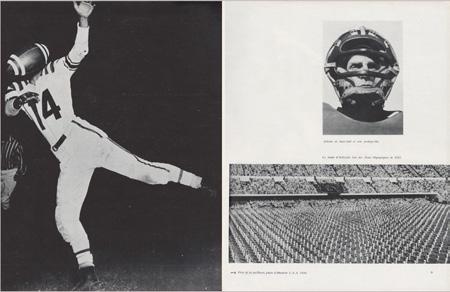
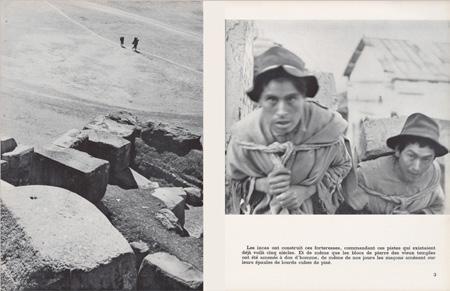
The Rencontres d’Arles Book Awards were created to support the publishing of photography books, a swiftly growing domain, and to help these publications reach a broader public. There are now three categories of book awards: Authors’ Books, Historical Books, and Photo-Text Books. The Fondation Jan Michalski pour l’Écriture et la Littérature backs and encourages the Photo-Text Award, which celebrates the relationship between words and images.
Each award comes with a €6,000 prize and singles out the best photography books published between June 1, 2020 and May 31, 2021.
A pre-jury and a jury of photography experts will choose the shortlisted works and the Book Award winners.
Each book submitted is deposited in the library of the École Nationale Supérieure de la Photographie d’Arles. The shortlist is presented to the public in a dedicated space throughout the festival, and the Book Award winners are announced during opening week.
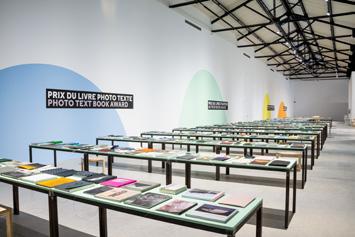
Since 2015, the Rencontres d’Arles has offered an award supporting the publication of a dummy book. This prize, with a production budget of €25,000, is open to any new photographer or artist using photography, submitting a previously unpublished dummy book. Special attention is paid to experimental and innovative publication forms. The recipients of the 2020 edition of the award were Yto Barrada and Bettina for Bettina. In 2019, Chow & Lin were awarded for their project The Poverty Line, which is exhibited this year as part of the festival (see p. 150). In 2018, it was Marina Gadonneix who received the award for Phénomènes, and a special mention was given to the dummy book by Indré Urbonaité (State of Shame). In 2017, Olga Kravets, Maria Morina, Oksana Yushko, and Anna Shpakova received the award for Grozny: Nine Cities. In 2020, 194 publications from 34 countries were received. The 2021 winner will be announced during the opening week.


Born 1976, Trier, Germany. Lives and works in Reykjavik, Iceland, and Luxembourg.

Daniel Reuter’s work in photography takes up the notions of landscape, space, and place in their relationships to narrative, perspective, and subjective experience. His first book, History of the Visit, was nominated for the 2013 Paris Photo–Aperture Foundation PhotoBook Award, and was followed by Circle Square (2017), Beachhead (2020), and Providencia (2020).
Lisa Kohl
Born 1988, Luxembourg. Lives and works in Leipzig, Germany, and Luxembourg.

Lisa Kohl graduated from two artistic programs in Belgium and Germany. Her art takes various forms: collaborations with performing arts practitioners, photo series, sculptural installations and audiovisual performances. Created at unique locations in Greece, California, or the Mexican border, her photo work has been praised through several awards: a nomination for the Edward Steichen Award (2019) and winner of the Prix Pierre Werner (2020).
Providencia—providence—in its biblical meaning, describes God’s intervention in the universe, beyond human control. The Providencia neighborhood of Santiago de Chile provides both the setting and the title for this new series by Daniel Reuter. His work explores the signs of a recently exposed divergence, starting from a visually prosaic urbanity: architectural details, makeshift structures, trees, foliage, and construction site hoardings that obstruct the view. In the aftermath of civil protests, we encounter subjects confined within the complexities of their own existence. Resonating with his research on identity and memory, Reuter draws on this charged topography to translate its textures, reflections, and light. At the Chapelle de la Charité, twelve large-format images enter into dialogue across a hexagonal structure inspired by a modernist kiosk in the Providencia district.
Lisa Kohl’s work speaks of escape, exile, the non-places of life or survival, invisibility and absence. With great daring, she succeeds in linking reality to poetry. Through the poetic aesthetics of images, she invites us to reflect on identity, homelands, crossing borders, futility and hope. In presence and absence, her work touches on contradiction. It’s about changing perspectives: showing the invisible and giving voice. Kohl looks for balance in delay and transition. She proceeds by creating images, experiences that can be shared, tracks to follow. The project Erre, on the lateral nave of the Chapelle de la Charité in Arles, is an installation composed of three new works. The sound and video installation Haven (2021), projected on the ceiling, communicates with two photography series: Shelter (2019) and Passage // 32°32’04.7’’N 117°07’26.3’’W (2019), presented with backlighting.
Exhibitions curators
Michèle Walerich and Danielle Igniti.
Exhibitions produced by Lët’z Arles asbl (Luxembourg).
Publications Providencia, text
Alejandro Zambra, co-publication Skinnerboox, CNA and Lët’z Arles, 2020.
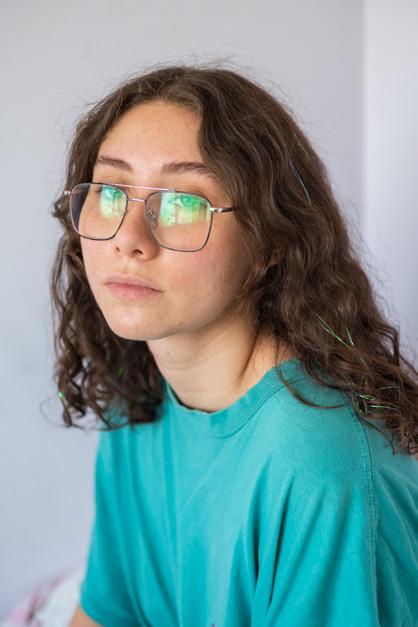
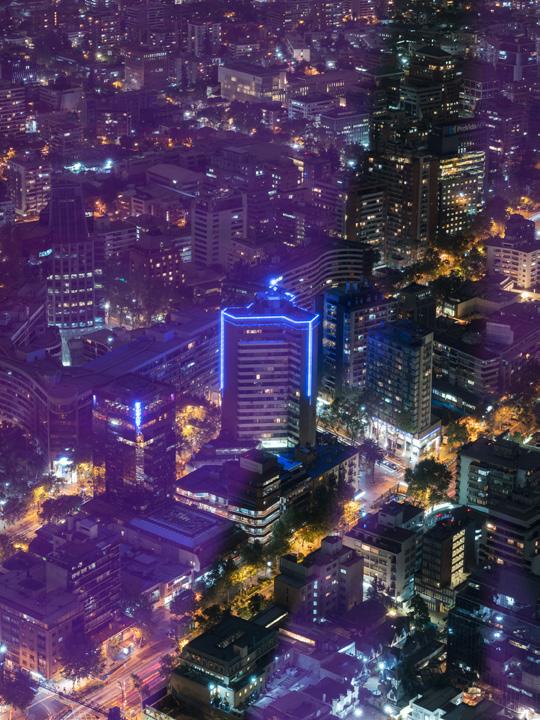
Top Lisa Kohl, from the Shelter series, Los Angeles, United States, 2019. Adagp, Paris, 2021.
Bottom Lisa Kohl, Passage//32°32’04.7”N 117°07’26.3”W, Border Field State Park, United States, 2019. Adagp, Paris, 2021.
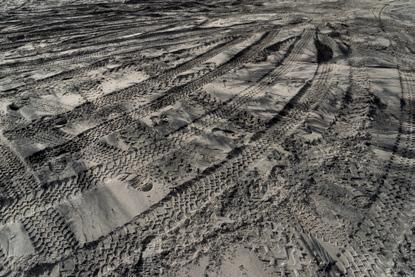
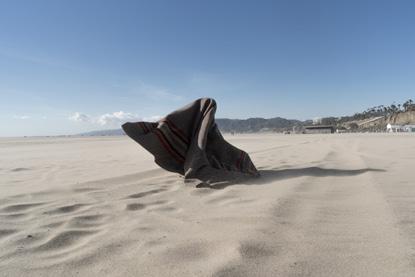
Volumetric photography, otherwise known as photogrammetry, creates stunning images of volumes, spaces, and experiments. Once the exclusive domain of cartography and archeology, 3D scanners, Lidar sensors, and other photogrammetric tools are now available on our phones. By combining them with cameras, what we are used to considering captures of reality become embodied images, or “hyperimages,” as Alan Warburton calls them: increasingly complex assemblies of light and algorithms.
By capturing the photo-realist surfaces of cinema and photography and combining them with the digital, multidimensional forms of video games, volumetric photography seems to be the link that has been missing until now. A new path to the perception of reality is opening up between Ludwig Wittgenstein’s “third way” and Maurice Merleau-Ponty’s “absent column.”
In the company of photographers-turned-visual artists, the exhibition navigates between clouds of dots and polygons that draw virtual environments, avatar-portraits, and hybrid bodies, telling new, embodied stories. Along the way, viewers discover that the lines that seem to separate objects and their representations are blurred in a techno-animism, calling the foundations of our binary understanding of the world into question. These image-worlds seem to ask the questions: What is the stuff of reality? What is the virtual world made of?
The show multiplies artists’ viewpoints to situate these new images in contemporary culture and meet our need to better understand, deconstruct, and feel these ways of seeing.
Finally, by echoing the works, the exhibition deciphers the technologies and processes involved in reconstructing volumetric images, making them accessible to visitors as a means of interpreting the world that is indispensable at a time when virtual reality plays an increasingly large role in our actual reality.
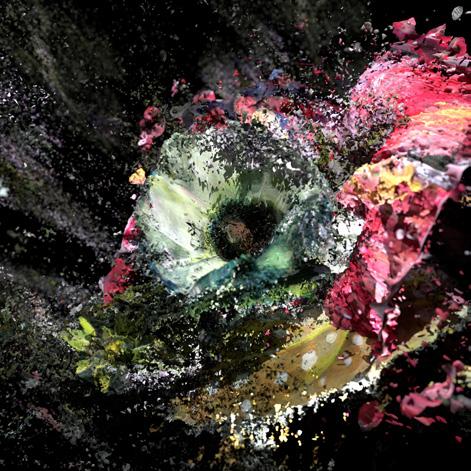
Mathias Benguigui (1991), Jean-Christian Bourcart (1960), Jérôme Cortie (1992), Hoël Duret (1988), Alberto Giuliani (1975), Agathe Kalfas (1989), Elsa Leydier (1988), Philip Montgomery (1988), Manuel Rivera-Ortiz (1968), Niina Vatanen (1977), Anno Wilms (1935-2016), Barbara Wolff (1951), Collection Chaussee 36, Collectif LesAssociés, ParisBerlin>fotogroup.
System Echoes is an exhibition program focusing on the uncertain, changing living world and its intertwining, pronounced, unique local contexts. The artists’ various approaches immerse us in current issues involving migration (Les Chants de l’Asphodèle, Mathias Benguigui and Agathe Kalfas), memory (Sauvegarde retrouvée 2.0, Jérôme Cortie; Cuba, Manuel Rivera-Ortiz), feminism (Les Marques, Elsa Leydier), and decolonization.
Analog and digital images, virtual and augmented reality (Au bord du réel, Jean-Christian Bourcart), and archives (Time Atlas, Niina Vatanen) shape a fresh vision and perception of the living world and the social relations resulting from it. These narratives help us find our place, express our desires, and tame our fears (D’ici, ça ne paraît pas si loin, LesAssociés)—or experience them through expression in violence or elation (American Mirror, Philip Montgomery).
Taking on aspects of individuals vis-à-vis themselves and their geographical or social environments, such as in solitude (Métropolis, Barbara Wolff), regarding gender (Identité et masque, Anno Wilms), or eroticism (Behind Desire, Chaussee 36), Fotohaus’s Persona looks at the notion of the mask, one that each person wears to meet the demands of social life.
This protean group echoes the human and the environmental— an interrelated system facing a multitude of questions today, including those of health (Sauver les corps, ParisBerlin>fotogroup/ LesAssociés), ecology, and politics (Drop Out, Hoël Duret). Through photography and film, these documentary approaches shed light on a world in flux and ask questions about the future of humankind (Surviving Humanity, Alberto Giuliani).
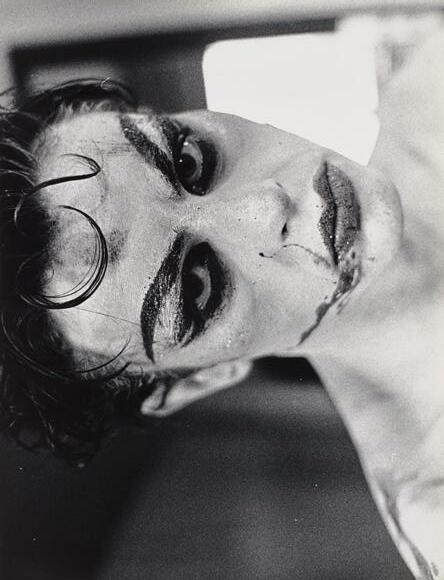
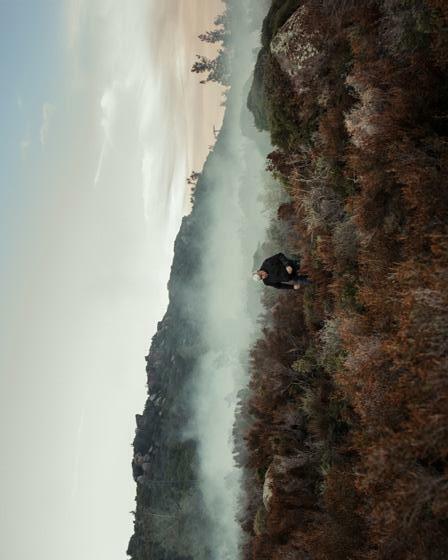
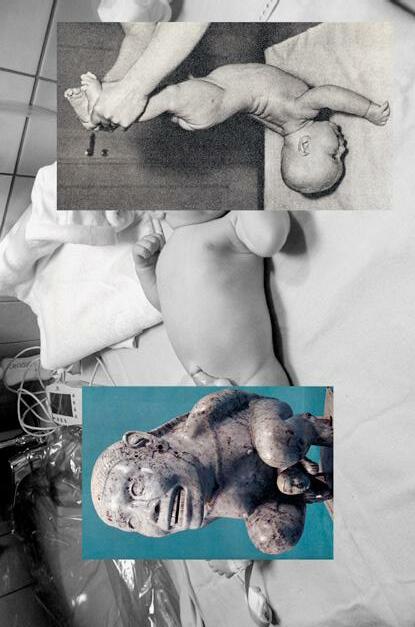
Born 1969 in Saint-Germain-en Laye, France. Lives and works in Ivry-sur-Seine, France.

Jean-Luc Bertini is a renowned portraitist pursuing several long-term projects that regularly take him from East to West. From his first book, Solovki, la bibliothèque perdue to Amérique, des écrivains en liberté, his work questions humanity’s fragile place at the heart of its environment.
For ten years, between 2008 and 2017, Jean-Luc Bertini photographed the United States on and off, traveling the road in all seasons. But can this country still be photographed, considering its visual clutter?
For American Solitudes, he traveled the United States with no preconceived ideas save the formal one of working in color and a 6 × 7 medium format.
In a humanist vein inherited from the French tradition, which allowed him to avoid the “American photographic portrait,” Bertini observed how Americans inhabit a space where, granted, they have a lot of freedom but, as Baudrillard put it, a freedom that shrivels up by engendering anonymity, loneliness, and inequality.
Solitude is the handmaiden of observation. It predisposes Bertini to believe in visions, orchestrations, and stories so that his images sometimes seem to transcend the ordinary scenes they show.
Born 1976 in Nantes, France. Lives and works in Tourcoing, France.

In 2000, Jean-Michel André graduated from the École des Gobelins before pursuing a path at the crossroads of visual art and documentary photography. His approach is based on a political and poetic vision of territory, questioning limits, memory, and development. Exhibitions, artist-in-residence programs, and publications in France and abroad have featured his work. He is represented by Galerie Sit Down.
The series Borders, by Jean-Michel André, is a long-term project looking at the dream of those who flee their homelands for a new El Dorado. As in his previous work, André explores notions of economic and migratory flow.
From Calais to the island of Lampedusa, passing through Spain and Tunisia, he exhibits the courage of these people who have been deprived of their families, displaced due to religious conflict, or climate and economic disaster. A friendly epistolary relationship grew out of a meeting with writer Wilfried N’Sondé, examining writing and photography, imbued with a profound humanity.
Though solitude, isolation, and fear punctuate these stories of broken dreams, a glimmer of hope can always be found. As an involved observer of wandering populations, André offers an act of resistance here. It consists in tirelessly rethinking the place of the human in a time of great global questions, and reminds us of the fragile nature of our civilizations.
Béatrice Andrieux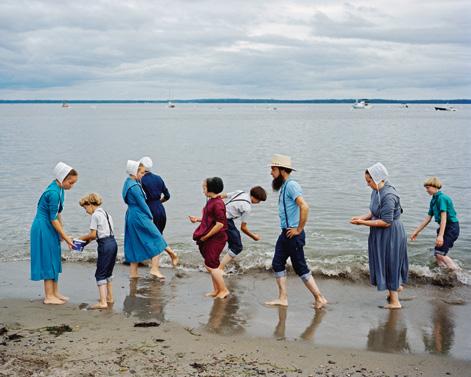 213 Jean-Luc Bertini, Amish, Lincolnville, Maine, 2008.
213 Jean-Luc Bertini, Amish, Lincolnville, Maine, 2008.
 214 Jean-Luc Bertini, Shelby, Montana, 2012.
214 Jean-Luc Bertini, Shelby, Montana, 2012.
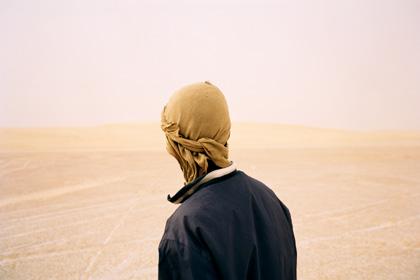
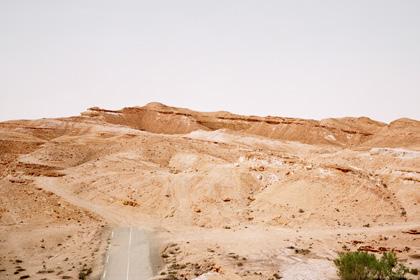
Born 1975 in Paris, France. Lives and works in Paris and Mas-Thibert, France.
Pauline Fargue’s work is permeated by photography, which she subverts to have it resurface on pages, screens, and in installations. She earned a degree in art philosophy and definitively switched to images after meeting Chris Marker, who encouraged her to pursue photography. She then went to photography school. She won the Rencontres d’Arles Discovery Award in 2015.
Panopticon is a work in progress, a small attempt at formulating a critical and poetic statement from within what might be called the carceral syntax of Instagram. With tiny, 6 × 6 cm, endlessly looping sequences, made exclusively with a smartphone, and using the functional requirements of the snapshot application, the subject is indeed one of power and the narrowing range of individual and collective freedoms.
The resulting project, shown for the first time at the Rencontres d’Arles, is a video installation that diverts this use of online photography. In a looping, echoing form, the scenography connects montages to rhythms that are at times ecstatic, at times frenetic. It is a risky long-term study from the eye of a social network storm, one that lacks existential depth to its very core, producing addictive, empty coasting.
Born 1981 in Minneapolis, United States. Lives and works in Arles, France.


Artist, musician, and composer Reeve Schumacher was born in the United States, and grew up on Native American land in Minnesota and South Dakota. In 2003, he graduated with a BFA from the University of Miami and definitively turned to music and the visual arts. In 2010, he moved to Arles and cofounded LHOSTE, an alternative space devoted to contemporary art and experimental sound.
Fascinated by the image of Mireille Mathieu, and finding her beauty irresistible, a few years ago he began accumulating the singer’s vinyl records with the frenzy of a fan or collector. He now owns over three hundred of them, which his blade turns into pixilated collages. The international star’s LP sleeves build an anachronistic bridge between the analog era’s raw material—the vinyl record—and digital rendering.
Two site-specific installations recall the tradition of optic and kinetic art. Lighthouse is a rotating work that combines sound and stroboscopic flashes. Made of suspended moorings, Echo is a monumental visualization of a reverberating sound wave. As is usual in his work, Schumacher combines an organic dimension with mathematics, while curves and fractals generate volumes that unfurl and often converge on a spiral—a recurring form in his work and a gateway to the infinite.
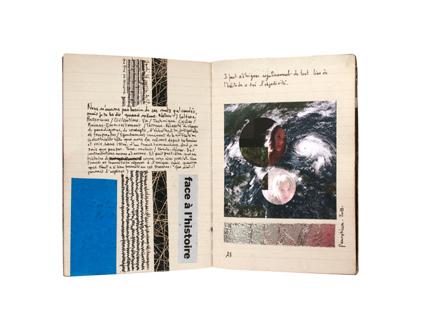

 Reeve Schumacher, Live from the Olympia (Red), detail, 2019. Photograph by Florent Demarchez. Courtesy of Lhoste.
Reeve Schumacher, Live from the Olympia (Red), detail, 2019. Photograph by Florent Demarchez. Courtesy of Lhoste.

Street photography—the art of capturing unexpected, unusual, and extraordinary instants in the public space—has been in Magnum’s DNA since its founding in 1947.
To understand the original link between Magnum and street photography, we must go back to Henri Cartier-Bresson. When the portable Leica came out, he realized that photographers could enter the human stream and take pictures the likes of which had never been seen before. When he was barely twenty, Cartier-Bresson traveled across Europe and Mexico with a new Leica and a 50 mm lens, taking snapshots that are now considered the foundation of street photography.
The show is based on the book Magnum et la street photography (Éditions Actes Sud), edited by Stephen McLaren, who talked with the agency’s photographers about the pictures, many of which have never been published before, and their experience as street photographers. This immersion into the archives sheds light on how the genre evolved, from Cartier-Bresson and his peers such as Sergio Larrain, to contemporary photographers, including Christopher Anderson, Raymond Depardon, Olivia Arthur, Susan Meiselas, Bruno Barbey, Inge Morath, and Gueorgui Pinkhassov. Magnum is above all a photojournalism collective, so it is hardly surprising that their best work is often used to illustrate news articles.
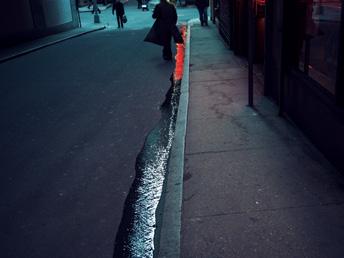

Born 1973 in Arles, France. Lives and works in Arles.
Photographer Cecil Ka received university training in the human sciences, focusing on the study of mental representations and images. After taking several courses, notably at the ENSP, she made identity one of her main subjects, viewing it through the lenses of childhood, celebration, and death. This led to several series and exhibitions, including Celebration Day and Fourth Dimension. Using simple, rigorous devices, Ka shows festive phenomena that allow her to produce depictions of contemporary Western society.
Twenty years ago, Cécile Ka, then a student at the University of Seville, worked on the similarities and differences between the Camargue Regional Nature Park and the Doñana National Park, located south of Seville. These are two protected natural areas where visual images have forged strong identities, of which the regional costume is an expression.
From 2017 to 2019, she photographed those whom contemporary Sevillian dress transforms into another version of themselves on festival days. In order to show the changes brought about by the embodiment of identity reflected in the costume, she also had the models pose naturally, simply dressed in a gray T-shirt. Cecil Ka arrives just before the festival, when the body is available and determined, its gaze meeting ours.
The images come in pairs, they speak in pairs, but the reality is triple. An interstitial image forms in the absence, in the mind of the observer. Photographer of the visible and invisible—of the in-between—Cecil Ka leaves the question of the moment aside in favor of building a relationship: between us, the viewers, and them, the images, moving the task of portraiture into the field of contemporary art. She creates a link between them and us, between the genre’s tradition and its posterity. The images are impossible yet present within us. Images have always been there, bodies, faces, and looks have turned ever around this.
Is it due to the uncertainy of our being in the world that photographers work to bring faces into the visibile?
Does Cecil Ka place women (and some men) before her in order to calm existential turmoil? Women bedecked in luminous simplicity or their most sumptuous, celebratory costumes. She builds a splendid, universal matriarchy between Brooklyn and the streets of Seville, Sundays in Arles and Mexican barrios; places where the mingling of death and festival is taken as a given.

Top Luisa, from the Flamenca series, 2019.
Bottom Juan-Francisco, from the Flamenca series, 2019.

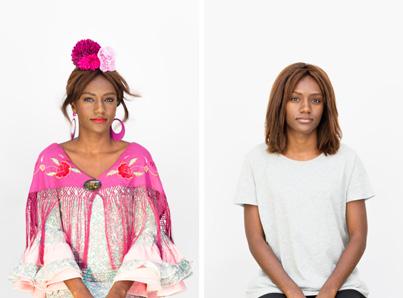

The series Purple America stems from a visual journey to the heart of America. Imagined as an anti-road trip across the United States, exclusively on Interstate routes, the artist uses a polymorphous approach where the aesthetics of documentary, conceptual photography, and the lighting of avant-garde cinema are at once beckoned and held back—as if a common system of references specific to American imagery lingered on the surface as a reminder from the artist for us to move beyond it.
Exhibition curator: Stéphane Ibars.
Jean Vilar died fifty years ago, leaving Avignon, his festival, his actors, and his public orphaned. But his adventure has been continued and reinvented. Agnès Varda, the friend from Sète, Maurice Costa, the faithful local witness, and many other photographers reveal what goes on backstage at night in Avignon: work, team spirit, fatigue, play, rest, family, and the far-seeing presence of Jean Vilar, who invented and headed this theater under the sun, a long way from Paris.
Exhibition curator: Jean-Pierre Moulères assisted by Adrian Blancard and Margot Laurens.
Internationally recognized Spanish photographer Isabel Muñoz stands out for her use of extra-large formats and platinum prints. The result of seven trips between 2017 and 2020, her mostly unpublished Japan series is a surprising gallery of characters, all of whom remain rooted in alternative Japanese culture, between respecting and surpassing tradition.
Exhibition curator: François Cheval
If you see Glasgow from the air, it looks like it’s been bombarded. What was once the second city of the British Empire, its major port for metalworks, shipbuilding, and railway engineering, now has the appearance of a former ruin that has been haphazardly rebuilt. I have photographed the city with a 5 × 4 camera, making sure that each place and each object I captured is a profoundly exemplary and vivid clue to the city’s spirit.
Ilaria Turba’s exhibition stems from three years’ work at the invitation of Le Zef-Scène Nationale de Marseille, where she connected desire with seeing and seeking new horizons. For the artist, this feeling speaks of a collective will to change in a time of global crisis, which depends on individuals and their ability to orient themselves differently in their everyday lives.
She Lit the Fire of the Past is a solo exhibition of work by Franco-Algerian artist and filmmaker Katia Kameli in the framework of African Women Focus Africa2020 Season. Kameli’s approach is based on research: history and culture fuel her visual and poetic imagination.
“Los Desnudos” is a group of 400 Mexican farmers that the government drove off their land. They had been seeking justice for years, but nobody paid any attention to them; it was as if they did not exist. So, they invented a new form of struggle to make their voices heard: protesting completely nude in the streets of Mexico twice a day until achieving victory.
In Conversations with Muybridge, Michel Glaize offers a modern interpretation of the series Animal Locomotion, produced by Eadweard Muybridge between 1872 and 1885, focusing on a personal experience of the model-creator-viewer triangle within this series of broken-down movement. The interactive, multidisciplinary installation invites the audience to participate in a tangible experience of complicity with the renowned British photographer, after a reminder of his singular place in the history of photography.
Kiswanson’s interdisciplinary work encompasses sculpture, writing, performance, sound, and video. A distinctive conceptual language emerges from his multifaceted practice, in which rootlessness, regeneration, and renewal are recurring themes. His show at Carré d’Art includes works about rootlessness, transformation, multiplication, disintegration, memory, and time—all key issues in the artist’s continuous exploration of the human condition
Exhibition curator: Jean-Marc Prévost.
In 2013, Jeff Weber and artist Snejanka Mihaylova undertook an initiation journey to study Coptic Christianity, specifically its Gnostic component. The idea of gnosis as a personal path to knowledge resonated with Weber’s photography project An Attempt at a Personal Epistemology, which he has been working on since 2009 in an attempt to define the paradoxical place where the artist operates at the crossroads between objective knowledge and private experience. A body of abstract photograms, Untitled (Neural Networks) is the outcome of speculation on neuronal activity and its transposition to a digital circuit.
Exhibition curator: Jean-Marc Prévost.
in the early 1930s, Polish-born sculptor and photographer Michel Sima came to Paris to attend classes at the Grande Chaumière. He befriended many Montparnasse artists, including Picasso. Sima was the privileged witness to his life in the South of France with Françoise Gilot and their children. These are some of the outstanding pictures that will complement the Françoise Gilot exhibition.
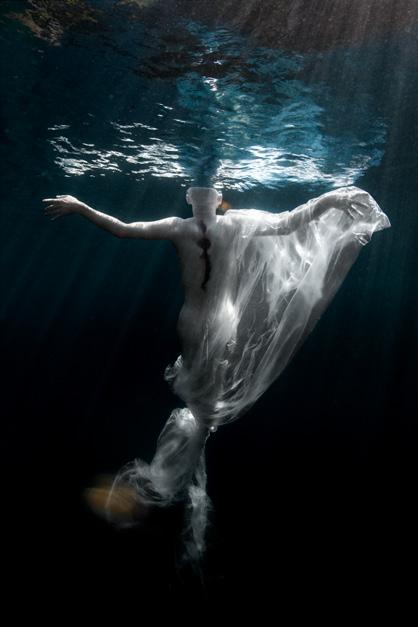


Top Mucem, Ilaria Turba, Jeunes de la Busserine Collective, 2019, Marseille, from the Yearning to See Far series.

Bottom FRAC Provence-Alpes-Côte d’Azur, Katia Kameli, The Turtle and the Two Ducks, 2016. Photograph by Aurélien Mole. Adagp, Paris, 2021.
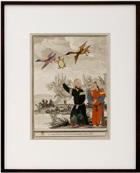
Top Association Jean Vilar, Maurice Costa, Jean-Pierre Darras and Philippe Noiret, day off at Tout-Vent, Sorgues, 1959.

Bottom Carré d’Art, Tarik Kiswanson, Passing, 2020. Photograph by Gunter Lepkowski. Courtesy of the artist and carlier | gebauer.

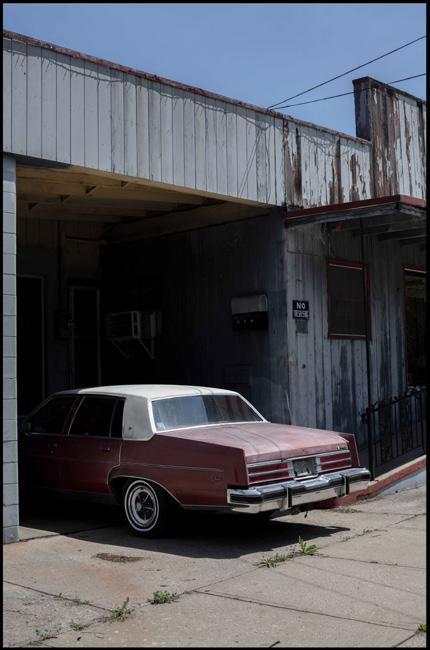
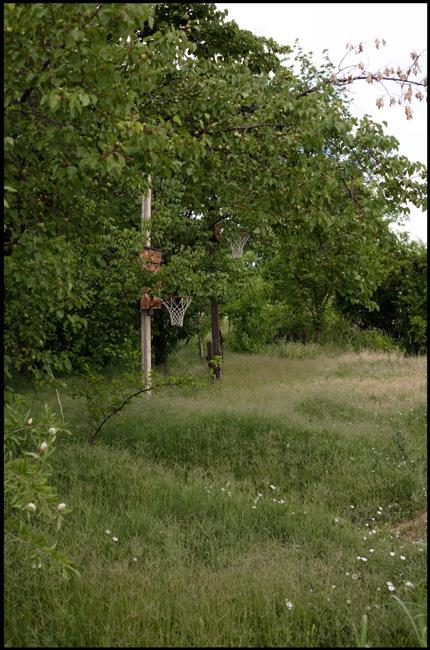
Previous pages



MÉJAN JEAN-PIERRE FORMICA
THE EMERGENCE OF THE VISIBLE
On both floors of the Chapelle du Méjan, Jean-Pierre Formica presents a world immersed in memory, made up of salt sculptures, ceramics, and paintings. The works include his latest Inside Outside large formats and in situ installations like contemporary archeology.
→ May — August 15
GRAZIANO ARICI NOW IS THE WINTER OF OUR DISCONTENT
Musée Réattu presents a selection of Graziano Arici’s personal works, chosen from among his most representative series—Carnival, Intérieurs, Angels, Als der Kind War, The Winter of Our Discontent, Lost Objects, The State of Things, Le Grand Tour, and The Heart of Darkness—produced between 1979 and 2020, in around four hundred images from an archive of the world, a “state of things.”
→ June — October 2021
In 1998, the Hôtel de Sully in Paris hosted the exhibition Dorothea Lange, curated by Sam Stourdzé. For the event, he produced thirty-six silver prints, using negatives held in the Oakland Museum of California. Especially close to Arles, he donated the prints to Musée Réattu. They cover the period 1933–1940, from Lange’s early street photography in San Francisco to collections from her assignments for the Resettlement Administration, starting in 1935.
→ June — October 2021
Top left
Dorothea Lange, Migrant Mother, Destitute pea pickers in California; A 32-year-old mother of seven children. February 1937 (modern print).
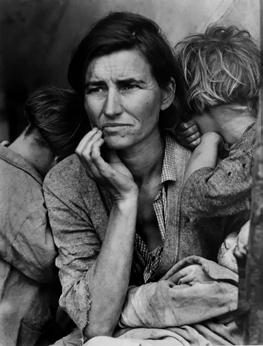
The
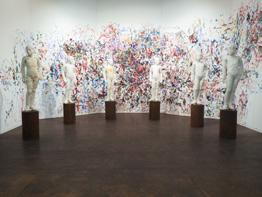
Top right

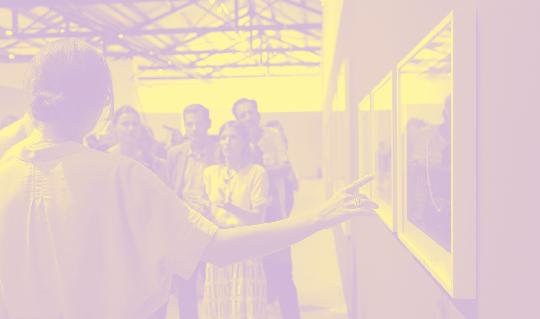
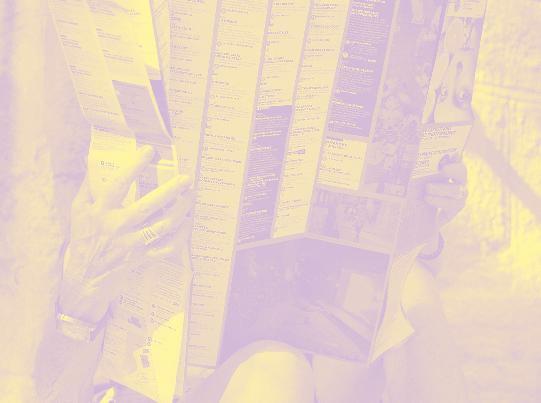
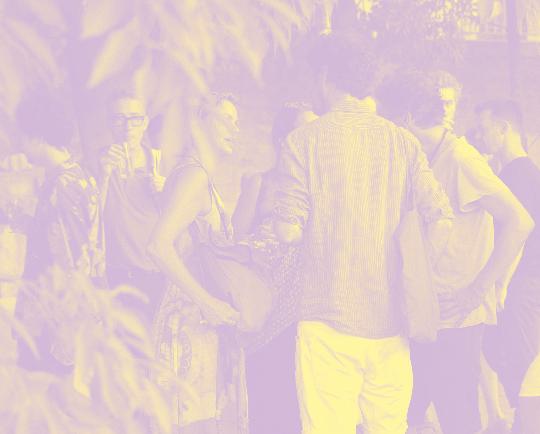
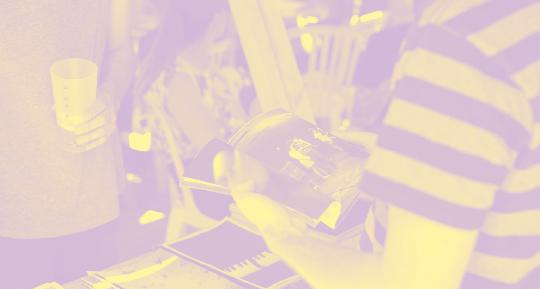
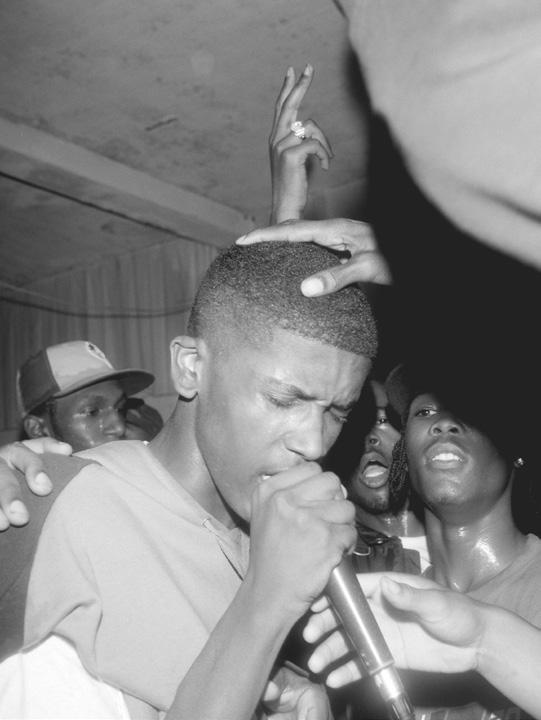
PHOTOGRAPHERS AND CURATORS MEET THE PUBLIC ACROSS THE CITY DAY AND NIGHT FOR EVENING PROJECTIONS AND DISCUSSIONS.
MONDAY JULY 5
BOOK AWARDS
PHOTO TEXT, HISTORICAL, AND AUTHOR’S BOOKS
The best photo books of the year
Main partner of the Book Awards: Fondation Jan Michalski pour l’Écriture et la Littérature. With support from the FNAC for the Author’s Book Award.
This year’s BMW artist-in-residence uses plants as photographic material and critiques the flow of images.
SABINE WEISS
A tribute to the Women In Motion 2020 prizewinner, who, at 96, still calls herself a photographer-artisan rather than an artist.
WOMEN IN MOTION AWARD FOR PHOTOGRAPHY 2021
LIZ JOHNSON ARTUR
Kering and the Rencontres d’Arles are giving Liz Johnson Artur the Women In Motion 2021 Award for photography. Her work involves a process of engagement and encounters.
Songwriter, composer and performer Bertrand Belin will offer a unique experience at the Théâtre Antique by taking a musical look at the festival’s program.
PRIX PICTET
Presentation of the artists shortlisted for the award’s ninth edition, whose theme is fire.
MADAME FIGARO ARLES 2021
This award is given to a woman photographer on the Rencontres d’Arles program.
A preview of Un monde à guérir (a world to cure), a show that will be held in Geneva in 2021 and Arles in 2022. An unprecedented immersion into the photo archives of the International Committee of the Red Cross-Red Crescent.
With support from the Swiss Confederation and the Canton and City of Geneva.
The Rencontres d’Arles has asked author Antwaun Sargent, curator of the exhibition
The New Black Vanguard, to orchestrate the first global Photo Slam. Following a call for participation to emerging photographers as open and inclusive as possible, those selected will have the opportunity to show their work on the stage of the ancient theater with the greatest freedom. With support from Konbini.
An award for the best dummy book. With support from the Luma Foundation.
The Rencontres d’Arles associates the Louis Roederer Discovery Award with galleries, art centers, associative spaces, independent venues, and institutions. This year’s 11 shortlisted projects question and rethink techniques and genres. They reflect a preoccupation with the body and its immersion in the world as much as with the materiality and history of photography.
With support from the Louis Roederer Foundation and Polka.

Live Magazine is a crazy idea—a unique, ephemeral show. That must be the key to its success. By inventing a living newspaper and putting photographers, journalists and artists on the stage of the ancient theater, Live Magazine restores all the power of true stories: their ability to captivate, transmit emotion, and engross an audience. In images, sounds or their own voices, they recount an unforgettable meeting, a consuming passion or an investigation conducted for the first time. The stories are 100% unpublished and 99% true.
Launched in 2006, Photo Folio Review offers portfolio readings during opening week. It is open by registration to professional photographers, students from photography schools, and advanced amateurs.
Photography experts from around the world do the review. Every year, they vote for their favorite portfolio and choose a winner whose work is shown the next edition.
Due to Covid restrictions, this year the portfolio readings will take place online.
The Women In Motion Award honors the career of an outstanding female photographer and will be awarded on July 5, during an evening event at the Théâtre Antique in Arles. The prize comprises an acquisition of €25,000 worth of her works for the collection of the Rencontres d’Arles. Launched in 2019, the first award went to Susan Meiselas, while the 2020 edition recognized the work of Sabine Weiss. Separately, Kering created the Women In Motion LAB, which in the first two years was devoted to highlighting the contribution made by women to the world history of photography.

Johnson Artur’s work is embedded in processes of engagements and encounters. Her pictures, her images, once taken are not done, but stay in constant movement. Creating surfaces and structures, trying to visualize a context and the possibility to also experience the pictures in a tactile way.
She is very interested in normality, which is why she goes to public places that are accessible to everyone. Normal for her means that whatever your background is, it doesn’t matter. The normality of making certain life choices is often reserved only for certain people. That’s why Johnson Artur believes that the notion of normality needs to be occupied, and its definition needs refreshing on all levels.
As she doesn’t work with a subject—she photographs human beings.
“Yes, most of the people in the archive are black but my archive is much bigger than that.” She likes to use her work to tell stories, whether it’s in a space or in a book. “For me, these stories are not connected to who I am. They’re just the things I see.”
Johnson Artur has shown part of her, which she refers to as her “archive,” internationally in the last few years. With solo exhibitions at the Brooklyn Museum in New York and the South London Gallery in London, both in 2019, and in various group show participations including at the Serpentine Galleries in London with Grace Wales Bonner’s A Time for New Dreams in 2019, the 10th Berlin Biennale in 2018, and the Photographers’ Gallery in 2016.
She received the Turner Bursary in 2020, was shortlisted for the Aimia AGO Photography Prize in 2017 became a Jane Lambard Fellow at the Vera List in 2018. Her work is held in public and private collections in the US and the UK, and her monograph with Bierke Verlag was listed by The New York Times in the section “Best Photo Books 2016.” A new solo exhibition will be held at FOAM in Amsterdam in fall 2021.
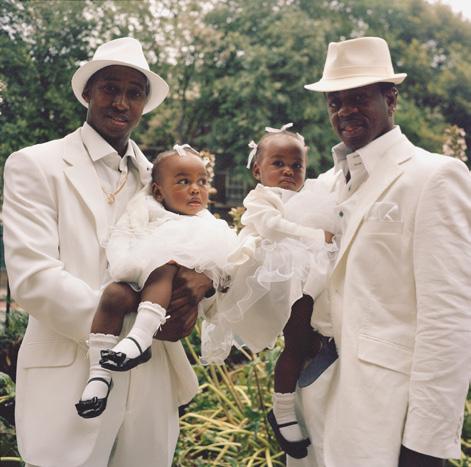 247
Liz Johnson Artur.
247
Liz Johnson Artur.
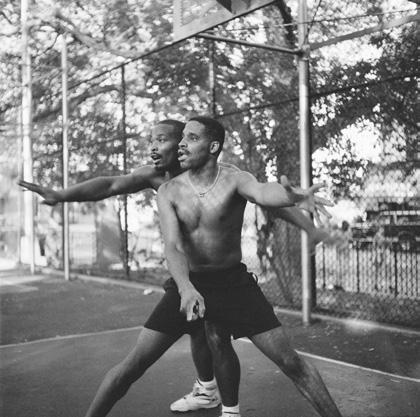
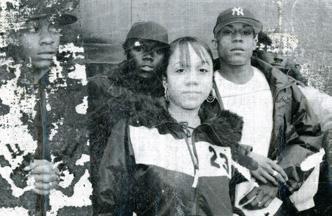
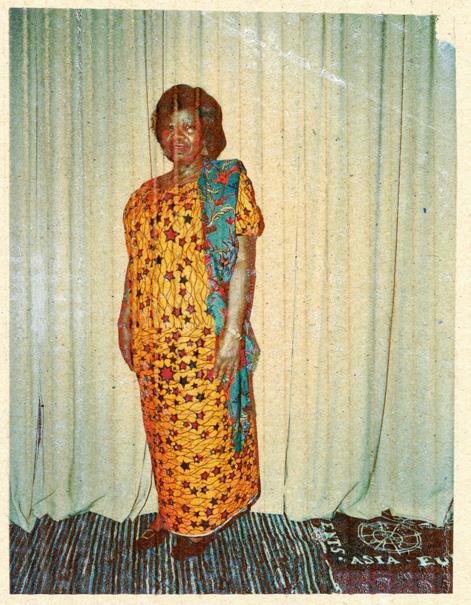
Klavdij Sluban, Vee Speers, Ludovic Carème, Jean-Christian Bourcart, Yann Rabanier, Antoine d’Agata, Jane Evelyn Atwood, Stéphanie Lacombe, Jean-Christophe Béchet, Bertrand Meunier, Paulo Nozolino, Charlotte Abramow, Éric Bouvet, Léa Crespi, Ambroise Tézenas, Corinne Mercadier, Julien Pébrel, Claudine Doury, Frédéric Stucin, Jérôme Bonnet, Laurence Leblanc, Denis Rouvre, Olivier Metzger, Denis Dailleux, Aurore Valade, Ljubisa Danilovic, Françoise Huguier.

























Interaction between great professionals and practitioners on every level has been a constant feature of the Rencontres d’Arles since its inception. The photography courses have reflected that desire for over 40 years, allowing amateurs and professionals to personally engage with each other every year, in an approach to creation hewing as closely as possible to the aesthetic, ethical, and technical issues of photography.
The Rencontres d’Arles is a lifelong learning centre. Depending on their experience, participants can receive funding from a collector organization and various programs (AFDAS, FAFCEA, training plan, etc.).
Information and estimate: stage@rencontres-arles.com
With technical support from Fujifilm.
The Rencontres d’Arles offers short weekend courses year-round. They focus on many themes including light, the city, portraits, and reportage.
These workshops are led by: Romain Boutillier, Nicolas Havette, Aurore Valade, Yann Linsart, Florent Demarchez, among others.
This exciting two-month experience will help participants develop their skills. It alternates online individual and group discussions with Bertrand Meunier, Jane Evelyn Atwood, Yann Rabanier, and others.
APRIL & MAY
A wide variety of themes is offered, from portraits to reportage, personal experience, narration, light and making a photography book. Arles is a work setting and an ideal playground for many photographers who take advantage of Camargue’s outstanding light and
landscapes to make personal series day after day by alternating between taking shots and analyzing images.
With:
Jane Evelyn Atwood, Paulo Nozolino, Claudine Doury, Vee Speers, Patrick le Bescont, Yann Rabanier, Klavdij Sluban, Laurence Leblanc, Jérôme Bonnet, Antoine d’Agata.
JULY—SEPTEMBER
This dense, summer-long program is taught by great photographers, including many who have exhibited at the Rencontres d’Arles. Peerless photographers and educators, several of them have taught at the Rencontres in past years and do us the honor of returning this summer.
They will be led by:
Corinne Mercadier, Julien Pébrel, Paolo Roversi, Françoise Huguier, Denis Rouvre, Jérôme Bonnet, Fannie Escoulen, Frédéric Stucin, Antoine d’Agata, Jane Evelyn Atwood, Klavdij Sluban, Léa Crespi, Éric Bouvet, Charlotte Abramow, Jean-Christian Bourcart, Patrick Le Bescont, Denis Dailleux, Bertrand Meunier, Jean-Christophe Béchet, Claudine Doury, Ludovic Carème, Stéphanie Lacombe, Yann Rabanier, Ambroise Tézenas, Christian Caujolle, Olivier Metzger, Fabienne Pavia, Mathieu Asselin, and, Ljubiša Danilović, and others.
The Rencontres d’Arles will feature a selection of participants’ work from the spring and summer courses online. The goal is to show new visions and share projects built with passion during an immersive photography course in Arles. The series can be found at workshopsgalerie.rencontres-arles.com

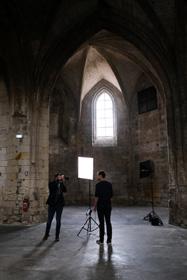
In the age of images, teaching children how to decipher and look at them critically is a matter of good citizenship. The public usefulness of image education no longer needs demonstrating. Democracy depends on it. Well aware of this, for many years the Rencontres d’Arles has run an energetic visual education policy backed by many private, institutional, and educational partners.
For over 16 years, the festival has been increasing its development of educational programs. It offers many courses and guided activities year‑round and designs mobile teaching tools to support this mission in France and overseas.
The Pause Photo Prose game and the Observe‑See visual education platform produce rising numbers of inquisitive minds with the keys they need to confidently understand images.
PARTNERS ON TEACHING ACTIVITIES:
French Ministry of Education, Aix-Marseille and Nice Board of Education, Provence-Alpes-Côte d’Azur Regional Directorate of Food, Agriculture and Forestry, Ministry of Culture, Provence-Alpes-Côte d’Azur Regional Directorate of Cultural Affairs, Sud Provence-Alpes-Côte d’Azur Region, Departmental Council of the Bouches-du-Rhône, City of Arles.
#REVOLUTION
SMARTPHONES, SOCIAL NETWORKS, AND REVOLUTION.
Representing major events in a time of 2.0.
Teaching workshops (in progress) with a group of students in their final year at the Mistral middle school in Arles, regarding the exhibition Thawra!
Révolution! Sudan: The History of an Uprising, led by Juliette Agnel as part of the Africa2020 Season.
In response to the current health situation, the Rencontres d’Arles is offering a modified version of its flagship educational event, A Year in Images, which traditionally involves hosting around 10,000 students in September to visit the exhibitions.
In 2021, the festival has decided to go out to educational establishments in Aix-Marseille and Nice in the fall to offer a program on image education during school hours, one that is related to the festival’s program, and to formal education in arts and culture. Its first year treats the exhibitions of Sabine Weiss (A Photographer’s Life) and Charlotte Perriand (How Do We Want to Live? Politics of Photomontage).
The digital platform Observe-See, developed by the Rencontres d’Arles, offers free educational tools and resources on photography. In particular, it offers schoolchildren and communities of educators 36 photographs selected from among different years of the festival, as well as information on the artists, avenues for reflection, and specific proposals for fun workshops based on this body of work. Participants can also offer feedback on the workshops they’ve taken part in.
Users go beyond and behind the images and examine the context of their production and distribution.
The platform also makes available to a general public content and resources to better understand the world of photography and its ecosystem.
Developed by the Rencontres d’Arles as an experiment, in consultation with professionals in photography and education, Pause Photo Prose is a game that analyzes photography, in its history, many meanings, and uses. The game, a true catalyst for curiosity, expression, attention, and collective reflection, appeals to a great diversity of faculties, such as speed, scrutiny, and team spirit.
6TH EDITION
SEPTEMBER 23—25
Each year the Rencontres d’Arles invites cultural, educational, and social stakeholders, and anyone with questions about image education, to meet for three days of conferences, round tables, art workshops, researching, and sharing experiences.
Every year, by request, the Rencontres d’Arles offers training in the use of the tools developed by the festival or under study.
These courses are open to the general public but mainly directed toward the educational community, public reading networks, and cultural and social organizations.
JIMEI x ARLES
INTERNATIONAL
PHOTO FESTIVAL
Xiamen, China
→ November 26, 2021 — January 5, 2022
SINCERELY QUEER
SÉBASTIEN LIFSHITZ COLLECTION
Ryerson Image Centre, Toronto, Canada.
→ January — December 2022
CHAPLIN AND “THE GREAT DICTATOR”: STORY OF A LITTLE FISH IN A SHARK-INFESTED OCEAN
Chaplin’s World, Corsier-sur-Vevey, Switzerland.
→ March 12 — August 29, 2021.
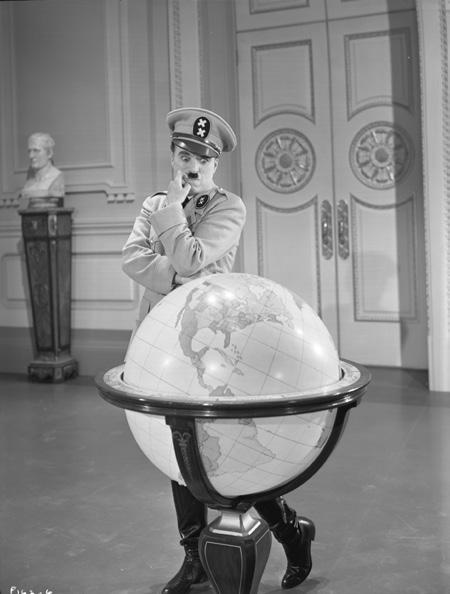
The Jimei × Arles International Photo Festival was co-founded by Sam Stourdzé (director of the Académie de France-Villa Médicis and former director of the Rencontres d’Arles) and Chinese photographer RongRong (co-founder of Three Shadows Photography Art Centre, China’s first center devoted to photography). Every year, Jimei × Arles brings several shows from the Rencontres d’Arles to China and produces more than 20 exhibitions for Chinese and Asian photographers. In 2020, Chinese photography critic and curator Gu Zheng was named the festival’s art director. Since its establishment in 2015, the festival has become a destination for photography enthusiasts in China and across Asia, attracting more than 350,000 visitors over the past six years.
For centuries, Xiamen has been one of China’s largest ports. Across a strait from Taiwan and known for Gulangyu Island and architecture dating back to colonial times, Xiamen is a vibrant and modern city, home to China’s independent fashion scene. The two main festival sites (including Three Shadows Photography Art Centre Xiamen, open year-round) are located in Jimei, Xiamen’s new business district.
Jimei × Arles brings international photographers, such as Raymond Cauchetier, Tom Wood, René Burri,
Joel Meyerowitz, Matthieu Gafsou, and Mathieu Pernot, to China through its partnership with the Rencontres d’Arles, but it is also a platform for young Chinese photographers. Every year, ten talented photographers are nominated for the Discovery Award. At stake is a prize and an exhibition at the subsequent summer’s the Rencontres d’Arles.
In 2017, the festival inaugurated China’s first award dedicated to female photographers. The first winner was Guo Yingguang for her series on arranged marriages, The Bliss of Conformity. Pixy Liao was the 2018 winner, representing her perspective on male-female relationship dynamics by posing with her partner for the series Experimental Relationship. Luo Yang won in 2019, with the series Youth, which documents contemporary Chinese youth culture. Xu Xiaoxiao received the award in 2020 for her work Watering My Horse by a Spring at the Foot of the Long Wall, which explores the relationship between the Great Wall and contemporary China.
Every year, the Jimei × Arles International Photo Festival features an Asian country’s photography scene. After India (2019), South Korea (2018), and Indonesia (2017), Jimei × Arles focused on Japan in 2020.
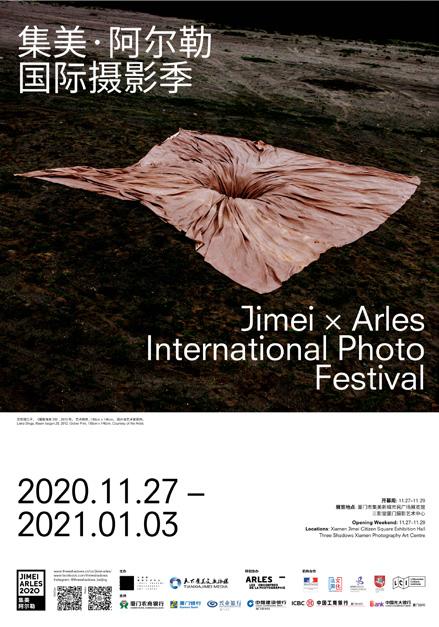
In a quest to strengthen regional cooperation on the foundation of the strong Indo-French bilateral relations through cultural exchange, Serendipity Arts Foundation and the Rencontres d’Arles announced the biggest photography, video and new media grant, supported by the Institut français in India.
Serendipity Arles Grant (SAG) 2020 declares Purushothaman Sathish Kumar, from Kanchipuram, India, as the winner of SAG 2020, South Asia’s largest grant for lens-based practitioners. Sathish will receive a grant of 12 lakh rupees (approximately 15,000 euros) to develop the project and show the final presentation at Rencontres d’Arles, France, in 2022. The jury initially had shortlisted 10 practitioners from hundreds of applications, across Afghanistan, Bangladesh, Bhutan, India, Myanmar, Nepal, Pakistan, and Sri Lanka.
The largest of its kind, the Serendipity Arles Grant was established 2020 with the aim of empowering artists from the region, as well as extending a spirit of regional cooperation and representation by promoting cultural practices in South Asia. The jury for SAG 2020 comprised esteemed artists, curators, and cultural specialists: Christoph Wiesner (Director, Rencontres d’Arles); Dayanita Singh (photographer and bookmaker); Devika Singh (Curator, International Art at Tate Modern); Ravi Agarwal (artist and Founder-Director, Toxics Link); Smriti Rajgarhia (Director, Serendipity Arts Foundation), and Tanzim Wahab (Chief Curator, Bengal Foundation)



Maja Hoffman established the Luma Foundation in Switzerland in 2004. Luma focuses on the interplay of arts, culture, human rights, environment, education and research, striving to create a space where different disciplines can meet, interact, and influence one another. This vision manifests in the experimental campus Luma Arles: a cultural center that provides artists opportunities to experiment, produce and present new work in close collaboration with other artists, curators, scientists, innovators and audiences
Since 2010, Luma has commissioned and presented the work of over 100 artists, thinkers and innovators at venues across Arles. Since 2013, it has overseen the transformation of the Parc des Ateliers, a 7-hectares former industrial site, located by the celebrated UNESCO World Heritage sites of Arles.
Deeply-rooted in the region, Luma’s initiative generates and provides for a thriving dynamic, and has earned solid recognition over the years for its various projects and programs in the arts. The Parc des Ateliers includes six historic industrial buildings, five of which have been renovated by New York-based German architect Annabelle Selldorf. The site’s iconic Luma Tower, designed by architect Frank Gehry, is the finishing touch on the varied spaces, whose modularity allows for the production and reception of interdisciplinary programs. The surrounding gardens and public park, designed by Belgian landscape architect Bas Smets, are being refitted, allowing the Parc des Ateliers to open to the public this summer, 2021.
BMW Group has been a proud patron of the Rencontres d’Arles since 2010. This year, BMW Group is celebrating a double anniversary: 50 years of cultural engagement globally, and 10 years of the BMW Residency in France. BMW Group France supports photography throughout an artist residency by providing a place for free expression and encourages the emergence of talents. Agility, creativity and innovation are as essential to photography as they are to creating sustainable, responsible mobility.
Initiated in 2011, the BMW Residency provides, each year, exclusive support to an emerging photographer, selected by a jury of leading figures, to produce an experimental work. In addition to an 8,000-euro grant, the winner’s work is exhibited at the Rencontres d’Arles, as well as Paris Photo, and is published in a book for the BMW Art & Culture collection.
For the 2021 edition of the Rencontres d’Arles, the award winner Almudena Romero presents The Pigment Change at the Cloître Saint-Trophime.
“As partners of art-in-the-making, each year we give carte blanche to an artist with an ambitious project that’s carried out over the course of their residency and exhibited
at Arles. Almudena Romero has an original experimental and scientific approach, with a reflection committed on the relationship between ecology and production. Her work totally echoes the BMW Group’s vision of innovation at the service of the planet and of production that must always be more sustainable and respectful of the environment.” states Vincent Salimon, CEO at BMW Group France.
The BMW Residency is held in partnership with GOBELINS, School of Visual Arts, which welcomes the winner over a three-month period, offering them technical, academic and material support. BMW Group France participates in the equal opportunities program initiated by GOBELINS, offering a scholarship to two students per year to finance their education. Thus, transmission of knowledge and lasting commitment are the watchwords of BMW Group France’s partnership with the Rencontres d’Arles.
Press contact for BMW France: Maryse Bataillard + 33 (0)1 30 03 19 41 maryse.bataillard@bmw.fr bmw.fr/artetculture
A global luxury group, Kering manages the development of a series of renowned Houses in fashion, leather goods, jewelry and watches: Gucci, Saint Laurent, Bottega Veneta, Balenciaga, Alexander McQueen, Brioni, Boucheron, Pomellato, Dodo, Qeelin, Ulysse Nardin, Girard-Perregaux, as well as Kering Eyewear. By placing creativity at the heart of its strategy, Kering enables its Houses to set new limits in terms of their creative expression while crafting tomorrow’s luxury in a sustainable and responsible way. We capture these beliefs in our signature: “Empowering Imagination”.
Kering has been committed to gender equality since its creation. Its initiatives include Women
In Motion, a program launched in 2015 by Kering, a partner of the Festival de Cannes. Women
In Motion focuses on women’s recognition and their inestimable contribution to the film industry, seeking to emphasize and offer concrete support for women in cinema. The program has since been expanded to the domain of arts and culture, where gender inequality is all too present, despite its being one of the most powerful vehicles of change. In photography, for example, the program has supported the Prix de la Photo Madame Figaro Arles since 2016, and Jimei x Arles in China.
In 2019, Kering partnered with the Rencontres d’Arles to launch the program Women In Motion in Arles. The partnership aims to contribute to the acknowledgment of women photographers and of gender equality in this field. While continuing to assist talented young women through the Prix de la Photo Madame Figaro Arles, Kering has created the Women In Motion LAB at the Rencontres d’Arles. In its early years, the program was dedicated to large-scale research into women’s contribution to the world history of photography. Kering also launched the annual Women In Motion Award for photography, which celebrates the career of a leading woman photographer.
Women In Motion is a key platform for changing mentalities, recognizing noteworthy figures, and reflecting on the place of women and the attention paid to them in arts and culture, keeping in mind that the question of inequality affects all artistic fields.
Press contacts: Emilie Gargatte + 33 (0)1 45 64 61 20 emilie.gargatte@kering.com
Eva Dalla Venezia + 33 (0)1 45 64 65 06 eva.dallavenezia@kering.com kering.com
In 2004, Vera Michalski-Hoffmann set up the Fondation Jan Michalski pour l’Écriture et la Littérature in memory of her husband as a way of continuing their shared commitment to writers.
Designed as a small community in the heart of an inspirational natural setting, the foundation develops diverse activities, aiming to foster creative writing and encourage reading. The library—multicultural, multilingual, and open to all—has near 70,000 works of modern and contemporary literature. The auditorium also hosts diverse cultural events: literary discussions, crime novel workshops, readings, projections, plays, concerts, performances… In addition, every year the foundation stages temporary exhibitions showing writing, literature, and books from different perspectives: the world of writers, the history of movements and genres, and the works of artists that bring together image and word are made available.
The writers-in-residence program conceived to offer a conducive environment for creativity, has welcomed novice and established writers of all backgrounds who are beginning, continuing, or completing a project. Furthermore, the Jan Michalski Prize for Literature, awarded annually, strengthens the foundation’s actions by honoring an outstanding work of world literature. The foundation also provides grants for numerous literature-related projects.
The Fondation Jan Michalski offers a unique cultural space, open to the world, where writers, artists, and members of the public mix.
Fondation Jan Michalski pour l’Écriture et la Littérature En Bois Désert 10 CH-1147 Montricher fondation-janmichalski.comFor the last 4 years, Lët’z Arles has been taking a bit of Luxembourgish creativity to the Rencontres d´Arles. A non-profit organisation supporting and promoting photography and artists connected with Luxembourg, Lët’z Arles offers artists a comprehensive creation and distribution package every year, with a grant enabling the staging of an exhibition within the Rencontres’ associated programme, the support of a curator for more than a year, the publication of a book and a tour of their exhibition in Luxembourg. A major player in the promotion of Luxembourgish photography abroad, Lët’z Arles also works to promote the work of photographers from Luxembourg within their own country.
For the 2021 edition, artists Daniel Reuter and Lisa Kohl were selected by an international jury for their projects designed for the Chapelle de la Charité. The jury was comprised of: Paul di Felice, Marta Gili, Danielle Igniti, Steph Meyers, Sam Stourdzé, Michèle Walerich and Christoph Wiesner, chaired by Florence Reckinger-Taddeï
Lët’z Arles is supported by the Luxembourgish Ministry of Culture; the Centre national de l’audiovisuel (CNA); the stART-up fund by Œuvre Nationale de Secours Grande-Duchesse Charlotte; the initiative LuXembourg – Let’s make it happen; and the City of Luxembourg.
The association is placed under the High Patronage of HRH the Hereditary Grand-Duchess.
More information at: www.letzarles.lu
Facebook: @Letzarles Instagram : @letzarles
The Louis Roederer Foundation was created ten years ago with the purpose of perpetuating Louis Roederer’s sponsorship activity which followed on from its discovery of the photography collection of the Bibliothèque Nationale de France in 2003. Since being awarded the title of “Major Patron of Culture and Arts”, the Foundation has continued to demonstrate its commitment to art through its support for the Grand Palais as well as its latest partnership with the Villa Medicis.
But, in all the creative and artistic endeavours that it sponsors in these iconic places of culture and intelligence, whether through the Bibliothèque Nationale de France Photographic Research Grant, the Louis Roederer Foundation Rising Star Award at La Semaine de la Critique in Cannes, the Louis Roederer Foundation Revelation Prize at the Deauville American Film Festival, and the Discovery Award at the Rencontres d’Arles, the Louis Roederer Foundation plays its favorite role in supporting and nurturing the great artists of tomorrow.
“There’s a reason that the strong affinity between the Louis Roederer Foundation and the art of photography should culminate in Arles, where photography expresses in full liberty, in so many charming recesses, the auspicious ascendance of a magnificent art. This year, in the lovely setting of the Theatre Antique in Arles, we will be present to give the Louis Roederer Discovery Award to an artist and thus celebrate the friendship that has guided the Foundation’s choices since its creation.”, says Michel Janneau, General Secretary of the Louis Roederer Foundation.
Media Contact:
L’art en plus +33 (0)1 45 53 62 74 Amandine Legrand a.legrand@lartenplus.com
Since 2015, Switzerland has been a partner of the Rencontres d’Arles. Why? Don’t our artists and institutes have enough talent on their own? Should nationality play a role in the annual photography festival’s program? Should Swiss Photography be preserved like a protected species?
After this partnership, Swiss photographers, curators, publishers, schools and institutes will still be present in Arles, as they were before. The diversity and qualities they showcase will find their place once again. While there may not be one type of Swiss photography, there are undoubtedly common points to be found, going beyond Swiss rigor, singularity, the desire to go beyond first impressions and a need for dialogue…
This need for dialogue happens between an exhibition and its viewers of course, but also between the photographer and his/her subjects. As host to many international organizations, from the UN to the Red Cross, NGOs, and think tanks of all kinds, Switzerland, and Geneva especially, is a place where exchanges between all is unavoidable and encouraged.
Since 2015, Switzerland, along with the City and Canton of Geneva, have been partners of the Rencontres d’Arles. Why? Because dialogue is essential and takes time, the time for Rencontres.
In their role as unique and influential trend spotters with an eye on the changing faces of the world’s cities, the Louis Vuitton City Guides have been exploring the most stylish cities for the past twenty years. The guide put 30 cities under the microscope, offering unique insights into fashion, design, contemporary art, food and culture. In Paris, New York, London and Tokyo, a team of authors and guest contributors from a wide range of fields take readers on a highly personal tour, selecting the finest hotels and restaurants, the most fashionable venues and the historical sites that no visitor should miss.
To celebrate the 2021 Rencontres d’Arles photography festival, the Louis Vuitton City Guide is alighting in Arles with a special edition that pays tribute to the Camargue city and its world‐famous festival. Featuring original photography, the guide will be on sale in bookstores, with a digital version available free from the App Store during the festival.
Éditions Louis Vuitton is a pioneering publisher with a catalogue of some 100 titles. The different series center on travel, art and fashion, including city guides, books of drawings, photography books, art books and literary works. Travel is also about the art of fine living, and Éditions
Louis Vuitton is setting up a pop‐up bookstore at wine bar and delicatessen Le Buste et l’Oreille in Arles throughout the festival. The venue will host a series of events, including signing sessions with authors, artists, and photographers.
Contact Éditions
Louis VuittonJulien Guerrier +33 (0)1 55 80 38 75 julien.guerrier@louisvuitton.com
Dupon, member of RC Group is the Parisian photographic laboratory, historical reference of the profession. It has developed a complicity and a strong commitment with photographers and major players in photography.
For 30 years, RC Group has been concentrating the skills of more than 400 employees in the image professions, at the service of the biggest luxury and fashion brands. The group designs the communication and promotion tools for the brands at the points of sale, both physical and digital. Its know-how is concentrated around: POS, print, window displays, digital, and promotional objects. Twenty companies in France, Europe and Asia make up the group.
Dupon-RC Group, in the logic of its commitment, decided in 2020 to become a full partner of the Rencontres d’Arles. Despite the turbulence, it maintains its support and confirms it for the future.
Dupon and its teams, backed by their expertise, will support the teams of the Rencontres to contribute to the success of the 2021 edition.
In particular, Dupon is supporting a flagship exhibition for this year’s edition: The New Black Vanguard, a celebration of Black creativity between art and fashion, a group exhibition curated by Antwaun Sargent.
Cécile Dourmap, General Manager of Dupon, is supported by the teams of Dupon and RC Group with Didier Quilain, photographic project consultant.
Faithful to the Rencontres d’Arles, SNCF Gares & Connexions is supporting the festival for the 12th consecutive year with four exhibitions in resonance with its program, on show at stations: Paris Gare de Lyon, Marseille Saint Charles, Arles and Avignon TGV.
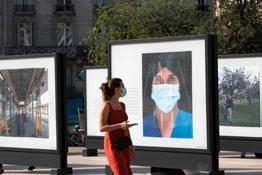
In 2020, SNCF Gares & Connexions was strongly committed to making the festival happen despite its cancelation. Thus, the project Hexagone, by photographers Eric Bouvet & Yan Morvan, which was initially scheduled for presentation at the Abbaye de Montmajour, was shown exclusively at the Avignon TGV and Paris Gare de Lyon stations. Thousands of guests and travelers were able to experience these striking photographs for a portrait of France today.
From design and operations to marketing, SNCF Gares & Connexions is the train station specialist. Its strategic vision is to make stations desirable in order to make trains desirable. With 3,000 stations in France and 4,700 staff members, SNCF Gares & Connexions is committed to modernizing, improving the use of its stations, and providing new services to its ten million daily travelers and visitors.
Since its creation, SNCF Gares & Connexions has chosen to put the cultural life of regions and cities at the center of stations: art is essential to life, personal enrichment and living together. In close association with institutions and local cultural life, train stations become transports to new territories, with each station reimagining the ideas of exchange, travel and movement.
A main partner of major institutions and events in photography, such as Jeu de Paume, LE BAL, Circulation(s), ImageSingulières and La Gacilly, SNCF Gares & Connexions is also dedicated to contemporary art and music. Today, over a hundred stations across the country inspire the day-to-day lives of travelers and residents year-round.
Press contact: Gaëlle Le Ficher +33 (0)6 17 50 92 53 gaelle.le-ficher@sncf.fr garesetconnexions.sncf/fr #artengare

As an unfailing partner of the Rencontres de la Photographie d’Arles, ARTE pays tribute this year to Gisèle Freund and Hervé Guibert, two legends who have each left their mark on their time.
The documentary Gisèle Freund, An Intimate Portrait of a Visionary Photographer depicts the Franco-German photographer, sociologist and writer. Gisèle Freund fled Nazi Germany in 1933 and settled in Paris where she became a pioneer in color photography and an unrivaled portraitist of international writers and artists. A rare woman who joined Magnum Photos in it’s founding, she was both a major player and a thinker in photography. In celebration of her professional and personal archives, the camera of the woman who was her friend explores her unpublished photographs, contact prints, reports and writings.
Hervé Guibert, La Mort Propagande tells Guibert with the images of Hervé Guibert. The film is an intimate portrait whose writing is based exclusively on the writer-photographer’s often unpublished photographs and contact prints, on super-8 films of childhood and the 14 hours of rushes of La Pudeur ou l’Impudeur, a transgressive testament film about his AIDS and the decay of his body. The film is a “Guibertian” hymn to love, body, sex and desire.
 Directed by Teri Wehn Damisch, Production ARTE France, Complices Films, 52mn, 2021.
Directed by David Teboul, Production ARTE France, What’s Up Films, 64mn, 2021.
Directed by Teri Wehn Damisch, Production ARTE France, Complices Films, 52mn, 2021.
Directed by David Teboul, Production ARTE France, What’s Up Films, 64mn, 2021.
As France’s leading radio station with around 7 million listeners per day, the largest morning-program audience, and millions of monthly podcasts, France Inter fully embraces its role as a public, generalist radio station, uniting an ever-growing public in a world of accelerating individualism and social fragmentation.
More than a radio station, today France Inter is a hyper-radio at the center of a vigorous, multidimensional ecosystem.
By going out to greet the most important events in arts and culture, France Inter supports culture year-round. So naturally, this year, the station is once again backing the great festival of photography that is the Rencontres d’Arles.
France Inter, festival radio, at 91.3 in Arles
Press contact: Marion Glémet +33 (0)6 23 18 31 74 marion.glemet@radiofrance.com
Konbini is a phenomenon that reaches an audience of over 27 million people a month in France! Created in 2008 by Lucie Beudet and David Creuzot, it proved successful among the youth, then grew to become the point of reference on pop culture, national and international news, music, cinema, art, food and sports.
Present on every platform, from TikTok to Instagram, Snapchat, Youtube, Pinterest, and of course, Facebook, Konbini is for all ages. It’s for a youth involved in its future, committed to the planet, enthusiastic, and curious about the world. From Emmanuel Macron, to Kendall Jenner, Catherine Deneuve, Adèle, Selena Gomez and Amélie Nothomb, all the figures making headlines chose Konbini to express themselves.
With a novel approach to journalism and formats allowing creativity to serve content, today the growing number of young users who share and comment on video and other media cite Konbini as “the base”.
Media partnerships contact: Simon Delpirou + 33 (0)6 61 81 59 83 simon.delpirou@konbini.com
France’s first 24-hour news channel, LCI has always followed major cultural events in France, foremost among which is the Rencontres d’Arles. This year, the TF1 Group’s news network is keener than ever to support the indispensable event for photography-lovers and professionals in France and around the world.
Founded in 1994, LCI’s editorial policy makes respectful, rigorous debate top priority. With major figures like Pascale de la Tour du Pin, Elizabeth Martichoux, David Pujadas, Pascal Perri, Arlette Chabot and other established columnists, LCI puts key current events in politics, economics, society and culture into perspective through the many shades of opinion of its guests.
Today, LCI is a thriving brand, recognized on all media platforms, and its digital declination, lci.fr, is among the top new sites in France.
Media partnerships contact:
Anne Baurez
+33 (0)1 41 41 45 62 abaurez@tf1.fr
Le Point boasts over two million weekly readers as well as a web readership of eleven million. Proud of backing the Rencontres d’Arles since 2007, it offers visitors to this magnificent event the “Rencontres guide”, specially written by its journalists.
Since 2016, Le Point ’s editorial team and the various desks have led the spirited, open to-the-public Rencontres/Le Point, offering a journalistic, cultural, societal and geopolitical perspective every day on work by the photographers exhibiting at Arles.
Le Point, which always backs, and sometimes anticipates, innovations, is also delighted to join forces with Les Ailleurs festival devoted to virtual reality, even sitting on its prestigious jury.
For the 52th Rencontres d’Arles, Le Point will publish special issues all summer. They are available with the weekly and on all its digital platforms.
Public relations contact:
Lola Wangler +33 (0)6 72 11 44 08 lwangler@lepoint.fr
Created in 1953 by artists, the ADAGP represents nearly 200,000 artists from all over the world in all disciplines of visual arts: painting, sculpture, photography, architecture, design, comics, manga, illustration, street art, digital creation, video art.
With a global network of nearly 50 sister societies, the ADAGP manages all the property rights held by artists (resale right, reproduction right, right of public communication, collective rights) for all modes of use: books, media, advertising, merchandizing, exhibitions, auction and gallery sales, television, video on demand, websites, etc.
Through its cultural action program, the ADAGP supports the creative scene by initiating and/or supporting projects that highlight visual arts, promoting them nationally and internationally. The ADAGP has set up several grants to support artists in key moments of their professional career:
— Each year, the ADAGP Revelations support the emergence of talents in fine arts, digital/video art, urban art, comics, design, artist’s books, children’s books, photography. The laureates receive a grant and benefit from a video portrait available on Arte’s website.
— The ten annual Monographie Collection grants help fund the first monographic book of mid-career ADAGP members.
— To help increase the visibility of French artists abroad, the two annual Connexion grants financially support French venues to carry out an international co-production project or the resumption abroad of exhibitions of artists from the French scene.
— Ekphrasis grants meet an artist’s need for a reference text to accompany a portfolio, application, exhibition or publication. In association with AICA France and the Quotidien de l’Art, these annual grants allow 10 ADAGP artists to have a critical text published in the Quotidien de l’Art. Working alongside the Rencontres d’Arles for more than 10 years, the ADAGP is present during the professional week to meet the photographers and answer their questions. Free legal consultations within the Photo Folio Review, an information stand located cour Fanton, or even a group picture of the photographers and guest curators: the ADAGP is at the heart of photographic creation to defend the rights of photographers! Become a member of ADAGP and collect your royalties.
Contact: ADAGP 11, rue Duguay-Trouin, 75006 Paris + 33 (0)1 43 59 09 79 adagp@adagp.fr adagp.fr
Created in 1999, the Société des Auteurs des arts visuels et de l’Image Fixe - Saif is the youngest of authors’ societies in France. Established by artists who wish to collectively defend their rights, Saif is visual artists’ rights management organization whose mission is to defend, collect and distribute the rights of visual arts authors. It now has 8,000 authors in all the visual arts such as architects, designers, photographers, cartoonists, illustrators, graphic designers, painters, sculptors… including 5,500 photographers.
Saif members benefit from collective rights. Legislation has set up the collective management of certain rights because of the impossibility for an author alone to control the many uses that are made of his work. There are currently four collective rights:
— Private audiovisual and digital copies right: created in 1985, this remuneration covers copying of a work intended for private use.
— Reprography rights: payment collected for photocopies of works published in print media or books.
— Cable broadcasting rights: payment collected for broadcasting television programs on cable networks.
— Public lending rights: payment forbooks lent by libraries.
These uses generate additional revenues that are paid to artists’ by a collective management organisation: Saif!
Saif can also manage artists’ individual rights, such as reproduction and public presentation rights. It can negotiate general agreements with broadcasters (television, internet, etc.) on artists’ behalf and has been approved by the Ministry of Culture to manage resale rights (payment on the public resale of original prints or works by auction houses and galleries).
Saif also plays an important role in the artistic and cultural vitality in France through its cultural actions. 25% of the total amount of remuneration for private copiyng rights goes towards funding cultural events in the public interest, for this raison Saif is proud to support Les Rencontres Arles for 13 years.
Since its creation, Saif has worked to defend and protect authors’ intellectual property rights and kept up an ongoing dialogue with broadcasters as well as national and international institutions (the Ministry of Culture, CSPLA, European Union, etc.) to make authors’ voices heard.
Contact: SAIF 82, rue de la Victoire, 75009 Paris + 33 (0)1 44 61 07 82 communication@saif.fr saif.fr
After its creation in 1977, Tectona rapidly established itself as the leading maker of outdoor furniture in France. The brand’s guiding principles were laid down from the outset: a quest for obviousness and simplicity of forms; rigorous selection of materials; proficiency in traditional techniques and modern technology.
Tectona was a trailblazer in opening its doors to designers in the 1990s. Inspiration by British chic of the early days gave way to new creations in sync with changing outdoor lifestyles. Since then, the repertoire of forms has been enriched by attending to qualities such as lightness, ease of use and optimization of spaces; at all times, the overarching criterion has been durability.
The iconic “contemporary classic” style of Tectona furniture has revitalized the art of outdoor living. Discreet and sober, it blends gracefully into natural spaces such as parks and gardens; elegant, it brings a human dimension to inorganic urban landscapes; welcoming, it lends itself to hours of idleness, at the seaside or poolside; generous, it reaffirms the joys of outdoor living, season after season.
Open your senses to the spellbinding light of Provence: Tectona furniture, provided to the Rencontres d’Arles, invites visitors to slow down, relax, and absorb the marvelous encounters of this festival.
+33 (0)1 47 03 05 05 tectona.fr
Since 1934, Malongo has sold individuals and businesses fine coffee grown by small producers using traditional farming methods (hand-picked, high-altitude Arabica) in the world’s best producing areas.
From plantation to cup, Malongo lavishes care on its coffee, performs regular quality inspections and does slow, traditional roasting “in 20 minutes”. Respecting the earth and the men who cultivate it is a fundamental value for the brand. That is why Malongo innovates for sustainable development, organic agriculture and fair trade, an area where it is France’s leader.
The brand is also committed to passing on noble knowledge about coffee through its training centers and corporate foundation.
Chammas & Marcheteau, an independent multi-practice business law firm, is a conviction and sustainable supporter of photography and, more generally, artistic creation. The firm counts enthusiastic photographers among its attorneys and has decided to support the Rencontres d’Arles by providing pro bono legal support services and making available to the organization the know-how of its lawyers.
Created more than 15 years ago in Paris, Chammas & Marcheteau is a renowned law firm that counts some forty lawyers today.
The firm offers a wide range of expertise, including corporate (mergers and acquisitions, private equity, fund structuring, corporate law), tax law, labor law, insolvency law, new technology, personal data and intellectual property law, and related dispute resolution.
The firm advises a wide range of clients (entrepreneurs, investment funds, institutions and major groups) on domestic and international matters, relying on the international experience of its partners and a solid network of correspondent firms abroad.
Partner in charge of partnership: Jean-François Rage + 33 (0)1 53 42 42 50 jfrage@lcdm.law lcdm.law
Since its founding, the firm Rivedroit Avocats has taken an active role in supporting arts and culture in all its forms. It has been providing professional legal advice to the festival since 2015.
The firm’s art law team has gained recognition over the years for its practice of intellectual property law, especially in the field of author’s rights and neighboring rights.
“We’re proud and honored to have been supporting the festival now since 2015. The Rencontres d’Arles is among today’s key cultural players in France and abroad,” says Nicolas Maubert, founding partner of the firm.
In 2009, lawyers from several major firms founded Rivedroit Avocats, a flexible and dynamic organization with a reputation for distinction and commitment to clients.
Accustomed to multicultural work environments, the firm’s lawyers develop close ties with their clients in France and abroad, helping them with all legal aspects of their projects. Clients include French and international corporations as well as SMEs.
The multidisciplinary firm is principally active in the following areas: mergers/acquisitions, corporate law, foreign investment law, intellectual property law – art law, real estate law, labor law and complex commercial disputes.
Partner in charge of the sponsorship: Nicolas Maubert + 33 (0)1 40 54 30 40 nicolas.maubert@rivedroit.com rivedroit.com
By joining forces with the Africa2020 Season —dates for which have unfortunately been postponed—the Rencontres de la Photographie d’Arles accepted to take on the Season’s main goal: inviting people in France to look at and understand the world from an African perspective.
The four projects presented, from current events and memory to commitment and testimony, demonstrate the diversity of approaches and aesthetics among African photographers. Through compelling artistic proposals, in 2021, the Rencontres d’Arles gives visibility to one of the world’s main centers of contemporary creation, the African continent, notably showcasing Sudan’s photography scene, seldom seen in France. Each of these photographers’ projects, chosen by curators from Africa and its recent diaspora, focuses on one of Africa2020 Season’s themes: “Augmented Orality”, “Economy and Fabulation”, “Archiving Imaginary Stories”, “Fiction and (Un)authorized Movements” and “Systems of Disobedience.”
With the chapter Africa State of Mind: Hybrid Cities, exhibition curator Ekow Eshun (England/Nigeria) examines the work of photographers interested in African metropolises experiencing unprecedented growth, revealing both the tensions and possibilities this condition gives rise to. The monograph devoted to South African artist Pieter Hugo, focused on the portrait, illustrates the daily coexistence of worlds sometimes unaware of one another, and our ambiguous
relationship to difference. Fulufhelo Mobadi (South Africa), winner of the French Institute’s first curatorial research grant in 2019, presents the exhibition Sibadala Sibancane by artist Lebogang Tlhako (South Africa), on the materiality of memories and the passage of time. Finally, in the exhibition Thawra! Revolution! Sudan, History of an Uprising, curators Juliette Agnel (France) and Duha Mohammed (Sudan) offer the results of Sudanese photographers’ shared visions on the revolution that swept their country, from the first demonstrations in December 2018 to the sit-in that took place from April to June, 2019.
Initiated by President Emmanuel Macron, the Africa2020 Season is a multidisciplinary pan-African project, focusing on innovation in the arts, sciences, technology, entrepreneurship and the economy. Education will be a cross-cutting issue for the sharing and transmission of knowledge. This unprecedented Season will favour mobility, pay tribute to women, and primarily target the youth.
Covid-19 required we postpone the Africa2020 Season. Nevertheless, it is gratifying that the Rencontres d’Arles 2021 is offering artists and professionals from Africa the space they deserve, and I’d like to thank everyone who has helped to ensure their presence in Arles this year.
N’Goné Fall Head Curator of Africa2020 SeasonCreated in 1975, the INA, a public audiovisual and digital company, collects, preserves and transmits France’s audiovisual heritage. The institute is the repository of 20 million hours of radio and television.
As a content producer, the institute supports many editorial and creative approaches, but all of them take a unique look at the common heritage that is the audiovisual archives.
Our meeting with Sébastien Lifshitz, his committed approach to our archives and his desire to work on the motif (the comparison, compilation, contradiction and mirror games of images) convinced us to produce Sensitive Boys.
The film illustrates INA’s strong desire to support authors in their reflection and creation around the image.
This year, INA is again a partner of the Rencontres d’Arles. The project we imagined together for this edition grew out of our long, close relationship.
The 52nd Rencontres d’Arles would like to express its gratitude to everyone who has made the exhibitions possible.
The Rencontres d’Arles would also like to warmly thank the institutions involved in producing this edition:


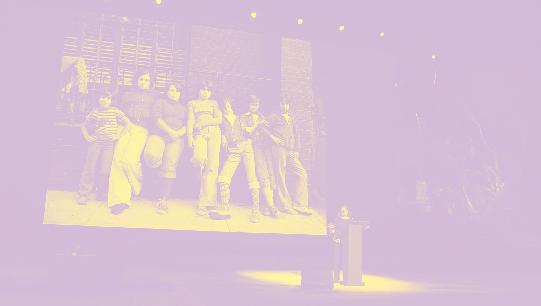
The Rencontres d’Arles is a nonprofit organization whose budget consists of 27% public funding, with 18% coming from private partners and 55% from receipts (principally ticket sales and derivatives).
Committee
Hubert Védrine, president
Françoise de Panafieu, vice-president
Marin Karmitz, treasurer (Constance Rivière, secretary)
Honorary Members
City of Arles
Patrick de Carolis, Mayor of Arles
Provence-Alpes-Côte d’Azur
Renaud Muselier, President of the Provence-Alpes-Côte d’Azur Regional Council
Bouches-du-Rhône Department
Martine Vassal, President of the Bouches-du-Rhône General Council
Ministry of Culture
François Quintin, Deputy Director for Visual Arts, General Direction of Creative Arts
Bénédicte Lefeuvre, Regional Director for Cultural Affairs, Provence-Alpes-Côte d’Azur
Institut français
Erol Ok, General Director
École Nationale Supérieure de la Photographie d’Arles
Marta Gili, Director
Centre des Monuments Nationaux
Philippe Belaval, President
Suitably qualified members of the board of directors
Maja Hoffmann, Françoise Nyssen, Florence Taddéi-Reckinger
Director
Christoph Wiesner assisted by Juliette Collomb
Deputy Director
Aurélie de Lanlay assisted by Marie Couteux
ADMINISTRATION
Administrator
Agnès Benichou
Administrative Officer
Lisa Studer
ARTISTIC PRODUCTION EXHIBITIONS
Exhibition
Production Manager
Caroline Courrioux
Cécile Nédélec by interim
Exhibition production
Amélie Samson
Annaëlle Veyrard assisted by Lucie Colleu, Armande Gallet, Clara Lassudrie-Duchêne
Management of the works
Samuel Da Costa
Exhibition design
Olivier Etcheverry assisted by Amanda Antunes and Diego Zavala Lizarraga
EDITORIAL PRODUCTION
Communication Manager and Evening Events Production Manager
Aurélien Valette assisted by Léa Drevon and Claire Pellé
Editorial content
Julia Chiron
Graphic design and publishing
ABM Studio
Nicolas Ledoux
Jean-Luc Lemaire
David Longuein with Carole Amrane
Fanny Bisiaux
Sophie Cornet and Manon Ferré assisted by Laurie Paolin
Website development
Timothée Rolin
App design and development
Art Book Magazine
Olivier Körner
Vincent Piccolo
Translation and proofreading
Sophie Beaulieu
Nino Dufour
Charlotte Faraday
Joséphine Gross
Sophie de Kayser
Elaine Krikorian
Bronwyn Mahoney
Glenn Naumovitz
Juliane Nivelt
Béatrice Pépin
OPENING WEEK
EVENING PROJECTIONS
Production
Laurent Perreau with Caroline Lepage
Opening week coordination
Juliette Riou
Simultaneous translation
ILO interprétariat et traduction, Anita Saxena and her team
MEDIATION EDUCATION
Education Unit Manager
Anne Fourès
Educational projects assistant
Magali Trinquier assisted by Natalia Chatzigianni
Photo Folio Review
Marie Andrieu assisted by Adèle Mègemont
Teacher seconded by the Ministry of Education
Elsa Acosta
WORKSHOPS
Director of photography workshops
Fabrice Courthial
Workshop administration and production
Loïc Colomb assisted by Lucille Bottier and Solenn Rouxel
Assistant supervisors for the summer workshops
Lena Besson, Cassandre Colas, Antoine Denoual, Lucie Kerzerho, Valentin Russo
SHOPS AND TICKETING
Director of visitor relations, ticketing and shops
Alice Charraix-Tullot
Camille Delalle by interim
Administration and ticketing
Geoffroy Meyer
Ticketing assistant
Françoise Miclot
Logistics assistants
Grégory Petillon
assisted by
Aïnhoa Piola-Urtizberea, Elorah Connil, Hanaé Galeron, Maxence Vincent and a team of 24 sales staff
VISITOR RECEPTION
Manager
Olivier Colladant and a team of 84 reception staff and SSIAP1 staff
Office, reception
Valérie Canavaggia
Maintenance
Aïcha Remal, Samira
Achahbar and their team
PRESS AND PROTOCOL
Press relations
Agence Claudine Colin
Communication
Claudine Colin
Anne-Sophie
Decronumbourg
Anne Monéger-Laval
Alexis Gregorat
Marine Maufras
du Chatellier
Cyril Bruckler
Protocol
Maud Denarnaud assisted by Valentine Victor, Clémence Dumarest and Hugo Rochette
Housing and transportation
Alice de Parscau assisted by Romane Philippon, Gwenaël Messire
Marine Tarabola and the team of drivers
ACCOUNTING
Head accountant
Anna Tetzlaff assisted by Alexia Chirouse
Head cashier
Chloé Bousquet
PATRONAGE AND PARTNERSHIPS
Partnerships
Caroline Brun
Juliette Collomb assisted by
Margaux Hannart and Lola Pagliai, Matthieu Prin and Walid Ghali
TECHNICAL
Technical Director
Antoine Cochain
General Manager
Patrice Falcot
Administration
Maxime Potigny
Teams of the Rencontres
d’Arles and service providers
Nawak and Ventilo, Idzia, Sud Side, Tchookar, Les 3 peintres.
Maintenance
Mathieu Hengeveld
Willy Brodbeck
Carpentry
Marine Lepeltier
Sophie Dones
Nicolas Barbera
Facundo Gastaldi
Frederic Valls
Exhibition set up
Franck Bilella
Emilio Cerda
Mario Bilella
Denis Brailleur
Mathieu Challier
Eric Escudier
Alexis Doussaint
Christophe Mineau
Victor Mineau
Nicolas Ternus
Painting Véronique Ferré
Russell Child
Pierre Mathon
Gaël Monnereau
Sarah Tourniaire
Antoine Muller
Sébastien Abot
Thomas Hunninghaus
Hadrien Durand
Emmanuelli
Baptiste Lacombe
Géraldine Blin
assisted by Emilie Ballif
Condition reports
Pierre-Emmanuel Nyeborg
Christine Sibran
Laura Quinonez Paredes
Riccardo Vecchiarelli
Guillaume Muller
assisted by Gaël Sillere, Louise Mutrel, Elsa Martinez
Drivers
Louis Perruchaud
Léo Aupetit
Hanging of works
Françoise Perronno
Cécile Peillon
Anne-Sophie Lemagny
Aurélie Jacquet
Quentin Carrière
Clémence Delabre
Marion Abeille assisted by Tal Yaron, Lexane Laplace, Marine Pistien, Juliette Sibran, Morgan Quirion
Wallpaper installation
Juliette Barat
Victor Jaget
Sonia Mondon
Sacha Ertel
Locksmithing
David Benifla
Eric Proust
Signage
Gael Rodier
Christophe Laure
Diego Maraboli
Audiovisual installations
Didier Herbert-Guillon
Thomas Josse
Vladimir Demoule
Benoît Camus
Lighting
Étienne Esnault
Valentin Pinoteau
Jean Marc Remal
Fabrice Valenza
Sylvain Arrighi
Handlers
Martin Houée
Lucas Martinet
Tomas Wirobnik
Runners
Alexandre Cassata
Remi Fernandez
Evening and event management
Pascal Letenneur
Vincent Butori
Christophe Laure and a team of 5 technicians
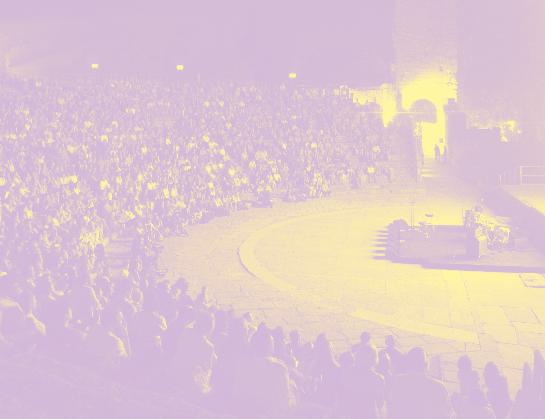
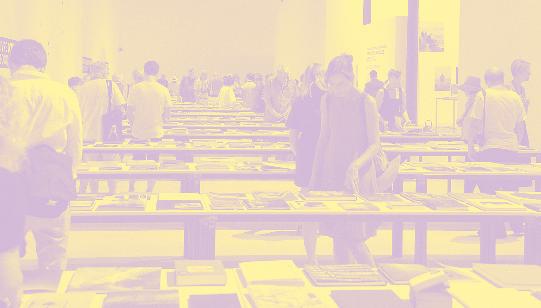
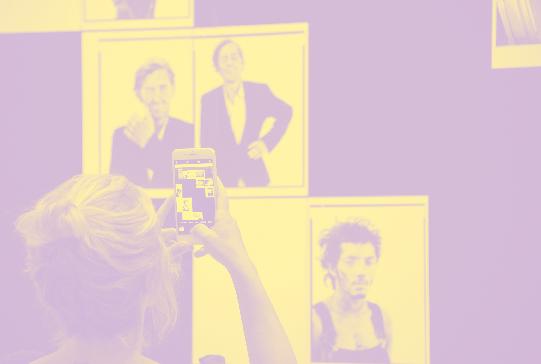
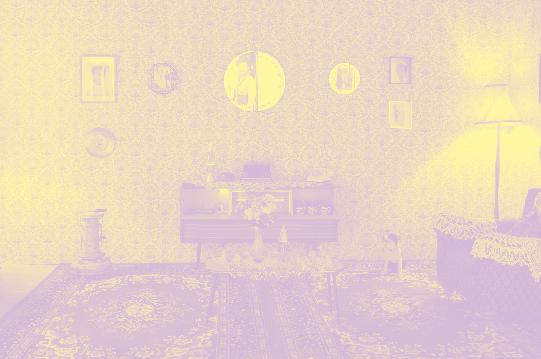
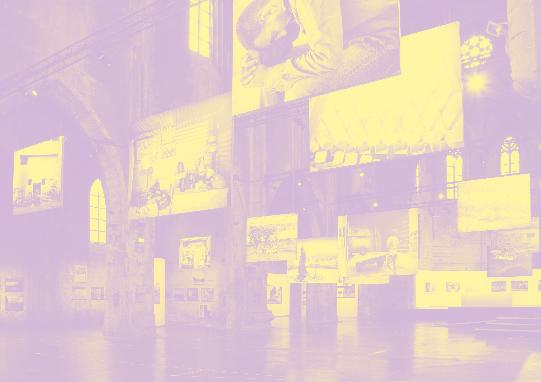
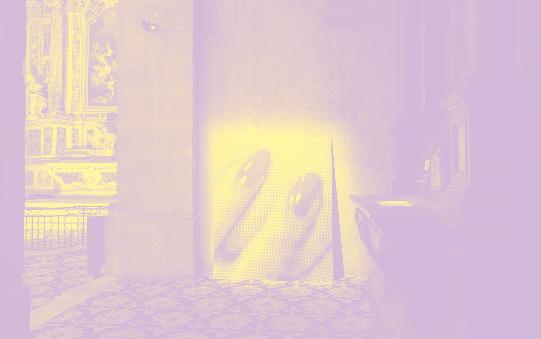
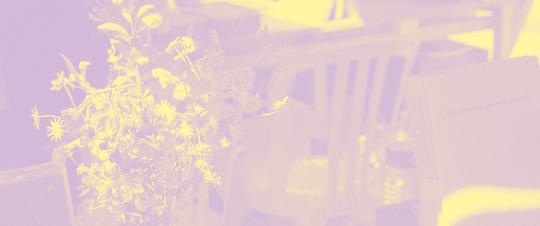

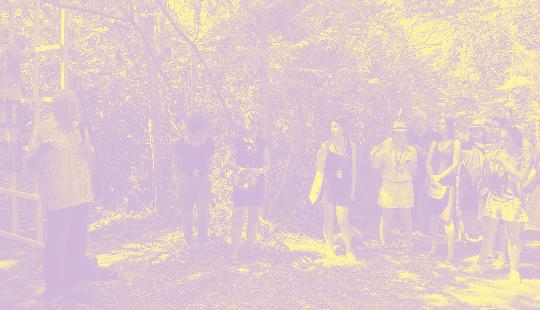
Photography credits for pages 1-4, 240-241, 280-281, 284-288 Anaïs Fournié, Rémy Tartanac, Aurore Valade.
Design ABM Studio.
Photoengraving Terre Neuve.
Book reproduced and printed by EBS, Verona, for Actes Sud, Le Méjan, place Nina Berberova, 13200 Arles.
© Actes Sud 2021/ Les Rencontres d’Arles 2021 for this edition.

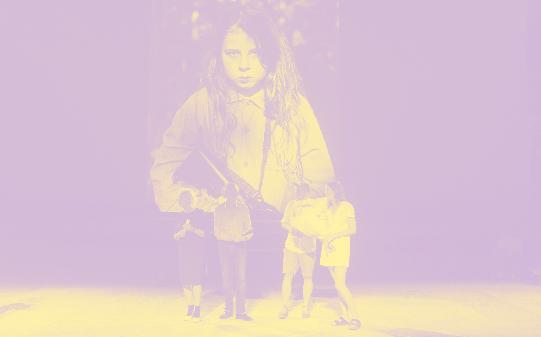
Legal deposit
July 2021.
Cover photo (detail) SMITH, Untitled, from the Desideration series, 2000–2021. Courtesy of the Galerie Les Filles du Calvaire.
